- Search Please fill out this field.
- Manage Your Subscription
- Give a Gift Subscription
- Newsletters
- Sweepstakes
- National Parks

The First U.S. National Park Is Still Iconic as Ever — How to Visit
Here’s everything you need to know before planning a trip to Yellowstone National Park.
- Planning Your Visit
How to Get There
- Best Time to Visit
Best Things to Do in the Park
Wildlife and natural features, places to stay, places to eat.
Daniel Ribar/Travel + Leisure
Yellowstone National Park, which straddles Wyoming, Montana, and Idaho, is Travel + Leisure readers’ favorite national park , and it was the most popular park in 2023 according to Google . So what’s all the fuss about? Well, it has otherworldly geothermal elements, is a treasure chest of iconic megafauna and elusive predators, and, frankly, is simply stunning.
You could spend years here and still find something new to be awestruck by. Unfortunately, many people who visit barely scratch the surface. T+L spoke to two Yellowstone experts, Daryl Hunter and Linda Veress, who want visitors to take a bigger bite out of the park. “I recommend people get out of their vehicles and walk around, go for a walk. So many people will just drive around and around. Even if it’s just a short walk around the boardwalk, being outside, experiencing the peace makes a huge difference,” Veress said.
“A mistake some people make is they go to the first puff of steam they see, and then they see it, and it’s okay, and then the second one, and it is okay. And then they’re tired of looking at okay springs, and they drive right by the good ones and miss them,” Hunter said.
We don’t want you to miss the good ones. Enter: this guide to Yellowstone National Park.
Meet the Experts
- Daryl Hunter has lived near Yellowstone since 1987, exploring every corner of the park as a wildlife and landscape photographer and interpretive guide.
- Linda Veress is a park spokesperson who has worked and lived in Yellowstone for ten years.
Planning Your Visit
Daniel Ribar/Travel + Leisure
You don’t need to reserve a spot for your vehicle to enter Yellowstone National Park. Just remember that if you’re coming in through the South Entrance, you’ll pass through Grand Teton National Park first. There are separate entrance fees for each park, ranging from $20.00 to $35.00.
That said, you'll need to book accommodations and campsites well in advance — Yellowstone gets packed fast. “It’s not a place that [visitors] want to show up and think that they’ll be able to get a place to stay at the last minute,” Veress said.
If everything is booked inside the park, no problem — there are gateway communities you can stay in. “The closest ones will be West Yellowstone and Gardener. Those are just outside the park entrances. Some people will drive in from Jackson or Cody, but those are farther away,” Veress said.
Once you’re in the park, plan your time wisely. “You can spend a big week out there. Most people spend about three days or so,” Hunter said. If you only have a few days, follow Hunter’s advice: “Do the lower loop the first day, the upper loop the second day. The upper loop has more wildlife and fewer thermal features, and the lower area has many thermal features.” He also recommends that if you’re that close, you might as well drive to Jackson Hole for a day and see Grand Teton .
Tamas-V/Getty Images
Yellowstone has five entrances. The year-round North Entrance and the Northeast Entrance are closest to the northern loop, Mammoth Hot Springs, and more wildlife; the West Entrance is excellent for seeing geysers; the East Entrance is on the lake; and the South Entrance is closest to Jackson. You’ll need a car if you’re not on a guided tour.
Consider flying into Bozeman, Montana , or Jackson, Wyoming. You can also fly into Salt Lake City or Idaho Falls. Car rentals are typically cheaper from Idaho Falls or Bozeman than from Jackson. You can even fly into Jackson, spend a few days there before heading to Yellowstone, and then drop off your car in Bozeman or vice versa.
Best Time to Visit
kwiktor/Getty Images
The best time to visit Yellowstone National Park varies depending on what you’re after. The summer season, typically from mid-April to the end of October, is ideal for traditional sightseeing, camping, and hiking. Most of the park’s roads are open during this time, allowing easy access to popular attractions.
To avoid crowds, consider visiting in May or June before Memorial Day or after Labor Day. These times offer a more peaceful experience with fewer visitors and better rates. Additionally, scheduling visits to popular areas like Old Faithful during early or late hours can help avoid peak crowds.
The park is quieter in the colder months, but has limited access. Only one road remains open year-round, so there are fewer opportunities for exploration unless you hop on a snowmobile tour. Access to the park’s interior is restricted to these guided tours. “You can stay at the snow lodge at Old Faithful and take ski trips. It’s a different way to see the park,” Veress said.
Visit Lower Geyser Basin.
To get a good sense of Yellowstone’s geothermal features, Hunter likes “everybody to see the Lower Geyser Basin , where the Fountain Paint Pot is. If you go to those two, you don’t have to go to other springs if you don’t have a lot of time.” The Fountain Paint Pot Trail is an easy half-mile trail.
See Grand Prismatic Spring.
Grand Prismatic Spring is an iconic sight in Yellowstone. The Grand Prismatic Overlook Trail allows you to see its shocking blue and orange colors from above, or you can follow the wooden walkway right next to it.
Ride a snowmobile or snowcoach.
If you visit Yellowstone in the winter , you have some exceptionally neat options to explore the park. Roads close, which limits your transportation to snowmobiles and snowcoaches — the only ways you’ll be able to see Old Faithful and Lower Falls. “If you don’t like being cold, you can take the snow coach. And make your reservations a long time ahead,” advised Hunter. Excursions sell out quickly.
Take a vintage car tour.
Hunter highlighted the unique experience of touring Yellowstone in vintage vehicles with retractable canvas roofs and panoramic windows. These historic yellow buses were initially introduced in the 1920s. Today, eight vintage White Motor Co. buses can show you the park in style.
Go for a ride.
“We have commercially guided outfitters that do either day or overnight horseback rides in the park,” Verress said. So, although no barns are actually in park bounds, you can still get in the saddle. For a truly memorable trip with another kind of ungulate, look into llama treks.
See Lower Yellowstone Falls.
Many people Hunter has taken on tours prefer this spectacular waterfall — in what’s dubbed the Grand Canyon of Yellowstone — to Old Faithful. “Lower Yellowstone Falls is a highlight for everybody,” he said.
Best Hikes
Yellowstone offers plenty of accessible flat and paved paths and boardwalks that can easily take up an entire day, but if you have the time and ability, definitely head out on a day hike. Hunter especially likes the 1.6-mile hike to Fairy Falls, which shares its trailhead with the path to Grand Prismatic Overlook. You can extend your journey to Spray and Imperial geysers if you're up for further adventure.
Storm Point Nature Trail takes you to a beautiful lake lookout (and a colony of yellow-bellied marmots). The kid-friendly Mystic Falls, Fairy Creek, and Little Firehole Loop is 3.5 miles and offers waterfalls and panoramic vistas of Biscuit Basin. The Lamar River Trail to Cache Creek takes you through meadows that become blanketed in wildflowers in June and July.
Yellowstone’s incredible wildlife is one of its main draws, the keystone species being majestic bison and elk, grizzly and black bears, and gray wolves.
The best time to catch a glimpse of grizzly bears and wolves is in the spring, particularly in northern regions like the Lamar Valley. “A good place to see black bears is in the vicinity of Tower Junction,” Hunter said. “There is a five-mile radius right around Tower Junction.” But you can also see them further south: “The Hayden Valley has gotten really good over the past 10 years,” he said.
If you’re eager to see bison, July and August are your best bets, especially in Hayden Valley where hundreds of bison will likely be roaming and causing traffic jams. “That’s the breeding season, and it’s a fun time to watch them because they’re all animated and looking for the ladies,” Hunter said.
Come September, during the rut — when male elk battle for dominance — early mornings come alive with elk bugling. Mammoth, Hayden Valley, and Madison Valley are great spots to see the show.
Courtesy of One&Only Resorts
Like anything, the best place to stay Yellowstone depends on your preferences, as luxury accommodations rub elbows with affordable lodges and campsites. Since Yellowstone is vast and involves significant driving, Veress recommends prioritizing where you stay based on what you want to see most. Different parts of the park offer distinct experiences, such as geothermal areas, wildlife viewing, and the lake area. For instance:
- Consider staying near Old Faithful or West Yellowstone for geothermal attractions and activities. “You can get some good lodging just on the border of Yellowstone and West Yellowstone, Montana, and Gardener, Montana,” said Hunter. “It’s usually easier to get reservations in those places, and you’re still right next to the park.
- For hiking and higher elevations, lodging near Cooke City might be preferable.
Old Faithful Inn
Many lodgings within Yellowstone are old-fashioned and antique in style but still wonderful because of their historical charm. Yellowstone’s in-park lodge, Old Faithful Inn , built in 1903, is right by the eponymous geyser and, according to Hunter, “a work of art.” He elaborates: “That’s a cool place to stay. Make sure that you get one of the rooms with the bathroom.” The older rooms don’t have ensuite bathrooms; you must go down the hall. But they’re still an incredible look at how things were in the early 1900s.
Lake Hotel and Cabins
Lake Hotel , constructed in 1895, is another charming historic venue. Its architecture resembles the colonial style commonly found on the East Coast during that era.
Glamping with Excursionist
For an incredibly luxe experience, Excursionist , a luxury tour operator, offers a private camp experience . They’ll build you and your travel mates a custom camp with flushing toilets, cozy comforters, and private naturalist-led tours.
One&Only Moonlight Basin
Located in Big Sky, Montana, One&Only Moonlight Basin is about an hour from Yellowstone. Although not within the park, it’s a more than acceptable luxury option when the in-park hotels inevitably book up a year before your planned trip.
Getting out into nature is what it’s all about, right? Yellowstone has 2,000 campsites across 12 campgrounds, plus endless backcountry sites. The best Yellowstone campsites for a night in the great outdoors include Mammoth Campground (the only campground open year-round); the seasonal Madison Campground , where you can see bison grazing and meadows blooming in spring and summer and elks in the fall; and Grant Village Campground , which is close to conveniences like a restaurant, gas station, and visitor center.
Yellowstone National Park’s dining options range from full-service restaurants in historic hotels like Mammoth Hotel and Old Faithful Inn to grab-and-go eateries. Bear Pit Lounge at Old Faithful Inn offers dining right by the iconic geyser.
Outside the park in West Yellowstone, try Madison Crossing ’s locally inspired menu, which includes bison nachos, trout cakes, and elk strip steak. Espresso West is a popular coffee cabin known for its simple setup and menu of morning staples.
Of course, you can’t beat a packed lunch picnic.

Yellowstone Itinerary Ideas from 1 to 5 Days (+Map & Planning Tips)
By Author Jurga
Posted on Last updated: March 29, 2024
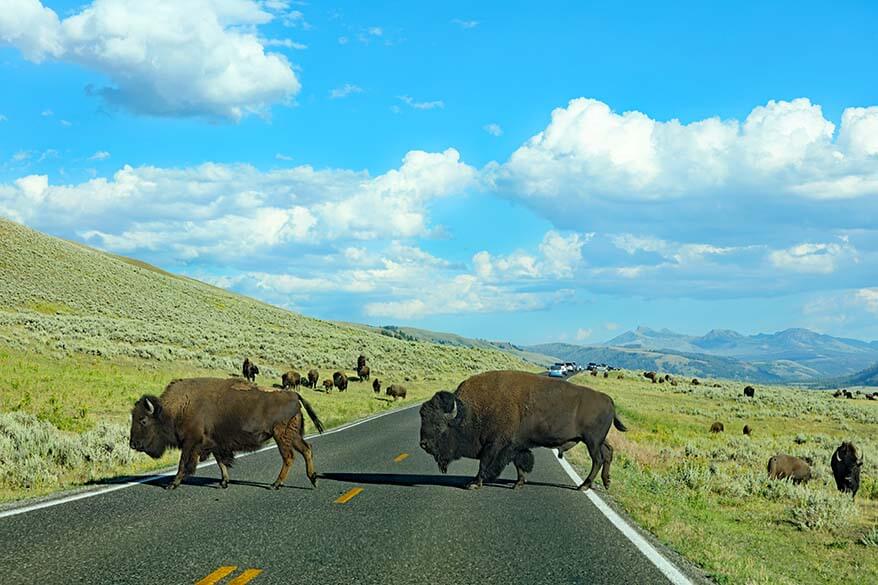
Planning a trip to Yellowstone National Park and wondering how much time you need to visit the park, how to plan your trip, or what’s the best Yellowstone itinerary for your vacation?
In this post, we share our experience-based advice for visiting Yellowstone National Park, essential tips for planning your trip, and a suggested Yellowstone itinerary for one to five days . Find out!
These planning tips, Yellowstone itinerary for 1, 2, 3, 4, or 5 days, and handy maps will help you get the most out of your trip to Yellowstone, no matter how much time you have.
Good to know: Note that these are all summer itineraries only (approx. mid-May to mid-October). That’s the period when all the roads are open and you can explore Yellowstone to the fullest. In winter, most of the roads in Yellowstone are closed and you can only visit the Old Faithful and the Mammoth Springs areas.
TIP: If you want to visit Yellowstone, but are overwhelmed with all the planning, you can also easily see the park with an organized tour. There are day trips or multi-day tours available. Here you can find our selection of the best Yellowstone tours .
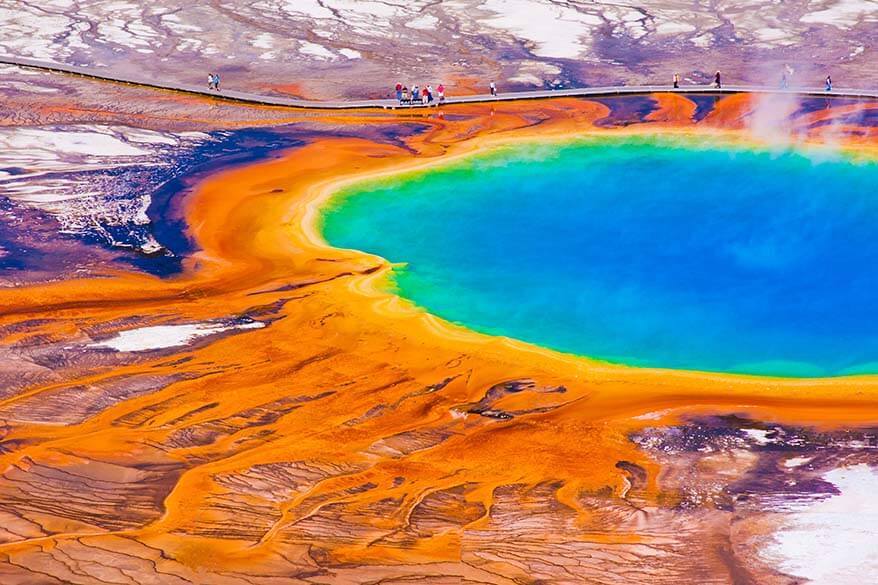
Below, you can find a detailed day-to-day itinerary for Yellowstone. I also included a map for each recommended Yellowstone trip itinerary. That way you have a better idea of where all those places are and how to best plan your time when visiting Yellowstone.
Of course, you don’t have to follow these itineraries precisely, but it gives you a good idea of the main landmarks and the time you need to see them.
TIP: You can jump straight to our Yellowstone trip itinerary suggestions . However, before going into the details of your Yellowstone itinerary and starting to plan your trip, there are some important things you should know! So I suggest that you read that information first. Take a look!
Yellowstone Itinerary & Trip Planning Tips – OVERVIEW
- Essential info – read before planning a trip to Yellowstone!
- How much time you need in Yellowstone?
- Entrance fee
- 1 day in Yellowstone
- 2 days in Yellowstone
- 3 days Yellowstone itinerary
- 4 days Yellowstone itinerary
- 5 days Yellowstone itinerary

Important Info for Planning a Trip to Yellowstone
ACCOMMODATION: Your Yellowstone itinerary will depend so much on the location of your accommodation. Price-quality-location-wise, West Yellowstone is one of the best places to stay near Yellowstone. You can also see what’s available in this area for your travel dates via the map below.
Alternatively, check our detailed guide to the best places to stay in and near Yellowstone via the links below.
READ MORE: Where to Stay In Yellowstone National Park Best Hotels & Cabins Near Yellowstone
TIP: Using the map below, you can find the best deals for your stay. Simply insert your travel dates and group size, and you’ll see all the best deals for accommodation near Yellowstone.
DRIVING DISTANCES & TRAFFIC: Don’t underestimate driving distances in Yellowstone. The park is big and the traffic is busy in summer. On top of that, you may experience delays due to road works and wildlife traffic jams. Furthermore, parking spots at the most popular landmarks are scarce, so you may need some extra time and patience.
Important!!! Please always check the official website for up-to-date information on any road closures or planned works in the park when planning your trip! Also, things can change before your trip, so it’s always a good idea to check it again a few days before your trip.
HOW TO ESCAPE THE CROWDS: All that being said, we visited Yellowstone end of July, the busiest season of the year. It was only busy around the most popular attractions. Actually, it’s quite easy to escape the crowds in Yellowstone if you want to – just go for a walk.
I read somewhere that around 80% of Yellowstone visitors never walk further than 10-15 minutes from their car. We could definitely confirm that from our experience. Don’t be one of those tourists! If you have some time to spare and are physically capable, make sure to make at least several short walks in Yellowstone.
Of course, you have to see the main landmarks and attractions of Yellowstone , but it’s those unplanned experiences, hidden gems, and unexpected encounters that will make your trip more memorable.
WHEN TO VISIT: If you are not sure when to go to Yellowstone, please check our guide for the best time to travel to Yellowstone . If you are planning to visit in the peak season, please check out our experience-based tips for visiting Yellowstone in July and in August .

How much time do you need in Yellowstone National Park
When I was researching our American road trip itinerary , I quickly realized that one or two days are simply not enough for visiting Yellowstone. Not only is Yellowstone the oldest National Park in the world, it’s also one of the biggest and most diverse National Parks we ever visited.
After thorough research, we decided to spend four full days in Yellowstone. It gave us just enough time to see all the main highlights without having to rush. We did quite some hiking, went for a swim, spent time driving the scenic loop road and looking for wildlife…
Yellowstone is so big and so diverse that you could easily spend a week or two here and never get bored. However, if you just want to see the main landmarks of Yellowstone, three or four days is enough. You can also see a lot with just a day or two, especially if you plan your time well and focus on the ‘musts’ – our itinerary suggestions below will help you do just that!
TIP: Don’t pack your days too much and leave some space for unexpected wildlife encounters, bison traffic jams, a beautiful hike, a soak in the warm river, etc. Yellowstone is so much more than just the most famous landmarks!
LEARN MORE: Tips for Your First Trip to Yellowstone
Yellowstone Entrance Fee
You’ll need an entrance pass for Yellowstone. It costs 35 USD per private vehicle and is valid for 7 days. You can buy it at any entrance gate of the park.
However, if you are visiting several National Parks in the same year, it’s better to get an annual National Parks Pass. It’s called America the Beautiful Pass and costs 80 USD for the whole family traveling in the same vehicle. It is valid in all National Parks and 2,000 federal recreation sites across the United States for one year from the month of purchase.
TIP: If you only visit for a day, you can also opt for this day tour that includes all the fees . Also this popular 4-day tour includes entrance fee, so you don’t have to worry about any of that.
And now that you know all the practicalities, below, you can find our Yellowstone itinerary suggestions. Take a look!

Here are our Yellowstone itinerary suggestions for any trip duration:
One Day in Yellowstone National Park
If you only have one day in Yellowstone visit the Old Faithful and the Upper Geyser Basin , Grand Prismatic Spring , and drive at least part of the scenic lower loop road .
If you are short on time when visiting Yellowstone, I suggest driving the lower loop passing the Grand Canyon of Yellowstone (stop by Artist Point), Hayden Valley, and Yellowstone Lake.
Below is a map indicating all the main landmarks that you should be able to see in Yellowstone in one day.
One Day Yellowstone Itinerary:
- Old Faithful & Upper Geyser Basin
- Grand Prismatic Spring
- Grand Prismatic Overlook Trail (optional)
- Grand Canyon of the Yellowstone
- Hayden Valley
- Yellowstone Lake
- West Thumb Geyser Basin
For more details and information for this Yellowstone itinerary, please see our 1-day itinerary via the link below.
READ MORE: One Day in Yellowstone
TIP: If you only have one day in Yellowstone, it might be wise to join an organized day trip rather than go on your own. Experienced local guides will make sure that you get the most out of your very short stay in Yellowstone. Here’s the best Yellowstone day tour (departing from Jackson Hole or Teton Village) that I was able to find. And here is a one-day tour from West Yellowstone .
Here is a map indicating all the best places that you should be able to see in Yellowstone in one day.
How to use this map: Use your computer mouse (or fingers) to zoom in or out. Click on the icons to get more information about each place. Click the arrow on the top left corner for the index. Click the star next to the map’s title to add it to your Google Maps account. To view the saved map on your smartphone or PC, open Google Maps, click the menu and go to ‘Your Places’/’Maps’. If you want to print the map or see it in a bigger window, click on ‘View larger map’ in the top right corner.

2 Days in Yellowstone
This is our suggested two day itinerary for the best of Yellowstone. Please note that to see all of this in just two days you will need to start really early and you won’t have much extra time to explore deeper.
This itinerary will make sure you get to see the very best of Yellowstone in 2 days. Take a look!
Two Days Yellowstone Itinerary:
Day 1: Old Faithful Geyser, Old Faithful Inn, and the Morning Glory Pool (Upper Geyser Basin). Grand Prismatic Spring. Norris Geyser Basin. Mammoth Hot Springs .
Day 2: Undine Falls and/or Wraith Falls. Lamar Valley. Tower Fall. Dunraven Pass. Yellowstone Grand Canyon. Hayden Valley. Mud Volcano. Yellowstone Lake. West Thumb Geyser Basin.
You can find our detailed 2-day Yellowstone itinerary and tips for your trip via the link below.
LEARN MORE: Two Days in Yellowstone
TIP: If you have 2 days in Yellowstone and want to see the very best of the park without having to do much planning, consider joining this highly-rated and very complete Yellowstone 2-day/1 night tour (departs from Jackson, WY).
Below is the map illustrating the 2-day itinerary suggestions for Yellowstone. The places indicated in red are described in the 1-day itinerary above, purple – day 2.
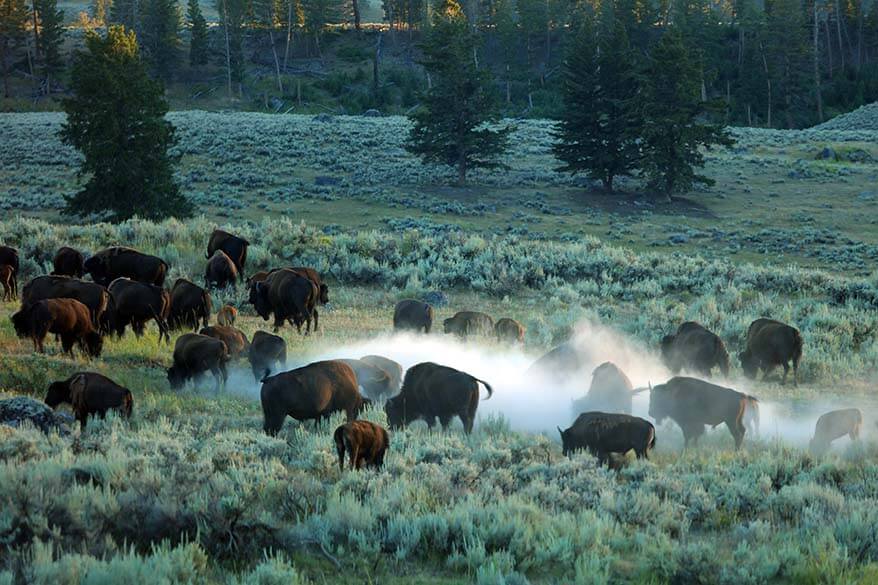
Yellowstone Itinerary for 3 Days
If you have three days in Yellowstone , you can explore all the main areas at a more relaxed pace. In addition, you’ll have some time for some lesser-known places that will make your Yellowstone trip even more special. Below is our suggested itinerary.
Three Days Yellowstone Itinerary:
Day 1: Old Faithful and the Geyser Loop Trail (don’t miss the Morning Glory Pool). Grand Prismatic. Norris Geyser Basin.
Day 2: Mammoth Hot Springs . Undine Falls. Wraith Falls. Petrified Tree (not a must). Lamar Valley. Tower Fall. Dunraven Pass.
Day 3: The Grand Canyon of Yellowstone River (Artist Point, Uncle Tom’s Trail, Lower Falls). Hayden Valley. Yellowstone Lake.
TIP: If you’d like to do some hiking in Yellowstone, on day 3, you could go hiking along the rims of the Yellowstone Canyon. There’s also a very highly-rated hiking tour with a local guide that you can join in this area.
This Yellowstone itinerary for three days includes pretty much all the main landmarks that you really have to see in the park.
Below is the map showing suggestions for things to see when visiting Yellowstone in 3 days. Places indicated in red are the ones described on day 1 of this itinerary, purple on day 2, and yellow – on day 3.
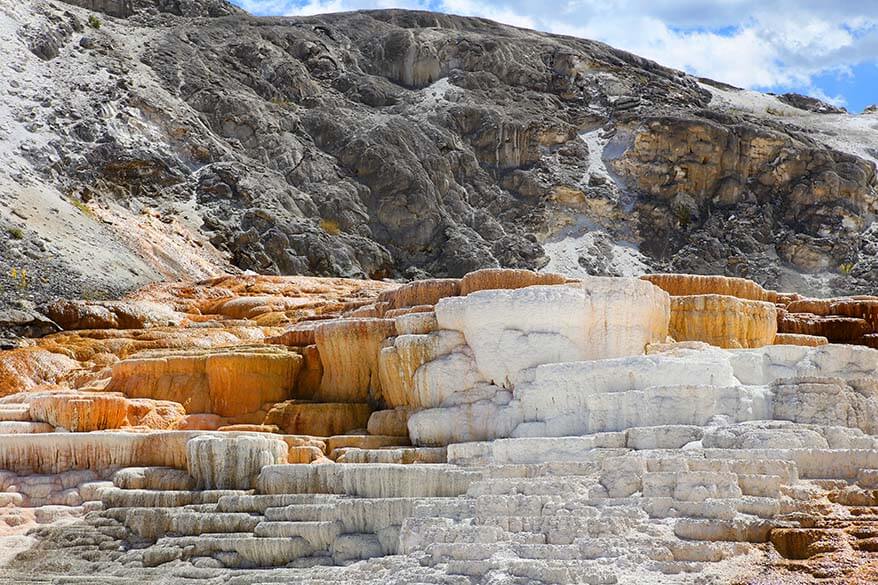
4 Days in Yellowstone
We stayed four full days in Yellowstone with kids , but our trip itinerary can be used by all types of Yellowstone visitors. More adventurous travelers might want to do a bit more hiking, but if you want to see all the main highlights of Yellowstone without having to rush – this is it .
Here is my suggested four-day itinerary for Yellowstone based on our experience. We visited the Grand Prismatic and the Old Faithful area at the end of our trip and I think it was a good decision. It’s often better to leave the most impressive places for last; that way you appreciate the rest more.
We also spread the visit of three thermal areas (West Thumb Basin, Norris Geyser Basin, and the Grand Prismatic/ Old Faithful areas) over separate days. That way you have more diversity every day. Otherwise, it’s easy to get ‘geysered out’ in Yellowstone :).
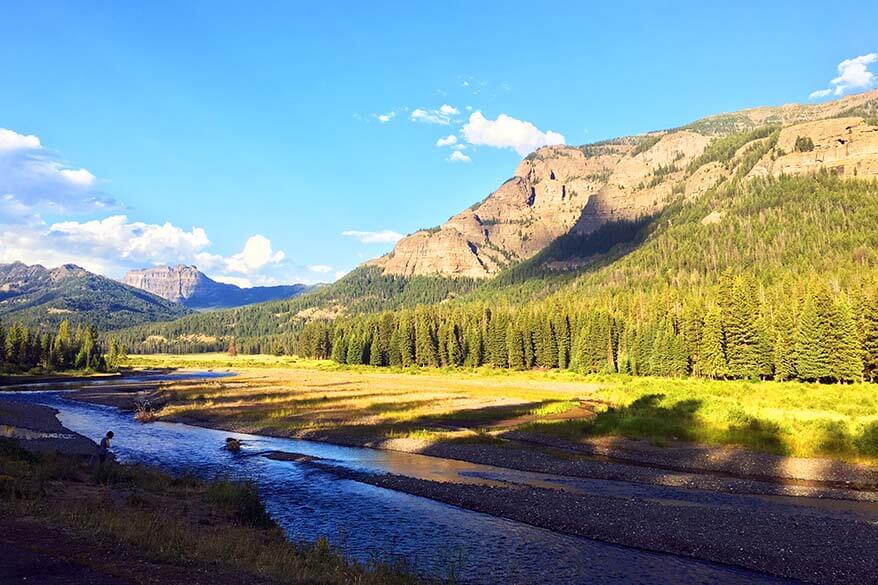
Four Days Yellowstone Itinerary:
Day 1: Lewis Falls. West Thumb Basin. Yellowstone Lake. Storm Point hike. Mud Volcano area. Hayden Valley.
Day 2: Grand Canyon of Yellowstone (Artist Point, Uncle Tom’s Trail, Lower Falls). Norris Geyser Basin. Firehole River (swimming).
Day 3: Mammoth Hot Springs. Undine Falls. Wraith Falls. Petrified Tree (optional). Lamar Valley. Tower Fall. Dunraven Pass.
Day 4: Midway Geyser Basin (Grand Prismatic). You can also hike to the Grand Prismatic Overlook. Lower Geyser Basin. Upper Geyser Basin (the Old Faithful Geyser, Old Faithful Inn, and the Geyser Loop Trail), also Biscuit Basin and/or Black Sand Basin.
TIP: If you are looking for the best guided tour option, check out this beautiful 4-day/ 3 night Yellowstone and Grand Teton trip with a focus on wildlife (departs from Jackson, WY).
Below is a map indicating each of the suggested places from our 4-day Yellowstone itinerary. Places indicated in red are the ones described on day 1 of this itinerary, purple – day 2, yellow – day 3, and green – day 4. The blue dots are the places that we mention in the 5-days Yellowstone itinerary further below.
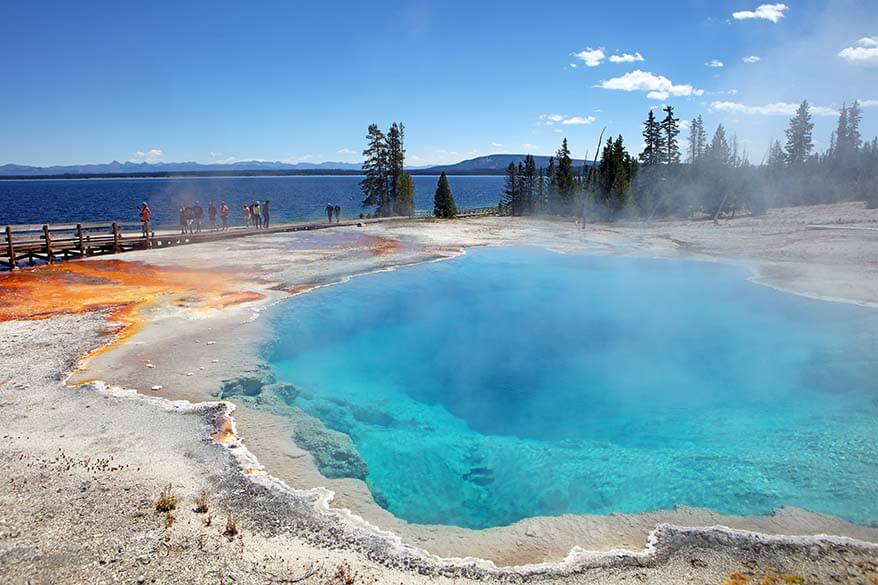
5 Days in Yellowstone
If you have five days in Yellowstone, make sure you see all the main landmarks and highlights described in the four-day Yellowstone itinerary. In addition, you could hike to Mount Washburn . It’s a long hike (6-7 miles (10-12km) depending on the route you choose) and requires a good part of the day.
Another nice option on foot or by bike is Lone Star Geyser . It’s located about 3 miles south of the Old Faithful area and can be reached via a hiking/biking trail from there. It erupts every 3 hours.
Otherwise, you can find plenty of other nice hikes, go for a boat ride on Yellowstone Lake, go for a scenic float or rafting nearby, join a hiking tour , etc.
Take a look at the map above (4 days in Yellowstone) – the blue dot next to Dunraven Pass is Mount Washburn, and the blue dot south of the Old Faithful is the Lone Star Geyser.
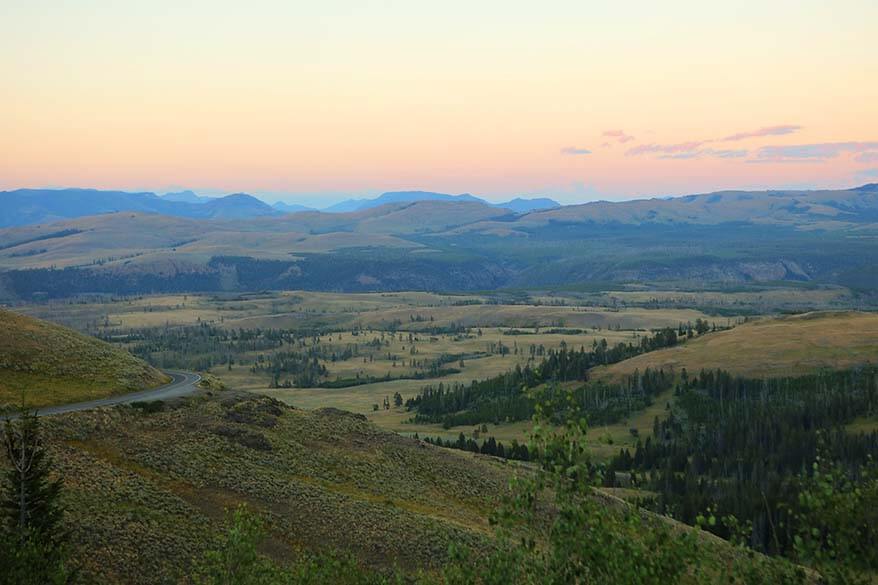
So, these are my suggestions for the best way to plan your Yellowstone trip and see the main landmarks of Yellowstone. None of these itineraries are very detailed as they would require separate articles, such as the ones for 1 and 2 days that we linked to above. So if you have any specific questions, feel free to leave a comment below and I’ll try to help.
Please note that every trip and itinerary will be somewhat different because so much depends on the location of your accommodation. We have lots of information and detailed guides for visiting Yellowstone , so please check those articles for more suggestions on how to plan your Yellowstone trip.
Update: Since so many of our readers asked for suggestions on how to best combine Yellowstone NP with Grand Teton NP, Glacier NP, and also with visiting Mount Rushmore, we have now published dedicated articles for those places. Take a look below!
- Here you can find info on the best places to see and things to do in Jackson Hole .
- Here you can read more about the best things to do in Grand Teton National Park in one day .
- Here you can find a suggested itinerary for both, Yellowstone and Grand Teton .
- Here you can find Glacier National Park itinerary suggestions .
- Here you can read more about visiting Mount Rushmore and things to do near Mt Rushmore .
Are you interested in a FREE booklet with TOP-10 must see places in Yellowstone?
Sign up for Full Suitcase newsletter and we will send it to you right away. You’ll get a .pdf file with 10 of our absolute favorite landmarks of Yellowstone and insider tips for visiting each of them.
Agree with Full Suitcase Privacy Policy
IMPORTANT! Please check your mailbox to confirm subscription. If you don’t see the email right away, please check Promotions and Spam folders.
More information for planning your trip to Yellowstone:
- Overview: Yellowstone Travel Guide
- What to see: Best Things to Do in Yellowstone
- When to go: Best Time to Visit Yellowstone
- What to pack: Yellowstone Packing List
- Accommodation: Where to Stay in and Near Yellowstone & Best Hotels Near Yellowstone
- For families: Yellowstone with Kids
- Must-see: Grand Prismatic Spring & Old Faithful Geyser
- Fun to do: Boiling River
If you found this post useful, don’t forget to bookmark it and share it with your friends. Are you on Pinterest? Pin these images!
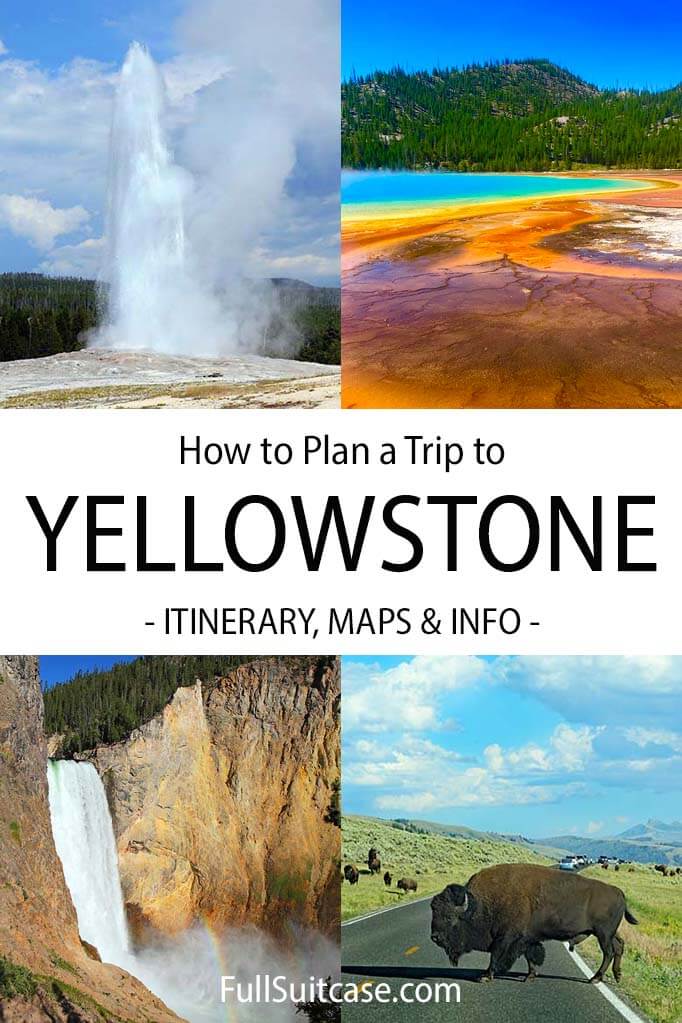
This site uses Akismet to reduce spam. Learn how your comment data is processed .
Tracy Hughes
Tuesday 17th of October 2023
What airport did you fly into? Also, how far was the drive from the airport to Canyon Lodge?
Wednesday 18th of October 2023
Hi Tracy, Yellowstone was just part of a much bigger road trip for us. We flew out of Salt Lake City after we left the park. That was like 6 hrs drive. But there are plenty of smaller airports nearby (1-3 hrs). You can find this information in our Yellowstone travel guide.
Tuesday 19th of September 2023
We just returned from Yellowstone and I wanted to thank you for all the information on your website. It was invaluable for our trip. We could have never seen this much without your tips. THANK YOU!
Thursday 21st of September 2023
Glad to help, Muryel.
Friday 11th of August 2023
Hi Jurga, I'm planning a camping trip to Yellowstone NP for my family in early Sept 2024. We'll be pulling a 30' camper. I like your 4-5 day Yellowstone itinerary and was wondering if you stayed at one particular camp site or did you move to different camp sites to cut drive times? Which one(s) would you recommend? Thank you so much for your help! Brent D.
Sunday 13th of August 2023
Hi Brent, we do not camp so we stayed at the hotels - Canyon Lodge most of the time, plus the Old Faithful Lodge for a night. You can find more info about Yellowstone campsites here.
Monday 24th of July 2023
hi jurga i am thinking to come in oct end and thinking where ot fly from NY and with best price in mind where to stay and how to plan for 4-6 days total .
Tuesday 25th of July 2023
Hi Claudia, first, keep in mind that most roads in Yellowstone close for the winter season on November 1. End of October can also already be quite cold and snowy, so you have to be prepared for some uncertainty. Check the official site for the road conditions and planned closures. For the rest, if you do indeed go in October, you should be able to visit most places as described in our itinerary suggestions, so please check our article for how you could plan your time. As for where to stay, many accommodations inside the park will also be already closed for the season. Only Mammoth Hotel and OF Snowlodge remain open somewhat longer in October, but also not the entire month. So the best places to stay are likely West Yellowstone and/or Gardiner. Please take a look at this article for more information on the best hotels near Yellowstone. Having said all this, if you can plan your trip somewhat earlier, even if just a few weeks, it will make a big difference. End of October is really the very end of the main season. Hope this helps. Have a great trip!
Sunday 14th of May 2023
We’re booked for 7 nights at Grizzly RV park in mid July. This will be our first trip to Yellowstone! We’re traveling in an RV with a tow vehicle, so we’ll have transportation for traveling around. Any thoughts? I’ve been looking at itineraries and it almost seems like we should have tried to stay in a couple of different places. We’re heading to Lava Hot Springs after that and making our way to Salt Lake City. Thanks!
Monday 15th of May 2023
Hi Mindy, this RV park is located in West Yellowstone which is really one of the best locations to stay for Yellowstone if you can't find a place inside the park. My best recommendations would be to focus on different area each day so that you can explore deeper and drive a bit less. But yes, it's quite inevitable that you will have to cover big distances on some days, for example, if driving to Lamar Valley. So yes, with a week, ideally, you would split your stay between several different areas in the park, but if you can't change your bookings anymore, just make the most of it. With good planning and early start (to avoid the long queues at the park entrance), you can see all the best places using West Yellowstone as your base location. Have a great trip!

PLANNING A TRIP TO YELLOWSTONE: The Only Guide You’ll Ever Need
Post Summary: Everything you need to know for planning a trip to Yellowstone. Advice on where to stay, when to go, and the best tips for an epic Yellowstone vacation.
Planning a trip to Yellowstone National Park can feel like a monumental undertaking. The sheer size of the park alone is enough to make any seasoned planner run for the hills. Before we took our big trip to Yellowstone, I spent a lot of time scouring through different books and sites to craft the perfect Yellowstone itinerary . To save you hours of reading through different Yellowstone travel guides, I created this Yellowstone trip planner so you can go to one place to find everything you need.
This guide on how to plan a trip to Yellowstone will cover:
-When to go to Yellowstone -Where to stay in Yellowstone -How to plan a Yellowstone trip itinerary -Must-see sights in Yellowstone -What to pack for Yellowstone -Getting to Yellowstone -Useful resources -Tips for visiting Yellowstone
RELATED POSTS: The Best Home Rentals in Yellowstone for every Budget The 10 Best Things to do in Yellowstone with Kids Everything you Need to Pack for a Trip to Yellowstone The Ultimate 4 Day Yellowstone Itinerary 10 Hidden Gems in Yellowstone
*This post may contain affiliate links, which means we might earn a small commission if you purchase from them. This is at no extra cost to you! We only recommend products and services we truly think are helpful.
Planning A Trip To Yellowstone
While it’s possible to wing a trip to Yellowstone, it’s not advised. The popularity of the park (over a million people visit a year) and its colossal size mean pre-planning a Yellowstone trip and itinerary is essential to maximizing your time there.
Here are the first two things you want to figure out when planning a trip to Yellowstone.
1. NEED TO KNOW When do you want to visit the park? How many days do you have to visit?
Best time to go to Yellowstone
In general, the best time to go to Yellowstone National Park is in the summer months of July and August. This is also the most crowded time of the year. The reason it’s often touted as the best time of year to visit Yellowstone is that the weather is nicer and, barring unforeseen closings, the entire park is accessible.
July and August weather averages in the mid 70’s Fahrenheit and drops down to the low 40s at night. That being said, the weather in Yellowstone can fluctuate quickly, so there’s always the chance of rain and thunder.
We visited in August, and while it was crowded at the park’s main sights, we never found it hard to find secluded, quiet spots. If you want to get away from crowds, it’s absolutely possible in the busy months. The summer months also have the advantage of being when large Bison herds congregate in the valley.
While July and August provide the best overall experience, let’s dive deeper into the best time to travel to Yellowstone since it will be different for everyone.

Visiting Yellowstone in the early Spring (March, April) This is one of the roughest times to visit because snowy, wet weather will cause muddy hiking trails, icy conditions, and multiple closures in the park. Due to Yellowstone’s high elevation, it will still feel like winter, and snow will be present. Most facilities like hotels, visitor centers, and campgrounds are closed. The upside is the park will be crowd-free, it’s a great time to spot wildlife (babies in particular), and the waterfalls will be gushing from ice melt. Visiting Yellowstone in the late Spring (May, June) If you’re set on visiting Yellowstone in the spring, the best time is May to June when more parts of the park will be accessible. A small number of concessions will start to open, wildflowers will begin to bloom, and wildlife sightings (bear cubs in particular) will be in full effect. Largely considered one of the best times to visit for its lack of crowds and the extraordinary opportunity for wildlife sightings.
Visiting Yellowstone in Fall (September-October) Early fall is a magical time in the park when the fall colors start to appear, and the elk are in rut. Crowds will have diminished, and some hotels and visitor centers will still be open. Most amenities will close by the end of October. With cooler weather ranging from the ’50-’70s, you won’t have to battle harsh winter conditions – although an early snowstorm is always a possibility in Yellowstone. It’s also a good time to spot bears since they come down to lower elevations to fatten up before hibernation.
Visiting Yellowstone in Winter (November – March) Visiting Yellowstone in winter can be a truly magical experience, but the effort it takes makes it best suited for adventurous types. Most roads will be closed by early November, with the exception of the road between Mammoth Hot Springs and the NE Entrance. Entering the park through the other entrances is only permitted via snowmobile, snow coach, snowshoe, and cross-country ski. You will need to find a snowmobile tour or get a special permit to enter the park . The only lodges open during the winter season are Old Faithful Snow Lodge and Mammoth Hot Springs Hotel.
Where To Stay in Yellowstone

Once you’ve decided when to go to Yellowstone, you can start to figure out where to stay in Yellowstone. Here’s where knowing more about what kind of Yellowstone itinerary you want will help you decide where to stay.
The reason? Yellowstone is gigantic. The main road of the park has the shape of the number 8. This road is called the GRAND LOOP . From the Grand Loop, there are five roads that offshoot to the five entrances of the park.
To give you a perspective, the time it would take you to drive the Grand Loop is estimated at 4-7 hours. That’s without any stops to see sights. The reason there’s a huge berth of time in the estimate is that wildlife traffic jams (from visitors stopping to look and from bison standing in the middle of the road), tourists looking for parking spots, and road closures often create hold-ups.
Staying at a hotel in the park
Since the park is huge, we highly suggest staying in the park to reduce driving time . That being said, if you choose to stay in Grant Village in the south and visit Mammoth Hot Springs in the North, it could mean five hours of driving that day! That’s why having a vague idea of your Yellowstone itinerary is important. Many people opt to stay in two different areas of the park during their visit to reduce driving time.
The most central location is to stay in the Canyon Area at Canyon Lodge & Cabins . A good option is to stay at Canyon Lodge and Old Faithful Inn , both of which are close to the park’s main highlights. Old Faithful Inn is a crowded spot, so if you’re looking for something a little more restorative and peaceful, I would also check out Lake Yellowstone Hotel and Cabins .
Lodging for all 9 Yellowstone Hotels can book out a year in advance, so you must book early. If you cannot secure lodging in the park, you’ll need to find somewhere else or wait till it’s closer to your desired dates and check every day for last-minute cancellations. You can look here for all other Yellowstone lodging options available in the park.
Camping in the park
Hotels in the park are expensive. There’s no way around it. To make it worse, the price doesn’t mean it’s an upscale experience. If paying $400 a night for an average to a below-average hotel room is out of the question for you, another option is to camp in the park.
We camped at Madison and Bridge Bay Campground to split up our time and loved it there. There are 12 front country campsites in the park, and most are first come-first served, except for Bridge Bay, Madison, Canyon, Fishing Bridge, and Grant Village. You can learn more about the campgrounds HERE .
Staying outside of the park
If neither of those options works for you, then your next option is to stay in a vacation rental or hotel near one of the five entrances to the park. If you choose that option, remember that the drive from the park entrance to the park’s main road can be up to an hour long, depending on which entrance you use. Staying outside of the park will mean a lot of driving time.
I’ll break down the different entrances below, along with lodging recommendations for each entrance.
If you’re interested in staying in a home rental, you can check our post on the best vacation rentals in Yellowstone for every budget.
Entrances to Yellowstone

Here’s a breakdown of the five different entrances to Yellowstone. We’ll look at which Yellowstone entrance is the best and the cities you could find lodging in for each entrance.
West Yellowstone Entrance Driving Distance and Time from Entrance to Grand Loop: 14 miles, 45 minutes This is the most popular entrance and the best choice if staying outside of the park. Located in West Yellowstone, MT, it has plenty of restaurants, grocery stores, and gas stations. Burnt Hole Cabin is a 2-bedroom home rental right near the entrance and within walking distance of restaurants. For a more conventional hotel stay, The Kelly Inn, is an affordable choice with free breakfast and comfortable beds, and is within one mile of the entrance. If you’re willing to drive more, the VRBOs in Island Park, Idaho , are about 25 minutes away from the entrance but tend to be nicer.
North Entrance Driving Distance and Time from Entrance to Grand Loop: 5 miles, 15 minutes Gardiner, MT, is the closest town just outside of the entrance and is a good location for visiting the Lamar Valley, Mammoth Hot Springs, and the Boiling River. It’s further from areas like Old Faithful and West Thumb Geyser Basin, but doable if you don’t mind a long drive. Gardiner is a cute, small town with grocery stores, a small selection of restaurants, and gas stations.
The Arch View Studio is a nice, simple guest house on VRBO for two people that offers all the same amenities as a hotel but is bigger and cheaper. If traveling with a family, the Gardiner Home is a beautiful home rental with a deck overlooking the Yellowstone River. I also love the look of this chic two-bedroom house rental with a loft.
If you prefer a hotel over a house rental, the Park Hotel Yellowstone is a well-rated hotel with clean, comfortable rooms.
Northeast Entrance Driving Distance and Time from Entrance to Grand Loop: 29 miles, 1 hour The closest city to this entrance is the tiny city of Cooke City, MT. With a population of just over 100 people, it offers a grocery store, restaurants, and a gas station. It’s a great entrance for access to the Lamar Valley; however, it is far from everything else in the park.
I would suggest staying near this entrance only if you are passionate about animal watching and want to be as close as possible to the Lamar Valley so you can get there before sunrise. The Mountain Lux Guest House is a beautiful home with a hot tub and sauna to enjoy after visiting the park.
East Entrance Driving Distance and Time from Entrance to Grand Loop: 27 miles, 1 hour The closest city to the entrance is Cody, Wyoming. We don’t suggest staying here simply because it’s 53 miles from the entrance to the park. That means it will take you around two hours to get to the Grand Loop of Yellowstone. While Cody, Wyoming, is a cute town with some interesting sights, its distance makes it tough for anyone looking to go in and out of the park every day.
South Entrance Driving Distance and Time from Entrance to Grand Loop: 22 miles, 45 minutes The south entrance is the gateway to Grand Teton National Park. While 10 miles is all that separates the two parks, there is only one lodging choice, the Headwaters Lodge and Cabins . Otherwise, you would need to drive 55 miles through Grand Teton National Park to lodge in the cute city of Jackson, Wyoming. Because of traffic and length, staying outside the South entrance is generally not recommended for anyone looking to visit the park every day.
Making a Yellowstone Trip Itinerary
When planning a trip to Yellowstone, your itinerary is vital to helping you create an amazing trip. Here are some key things to think about when planning a Yellowstone itinerary.
2. NEED TO KNOW What parts of the park do you want to see? How many days do you want to visit?
How many days do you need to visit Yellowstone National Park?
Figuring out how many days you need to visit Yellowstone is dependent on how deep you want to explore the park.
Three days at Yellowstone is enough to allow you to see all the park’s main highlights.
Four days at Yellowstone allows you to see all the main highlights, with an additional day to go hiking or explore more features of the park.
(RECOMMENDED) Five to Seven days at Yellowstone is for anyone who is looking to explore all the main highlights with extra time for hiking, fishing, or relaxing in the beauty of the park.
Not everyone has 5-7 days at their disposal, so if you want to get the main highlights, we suggest doing four days in the park. If you notice, we don’t suggest one or two days in Yellowstone. With traffic, parking, and crowds, it would make for a stressful and rushed time at the park. Do people do it? Of course. If you only have one day in the park, focus on doing two or three main highlights to enjoy your time there fully.
In general, it’s best to visit a section of the park each day to maximize your time there.
Best things to do in Yellowstone

Now that you have an idea of how many days you want to spend in Yellowstone, it’s time to plan out an itinerary. The best way to start planning a trip to Yellowstone is to familiarize yourself with the must-see spots and their location in the park. From there, you can plan out an itinerary from there.
We have an entire post with an in-depth four day Yellowstone itinerary . Check it out to get a day-by-day breakdown of what to do, advice on where to stay, as well as inspiration for your trip.
Here are the main highlights in Yellowstone that are considered must-dos when visiting the park.
1. Old Faithful Geyser 2. Mammoth Hot Springs 3. Grand Prismatic Spring + Midway Geyser Basin 4. The Grand Canyon of Yellowstone 5. Wildlife Viewing in Lamar Valley and/or Hayden Valley
Here are secondary highlights for those who have time and want to dive deeper into the park’s geothermal features.
1. Upper Geyser Basin and Morning Glory Pool 2. West Thumb Geyser Basin 3. Norris Geyser Basin 4. Yellowstone Lake 5. Boiling River
And then, of course, there are hiking trails, fishing spots, and lesser-known off-the-beaten-path spots in Yellowstone . Be sure to check out our Yellowstone itinerary post to get the full rundown.
What to pack for Yellowstone

A Yellowstone packing list is dependent on what time of year you will be visiting. This shortlist is intended for June to September travel. While the weather will be nice (especially in July and August), you’ll want to be prepared for sudden shifts in weather. Also, due to the high elevation, nights can and will be cold. We visited in late August and experienced beautiful warm weather and bursts of torrential rain and thunder, with nighttime and early morning temps in the upper 20s Fahrenheit. A week after we left, a snowstorm came through, and the park was coated in snow. Anything is possible in Yellowstone! Pack clothing you can layer up.
For an in-depth look at what to pack for Yellowstone, as well as where to get the supplies, check out our Yellowstone packing list post .
1. Bear Spray 2. Water shoes 3. Rain jacket 4. Comfortable walking shoes 5. Hiking boots 6. Binoculars 7. Sunhat 8. Sunblock 9. Bug repellant 10. Backpack 11. Trash bags 12. Reusable water bottle 13. Quick dry towel 14. Picnic blanket 15. Flashlights or headlamp 16. Clothing layers 17. Camera + Go Pro
Getting to Yellowstone
There are quite a few airports to choose from, but most are small airports with higher prices. The closest airports are Jackson Hole Airport, located in Jackson, WY, and Yellowstone Regional Airport, located in Cody, WY.
You can also look into the following cities to see if they offer cheaper options:
- -Billings Logan Internation Airport in Billings, MT
- -Bozeman Yellowstone International Airport in Bozeman, MT
- -Idaho Falls Regional Airport in Idaho Falls, ID
If all those choices are too pricy, many people opt to fly to Salt Lake City International airport due to easier and cheaper flight options. The drive from Salt Lake City is about five hours to the West Yellowstone entrance.
No matter where you fly, you will have to rent a car since there is no shuttle service within the park. You can check Rentalcars.com to see current car rental prices. Rentalcar.com is an aggregator that compares rental prices from different providers.
Entrance Fees to Yellowstone
Entrance fees are per vehicle and are $35. The pass is good for seven days from the date of purchase. You can save some time by purchasing your vehicle pass before you arrive.
If you plan to visit Grand Teton National Park during your Yellowstone trip and any other National Parks or federal lands in the same year you visit Yellowstone park, you might want to consider buying an America the Beautiful Pass . Good for one year, the pass gives you entrance to every National Park and more than 2000 federal recreation sites. A fantastic choice that can save a lot of money if you have additional National Park travel plans. You can learn more and buy the annual pass HERE.
Useful Resources and Tips for Planning a Trip to Yellowstone

Is Yellowstone a good park to visit with kids or toddlers? Yes! We visited the park with our three-year-old, and he loved it. Yellowstone is a fabulous place for kids. If you want help with your Yellowstone family vacation planning, you can read our entire post on visiting Yellowstone with kids and the best things to do with them.
How is the internet and cell service? Barely existent. While there may be spots where you can get a patch of service, it’s not something to rely on. I have T-Mobile, and my husband has AT&T, and neither one of us was able to connect. The park claims to have hot spots you can jump onto, but those were pretty unreliable. Be happy if you do get it, but don’t expect it.
If there’s no cell service, how do I figure out directions? I’m so reliant on GPS! I know. Me too. First off, the park is very easy to drive in, and everything is clearly marked. That being said, we can’t recommend enough downloading the Yellowstone National Park app that has offline directions and maps to all of the sights in the park. We found it really helpful when looking for trailheads and picnic areas. It also has a wealth of other amazing information that is good to have. It offers education about what all the geothermal features are and fun facts about the park. Download it BEFORE you get there. You can also get a Yellowstone map from the visitor centers.
What’s the food situation in Yellowstone? Cafeterias, restaurants, ice cream stands, and grocery stores are available in all the park’s main sections. All are located close to the hotel lodges or inside the hotel. You can see a full list of dining options here . As is to be expected, food prices are higher than what you would pay outside of the park.
If you’re looking to save, you can bring your own food in and picnic in various areas around the park. Just remember to dispose of all food in a bear-proof trash can or take it with you to dispose of later if none are available.
Are there gas stations in Yellowstone? Yes, gas stations can be found in Canyon Village, Fishing Bridge, Grant Village, Mammoth Hot Springs, Old Faithful, and Tower Junction.
I’m overwhelmed. Can I just go on a tour and have someone be my personal Yellowstone vacation planner? Yes! We have never personally done a tour, so we can’t recommend any to choose from. But, what you can do is look through the tour service Viator to see if they have any that appeal to you. Viator is owned by TripAdvisor and has the same system where they collect reviews. It’s a great way to see what’s out there and if it’s highly rated.
Is a bear going to eat me? Ahh, those cute but enormous bears. While the likelihood of you getting attacked by a bear is very unlikely, practicing bear safety and following all rules set by the National Park Service is vital to keeping not only you safe but the bears safe as well. To further my point of how unlikely it is, since the park’s establishment in 1872, eight people have been killed by bears in the park. You can read more about your likelihood of getting attacked by a bear HERE .
The best way to keep yourself and the animals safe is to hike in groups of three or more, to make noise while you hike, and to keep your senses aware (no listening to headphones). Also, have bear spray with you and know how to use it. We use this bear spray brand and so far have never had to use it!
Lastly, never touch, approach, or feed any animals in the park and stay at least 100 yards away from wolves and bears and at least 25 yards away from all other animals, including elk and bison. Most animal-related injuries are from visitors not following these simple guidelines.
You can read more about safety in the park HERE .
Should I visit Grand Teton National Park while I’m at Yellowstone? Any other spots to visit? Yes! If you have time, a day or two at Grand Teton NP and exploring Jenny Lake is a great way to see a completely different park. If you really want to collect some national park passport stamps , make a long road trip out of it and head North to Glacier National Park. If you want a break from the National Parks, you can also spend a few days in the fun and hip city of Jackson, Wyoming.
Okay, I’m getting excited. Anything else I should know? Yes, that old saying about the early bird catching the worm? It applies to Yellowstone! Get yourself up before sunrise and start your day early. Seeing Yellowstone uncrowded with the hot springs letting off a cloud of steam is pure magic. Get up early and beat the crowds. You won’t regret it.
Also, give yourself a lot of time for everything. Traffic and road closures are very commonplace. We dealt with a fire, an overturned fuel truck, traffic jams from drivers looking at bison, and routine road maintenance. It’s part of the package that comes with Yellowstone. Give yourself a buffer and go with it.
Here’s a recap and checklist for planning a trip to Yellowstone.
1. Decide when you want to visit the park 2. How many days do you want to stay in the park 3. What sights are on your must-do list 4. Sketch out a simple itinerary for hotel planning 5. Book lodging 6. Buy necessary items for your trip 7. Download Yellowstone App 8. Count the days till you’re in Yellowstone!
You’re ready to start planning a trip to Yellowstone! Let me know if I missed anything and if you have any questions in the comments below.
PIN IT FOR LATER

READ NEXT: 11 Amazing National Parks in the East 160 Questions for your next Road Trip The Ultimate Road Trip Food List
Hi, we’re Christina and Brad, Idaho based writers and photographers who live to explore. We did a short stint of traveling full time with our two year old and discovered we're much happier as part time nomads. What does that mean? We travel a lot! And then we go home. We love helping fellow parents and everyday adventurers discover new places and experiences.
Similar Posts

THE ULTIMATE YELLOWSTONE PACKING LIST

Family Explorer’s Guide: The Best National Parks for Kids

Uncovering The 17 Most Spectacular National Parks In The West

THE BEST CABIN RENTALS NEAR YELLOWSTONE FOR EVERY BUDGET

JOSHUA TREE WITH KIDS: THE ULTIMATE ADVENTURE GUIDE

A Family Guide to Shenandoah National Park With Kids
One comment.
It’s great that you elaborated on the importance of planning to make the most out of your time. My aunt mentioned last night that she was arranging a tour for her birthday and asked if I had any suggestions for where we should go. Thanks to this educational article, I’ll be sure to advise her that we should think about doing a Yellowstone private trip because it will provide us with wonderful memories.
Leave a Reply Cancel reply
Your email address will not be published. Required fields are marked *
The complete guide to Yellowstone National Park
Apr 15, 2021 • 19 min read
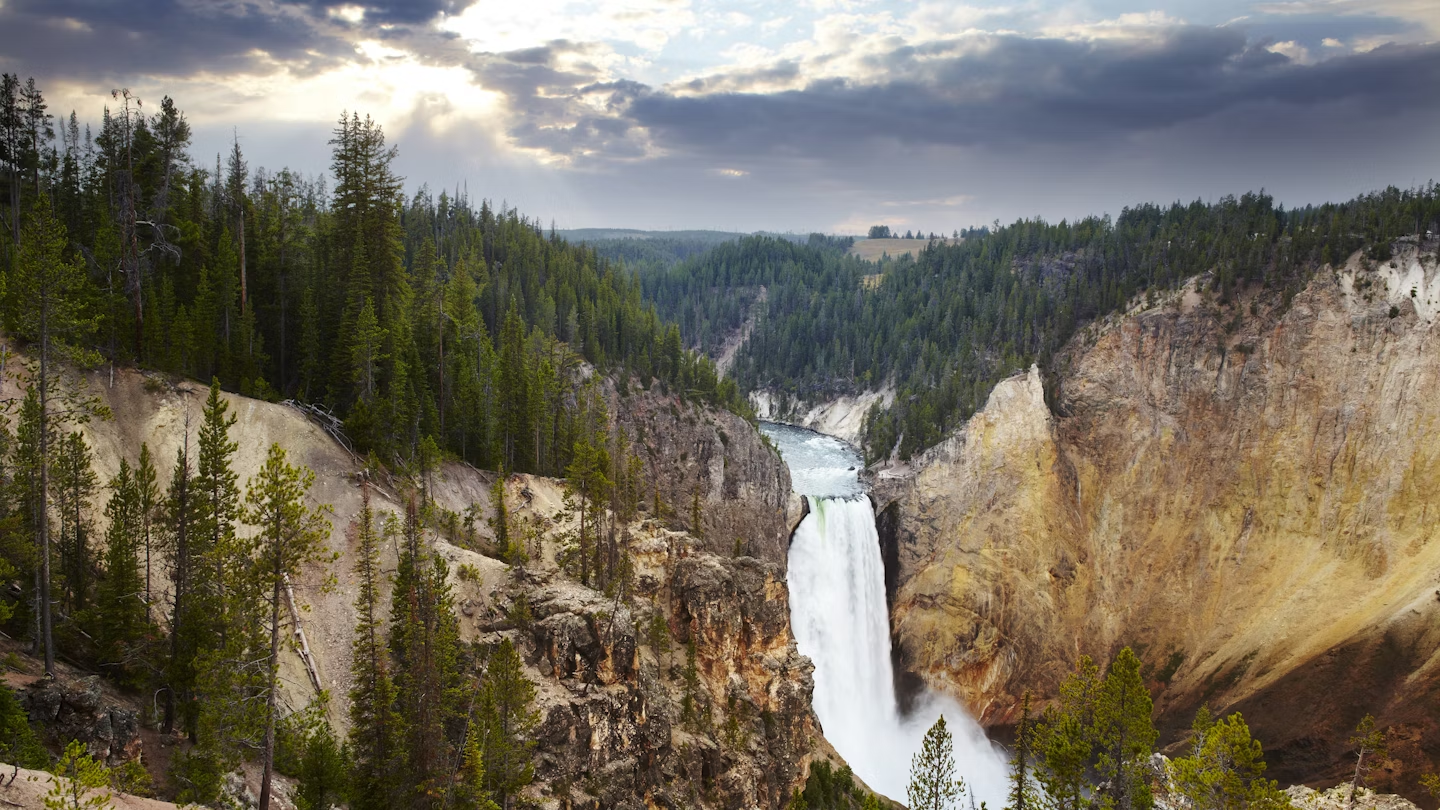
Yellowstone National Park is the rare destination that lives up to its own mythology ©Matt Munro/Lonely Planet
This place was named not by the French fur trappers who wandered through in the late 1700s looking for pelts or by John Colter – the member of the famous Lewis and Clark Expedition who struck off on his own and stumbled across a place so uncanny his reports of what he saw were dismissed as pure fantasy. Yellowstone was named by the Indigenous Hidatsa people whose phrase Mi tsi a-da-zi called attention to the unusual hue of the stones lining the Yellow Rock River.
For thousands of years, Yellowstone's unique landscape has changed in ways both dramatic and minute. It's also continued to attract visitors, whether they're the ancestors of the Hidatsa following winter game, colonial-era settlers, or vacationing families on a classic summer road trip. There's certainly no bad time to visit Yellowstone. Open ten months out of the year, there's something new to experience in any season. And while some elements like wildlife and weather can be unpredictable, one thing is for sure. Whether you're visiting for the very first time or you've come back again and again over the years, you're in for a treat whenever you set foot in the park.

From strolling the Upper Geyser Basin boardwalk to see famous spouts like Old Faithful or making your way through the mist around Grand Prismatic Spring to enjoying a winter safari through the Lamar Valley and cross-country skiing to Lone Star Geyser, there's a little something for everyone.
Here's what you need to know to start planning your trip – and for more detail pick up a copy of the Lonely Planet Yellowstone and Grand Teton National Parks travel guide and Yellowstone National Park Planning Map.
Editor's note: Due to the COVID-19 pandemic, Yellowstone National Park began a phased reopening on June 1. Services and facilities will remain limited through 2020. Check the national park website for the latest info.

About Yellowstone National Park
Millions of years ago, this was a fairly ordinary swath of rivers, mountains, and grassy valleys. But then a geologic hot spit that once sat underneath what is now Idaho's Craters of the Moon National Monument shifted to the northeast where the Rocky Mountains meet the Snake River Plain. A long, slow drift to the confluence of what is now Wyoming, Montana, and Idaho and one cataclysmic eruption later, the place we now know as Yellowstone was born – including its famous geysers, hot springs, and travertine falls.
Since then, Yellowstone's living, breathing landscape continues to evolve. Beneath the boardwalks tourists criss-cross to see the park's thermal features, under the rolling rivers and the paws of bears and wolves is a vast super caldera, the mouth of a series of massive eruptions, the last of which occurred as recently as 630,000 years ago. The park's colorful, superheated paintpots, springs, and boiling rivers are the product of ongoing volcanic activity underneath a thin layer of the earth's crust, while its dramatic canyons reveal where the Yellowstone River has carved through millennia of hardened lava flows that have built up stunning basalt cliffs and ridges.
The Indigenous tribes who wintered in Yellowstone specialized obsidian tools made from all that abundant volcanic material endemic to the area. These arrow and spear points were so highly prized that they have been found in archeological sites far east of the Mississippi, working their way down long, well-established trade routes between tribes. Despite the unique landforms and abundance of resources, however, Yellowstone didn't attract serious interest from white colonizers until after the Civil War, when the Cook-Folsom-Peterson Expedition arrived in 1869.
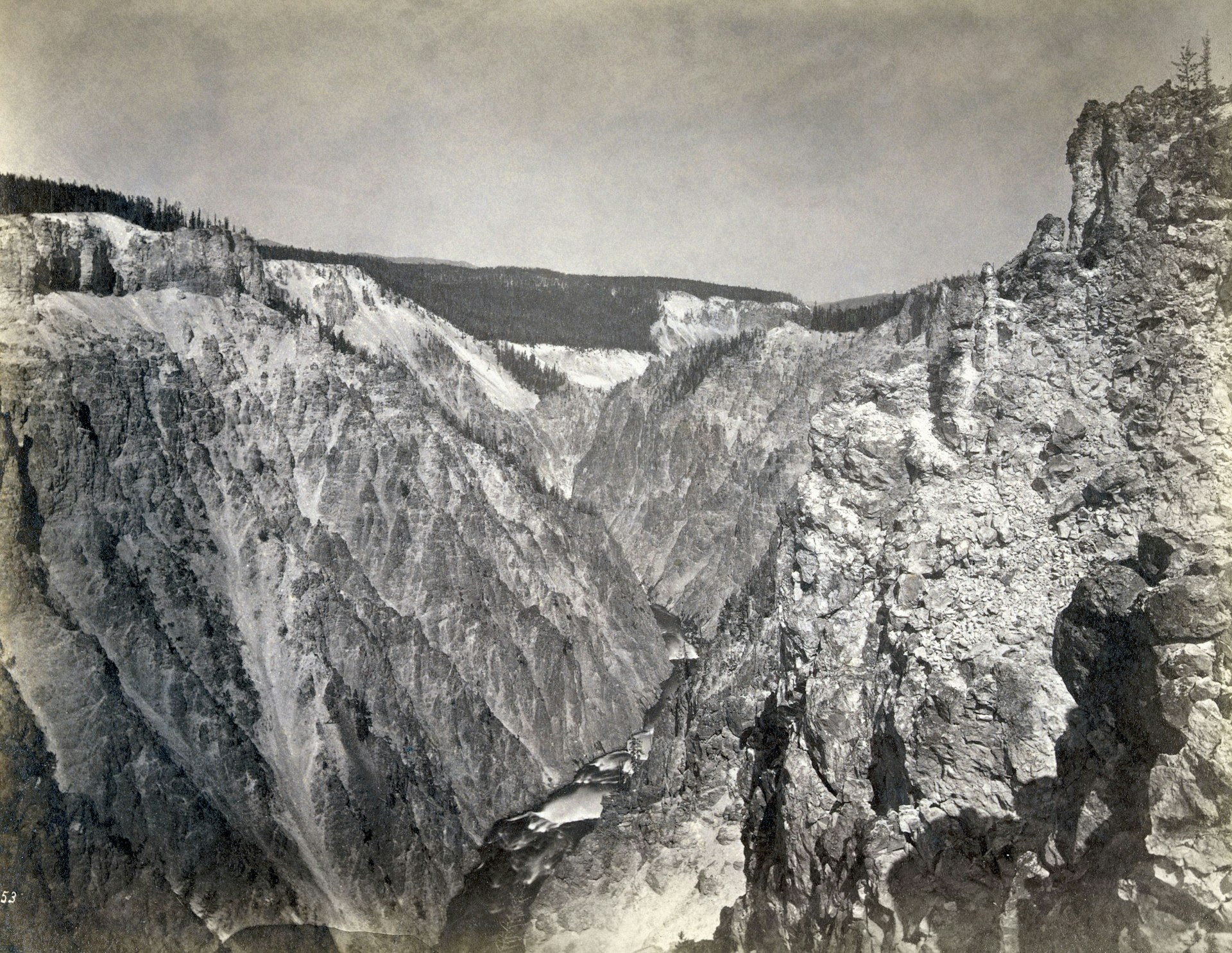
Unlike previous visitors from back east, whose accounts were taken as the stuff of myth, fantasy, and salesmanship, the Folsom party's accounts of what they saw in Yellowstone were taken seriously, backed up by maps and detailed surveying notes. It didn't take long for colonial settlers who'd arrived in the region on the heels of so-called Indian Removal to begin advocating for preserving the area, rather than opening it up to private developers for logging and mining.
Those recommendations were quick to reach the U.S. government in Washington D.C. By 1872, photographs and paintings by artists like Thomas Moran were amazing the public back east and won over not only the populace, but politicians, too. President Ulysses S. Grant made Yellowstone the country's first national park that year expressly "for the benefit and enjoyment of the people" – a surprising choice in a rapidly industrializing nation that often saw wilderness not as a playground, but a resource to exploit.

The decision to establish Yellowstone as a national park had stunning implications, and arguably ushered in the first real era of American tourism and outdoor recreation. Wealthy visitors made the long journey to Wyoming territory on brand new rail lines and stayed in luxurious lodges, touring Yellowstone in bright yellow stage coaches. Eventually, America's growing middle class followed in the first automobiles and RVs , eager to see the mythic American west for themselves.
The creation of Yellowstone also gave rise to the whole National Parks Service when further lands like Yosemite and Sequoia were designated as national parks nearly 20 years later. Park rangers, too, were a new invention descended from a post-Civil War military in need of a new assignment. Soldiers who'd once served on the front lines against the Confederacy found themselves defending Yellowstone from vandals and outlaws who hadn't yet grasped the concept of conservation.

Major Attractions
Today, Yellowstone is a smorgasbord of things to do and see, and some of its very best features are incredibly easy to access. That said, there's also plenty of ways for adventurers to work up a sweat, like climbing to the top of the park's many summits or taking in views of the caldera from the shore of Yellowstone Lake while you drop a fishing line into its depths. From peeping wildlife in the Lamar Valley to dipping off the beaten path on a guided horseback tour, Yellowstone is as rich in experiences as it is in natural wonders.

Thermal Features
Some of the most famous and eye-catching features in the park, including Old Faithful , the Upper Geyser Basin, Grand Prismatic Spring, the Fountain Paint Pot trail, Mud Volcano , West Thumb Geyser Basin, Norris Geyser Basin , Porcelain Basin, and the Mammoth Hot Spring Terraces are viewable year-round.
The park's many thermal areas are connected by scenic drives and, once you arrive, smooth boardwalks punctuated by plenty of bump outs for photo opportunities. While the scenery is ceaselessly spectacular, steamy, and mysterious, the rainbow hues of the thermal features and their attendant bacterial colonies pop – especially in the winter, when they contrast technicolor bright against banks of fresh snow.

Stunning Vistas
Tower Fall is a must-see, cascading 132 feet over dramatic volcanic towers into the Yellowstone River like something out of Lord of the Rings. The viewpoint is just a short walk from a place to park and the adjacent Tower Fall Campground .
Despite the less evocative name, Lower Falls is an even more impressive scene. For one, it's the tallest waterfall in the park, over twice as high as Tower Fall and bigger even than Niagara back east. It's viewable from multiple points on the rim of the Grand Canyon of Yellowstone, including the aptly named Lookout Point and Artist Point, as well as Red Rock Point, and Uncle Tom's Trail .

Inspiration Point is one of the best spots to see the Grand Canyon of Yellowstone in all its glory. If you're short on time and wondering what to see on your first visit to the park and what to save for subsequent, longer tours, squeeze in Inspiration Point for sure.
Point Sublime is just a short mile-long nature walk with views that offer more of the Grand Canyon's details and brilliant shifts in color – a product of the area's rich geologic history and volcanic origins. It's especially thrilling to see steam rising up from small fumaroles on the canyon walls and along the banks of the river, suggesting just how much the Yellowstone landscape is a living, breathing thing, and how much activity is literally bubbling just out of view.
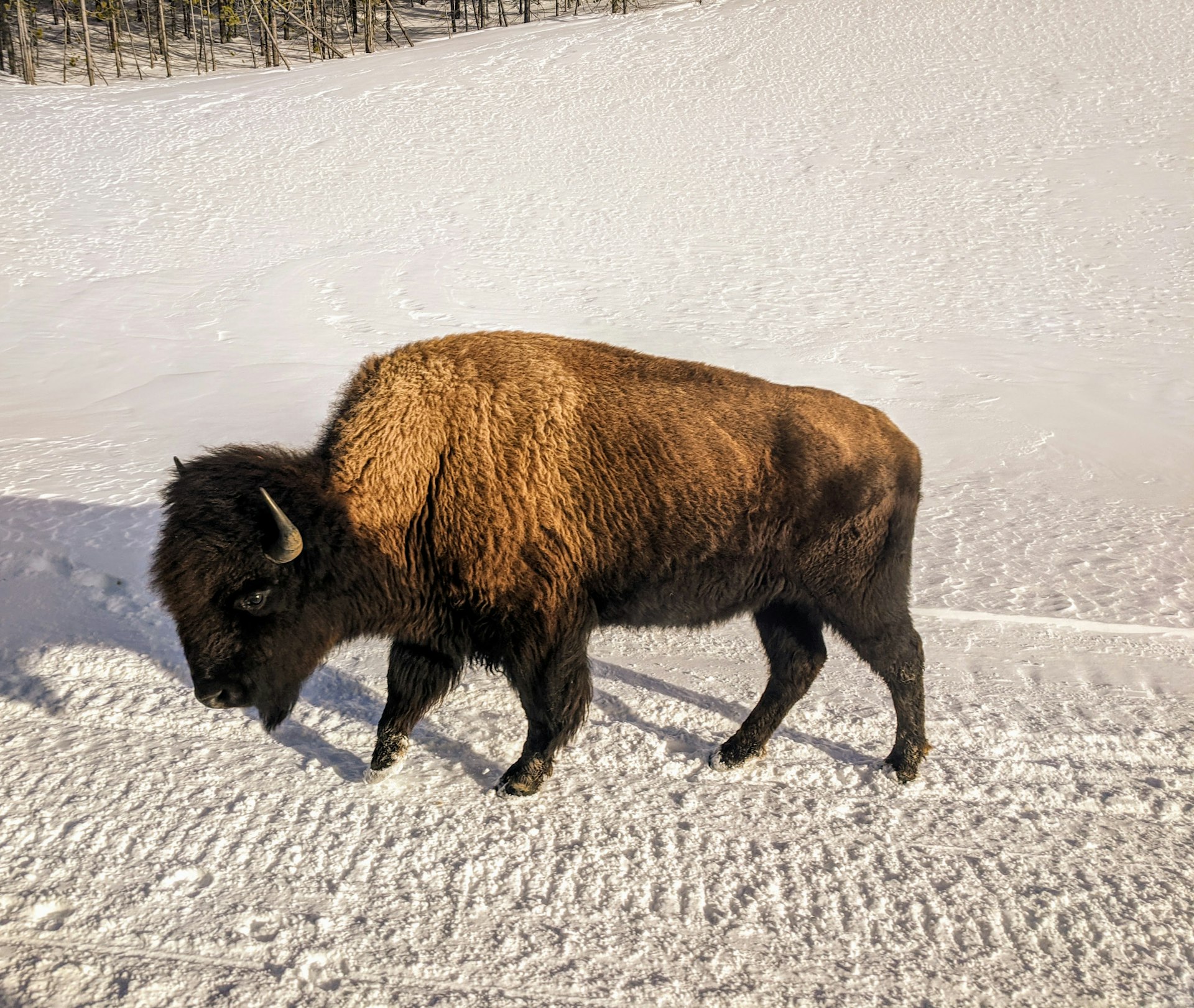
Yellowstone Wildlife
Bison are everywhere in Yellowstone and you're sure to see some any time of year – possibly quite close, as they aren't shy about stopping traffic to cross the street or amble down the road at their own pace. While it's important to keep your distance, stay in your vehicle, and never, ever feed wildlife of any species, the chance to see one of North America's most iconic animals in its natural habitat is something special indeed.
That said, there are many more animals to view in Yellowstone than just these fuzzy giants, and you'll be sure to see many visitors armed with telescoping lenses and binoculars who are hoping to get a glimpse of the park's permanent residents, including grey wolves, elk, moose, mountain goats, bears, lynx, coyotes, mule deer, foxes, otters, and wolverines.

One of the best ways to see wildlife is to visit in the winter and take a tour on one of Yellowstone's snow coaches. The park's knowledgeable, close-knit team of guides are well-versed in where to find wildlife day-to-day and have the best shot at getting you where you need to be to catch a glimpse. Plus, they do the driving so you're free to keep your eyes peeled and your hands on your camera to catch thrilling split-second moments like foxes diving high in the air to "plonk" down on their prey.
Watching wildlife in Yellowstone National Park

Hiking and Backpacking
Yellowstone doesn't have quite the athletic reputation of parks like Yosemite, Arches, or Zion , which are practically synonymous with American rock climbing and canyoneering. But there's plenty in Yellowstone best seen from the trail or ski track to please outdoor enthusiasts of all skill levels – just remember to pick up a backcountry camping permit if you'll be heading out on overnight.
Morning Glory Pool sits not far from the Upper Geyser Basin and is well worth adding a little extra perambulation. The colors are even more brilliant in person than in photos, set off by lush, muted stands of evergreens.
Lone Star Geyser can be reached by hike, mountain bike or cross-country ski tracks – an outing which follows a picturesque section of the Firehole River to an impressive 45-foot high gusher that erupts roughly every three hours. Coincidentally, that's about long it'll take you to make the out-and-back if you're on foot.
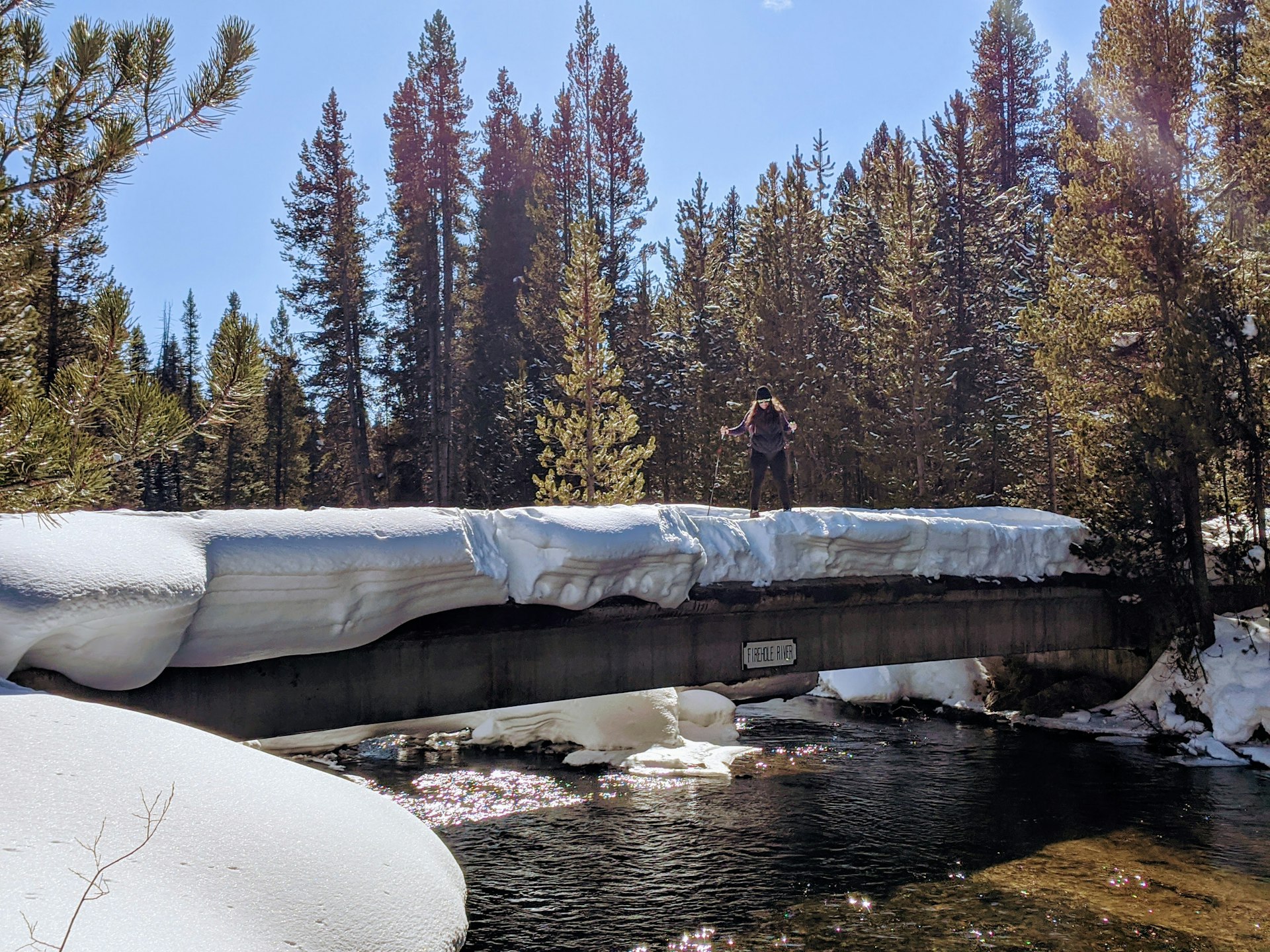
Bunsen Peak is a moderate to challenging hike of under five miles that's named for the same gent who invented the Bunsen burners you might have used in high school chemistry class. It offers expansive views of the northern part of the park around Mammoth Hot Springs – especially with the residual effects of the 1988 fires that swept through Yellowstone.
Electric Peak is a strenuous undertaking, spanning 20 miles of prime Yellowstone terrain and 3,808 feet of elevation gain and loss. Bring your bear bells and you'll be rewarded with panoramic views, fields of goldenrod, and glimpses of Yellowstone's varied geologic layers as you climb to the summit. You might even see a moose, especially if you turn this from a dawn-to-dusk day hike into a short backpacking trip.
The Black Canyon of the Yellowstone is a hard 13 miles, but it's full of adventurous details like a suspension bridge over the Yellowstone River, the cascade of Knowles Falls, and ancient rock slides. Follow in the footsteps of Teddy Roosevelt, early Yellowstone explorers, and even miners as you make your way to Eagle Creek Campground and back.
Insider’s guide to Yellowstone: where to trek and geyser gaze without the crowds
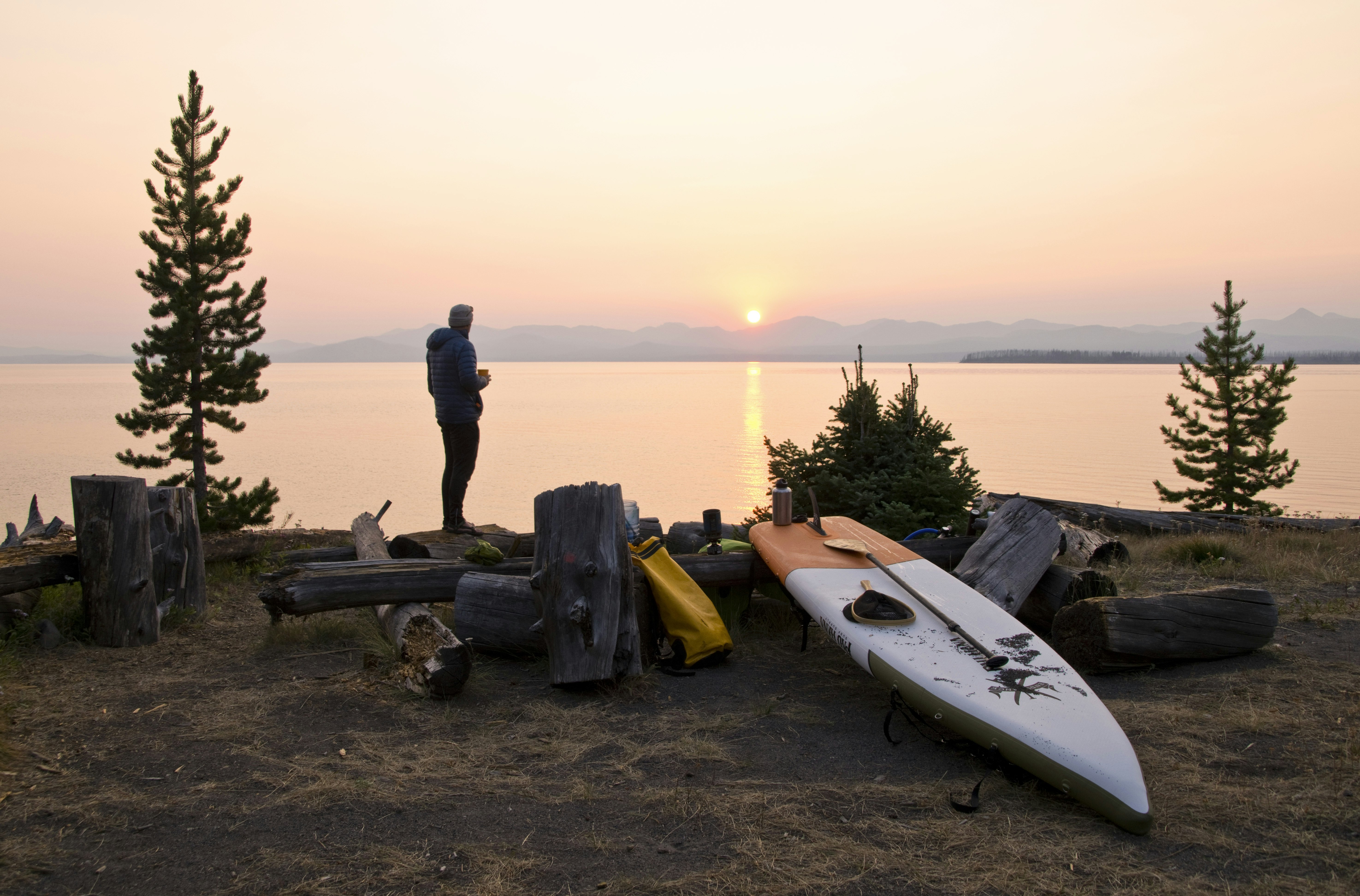
Watersports in Yellowstone
You can't take your kayak out on Yellowstone's streams – fair enough, since half of them have well-earned names like the Boiling River . But you can paddle Yellowstone's lakes and ponds, including Yellowstone Lake, Lewis Lake, and Shoshone Lake . There's a lot to see that's well worth the upper body workout.
Anglers will be rewarded with abundant fish, including some species native to the park. Wildlife watchers will appreciate the opportunity to observe fauna on the shore without ending up in a bison jam or rubbing elbows with other visitors. And yakpackers have the unique ability to reach remote areas of the park not on foot, but one paddle stroke at a time.
You can book guided river rafting trips out of Gardiner, Montana to shoot the Yellowstone River's rapids, kayak tours, and even overnight paddle expeditions if you don't have your own watercraft, or are traveling long-distance. You can also rent rowboats and outboards at Bridge Bay Marina, or a variety of watercraft from private companies outside the park.
The extra-adventurous can bring their dive gear and explore under the surface of Yellowstone Lake, West Thumb Geyser Basin , and the Firehole River at Mystic Falls – all under-the-radar national park scuba destinations .
Everything you need to know about paddling in Yellowstone National Park

When to Visit
Yellowstone is open to visitors year-round, though it closes for two short shoulder periods a year to transition between seasons. Yellowstone generally closes between March through April each year to give crews time to plow the roads and prepare the park for peak season. The park also shuts down in September and October to winterize its infrastructure.
The most popular months to visit Yellowstone are July and August when families are on summer vacation and temperatures are the warmest. If you want to avoid significant crowds, it's better to come at the beginning or end of the summer season, though temperatures might be a little cooler.
During the summer, weather in Yellowstone is warm and pleasant during the day, with highs in the 60s and 70s, but can still dip down into the 30s and 40s (Fahrenheit). It's always wise to pack layers and sunscreen, and to ere on the side of camping gear rated for lower temperatures.

Winter in Yellowstone is criminally overlooked, with prime opportunities for viewing wildlife like bison, elk, foxes, weasels, and even the park's famous wolves. You'll also face next to no crowds, except around Christmastime, giving you ample opportunity for photos or simply soaking up the contrast of fire and ice uninterrupted.
In winter, temperatures can hover around zero or below, though the low humidity makes it easy to layer warmly, especially if you're planning an active day of snowshoeing or skiing. Avoid cotton clothing in favor of wicking, insulating fabrics like silk, wool, or synthetic base layers, and make sure you have good socks and gloves.
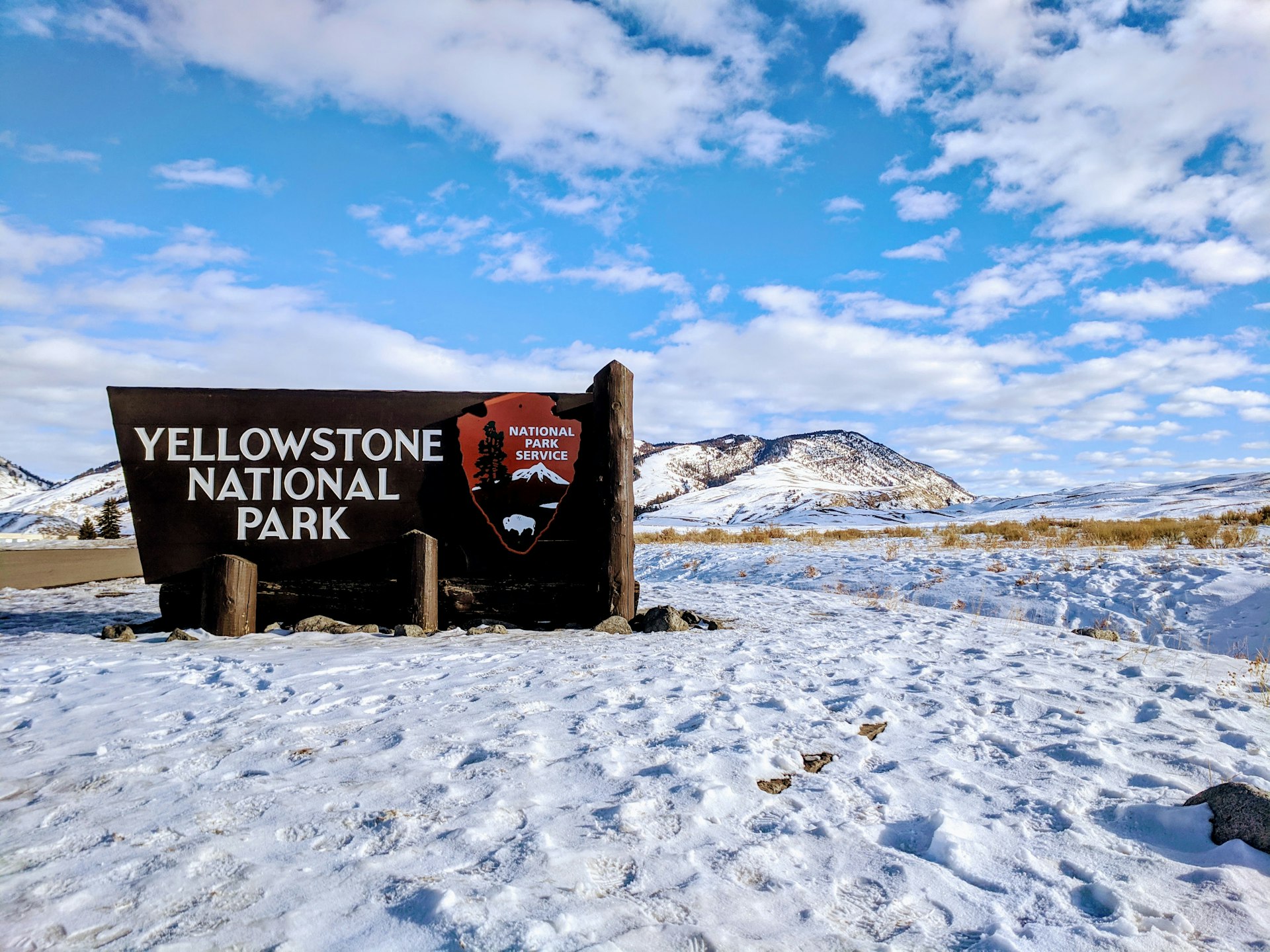
Getting There and Getting Around
The easiest way to reach Yellowstone is by flying into one of the region's airports, including Jackson, Wyoming; Bozeman, Montana or Idaho Falls. Cody, Wyoming and Billings, Montana are also options. In peak season, you can also fly directly into West Yellowstone, Montana.
Bozeman is often the best deal and is a very fun college town with plenty to see and do on your way in and out. Grab a beer and a bite at Montana Ale Works if you have the chance. Meanwhile, Jackson, Wyoming has earned its outsize reputation as a mountain town worthy of a vacation in its own right – swing by Snake River Brewing if time allows, where you will run into everyone from young guns to backwoods mystics to thoughtful western old timers.

Highways 20, 191, 89, 212, and 14/16 all connect to or border Yellowstone National Park, depending on whether you're driving in from Montana, Idaho or Wyoming. You can make a road trip of reaching Yellowstone from Jackson by driving north through Grand Teton National Park. Another option is to drive west from Devil's Tower National Monument on the Wyoming/North Dakota border, or northeast from Craters of the Moon – which will give you a sense of just how much power the Yellowstone hotspot has packed in millennia past.
Once you are within the park, there are a few main roads linking the five entrances to the park, including the Grand Loop Road, Norris Canyon Road, West Entrance Road, North Entrance Road, South Entrance Road, and East Entrance Road. The only road open in the winter months is the Grand Loop Road to 212 through Tower Junction between the North Entrance at Gardiner, Montana and Cooke City Montana.
Patience is a virtue, as in most popular national parks. Traffic can be slow in peak season when the park is most crowded, especially if there's a "bison jam" caused by tourists stopping int he middle of the road to snap photos of nearby wildlife. Keep calm and keep your eyes open – and don't forget to fill up at Yellowstone's handful of gas stations when you have the chance.

Where to Stay
Summer lodging in yellowstone.
In summertime, you'll have your pick of accommodations from lodges to cabins to campgrounds and even yurts, with a wide range to choose from within each category depending on your style and what part of the park in which you'd prefer to be based.
Especially in peak season, you'll want to book accommodations well ahead of time, especially if you're hoping for a prime room in the Old Faithful Lodge or your pick of campsites. Yellowstone can book out months or even a year in advance, even in a year when travel has been curtailed by a global pandemic.
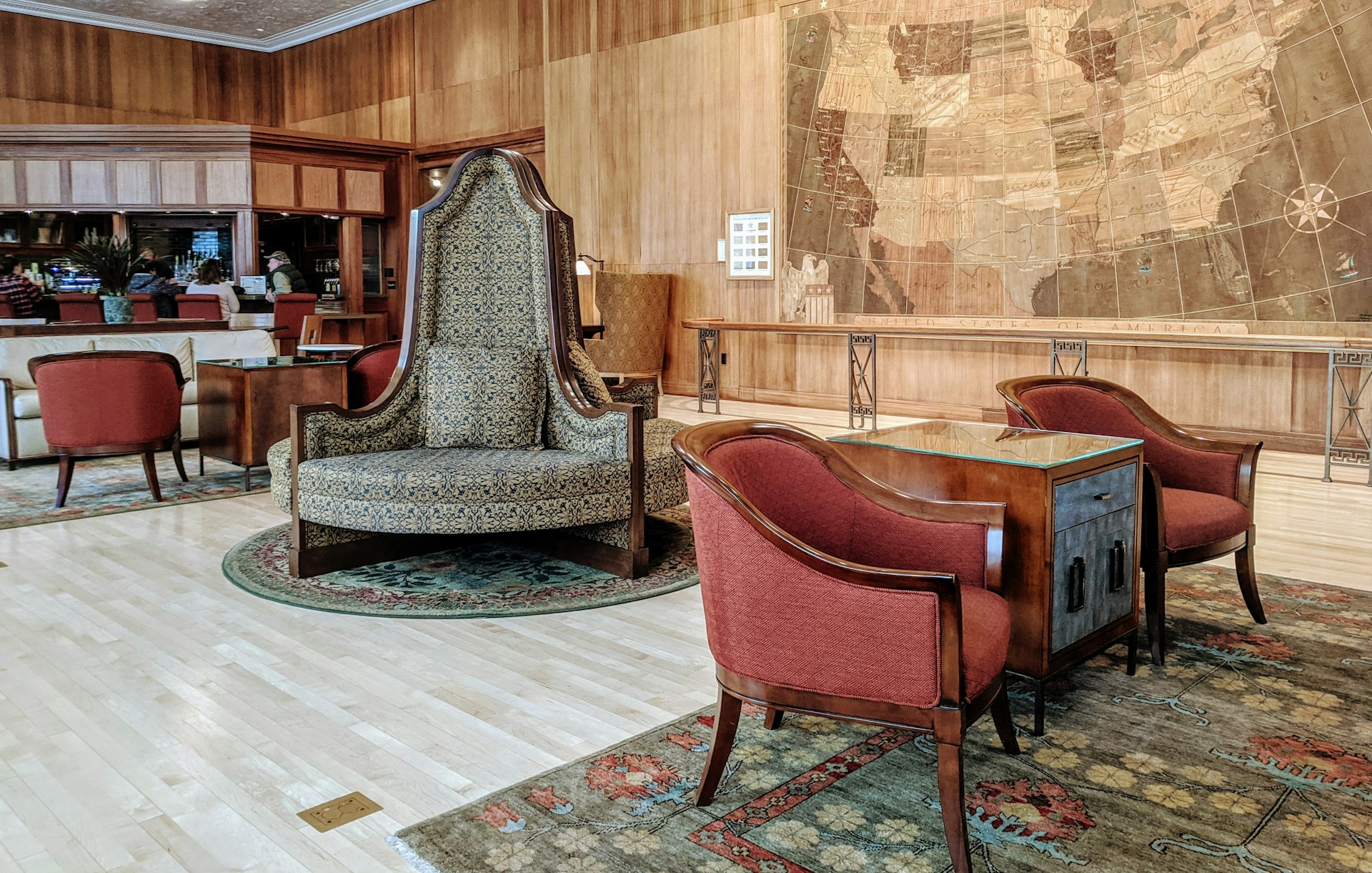
The iconic Old Faithful Inn, completed in 1904, is a prime example of "parksitecture" and is a testament to over a century of Yellowstone Visitors, close to both Old Faithful and the Upper Geyser Basin. The massive stone fireplace is a dreamy place to curl up after a long day of sightseeing, too.
The Mammoth Hot Springs Hotel is another gorgeous piece of Yellowstone history – parts of it date back to 1911, but most was built in 1936. The whole place was recently renovated, with chic updates to the guest bathrooms and many improvements made with sustainability in mind, like the recycled glass countertops. Don't miss a meal at the dining room across the street – the Elk Sliders with tarragon aioli are a treat, and the Bison Top Sirloin is especially memorable.

Grant Village , constructed in the 1980s, is tucked away near both Yellowstone Lake and Grand Teton National Park on the southern side of YNP. Visitors will especially appreciate the stunning views from the Lake House Restaurant and Grant Village Dining Room .
Lake Yellowstone Hotel was most recently updated in 2014, also with an emphasis on sustainability. The hotel swaps rustic charm for Colonial Revival glam and boasts some of the better internet connectivity in Yellowstone.
Canyon Lodge is the newest addition to the Yellowstone's collection of accommodations. This LEED-certified development gives you prime access to the Grand Canyon of Yellowstone , and is a contemporary take on the classic parksitecture found at the Old Faithful Inn.
11 sustainable ways to experience Yellowstone National Park

Cabins and Cottages
Cabins and cottages are available throughout the park as well, with options at Lake Yellowstone, Lake Lodge, Canyon Lodge, Roosevelt Lodge, Mammoth Hot Springs, Old Faithful Snow Lodge, and Old Faithful Lodge.
Cabins typically come with two options – those with their own baths including showers but not tubs, or those with sinks but shared bathroom facilities. The exception to this are the new Canyon Lodge Cabins, which have full bathrooms. The most historic is the Roosevelt Lodge Cabins, built in the 1920s near Tower Junction.

Campgrounds
Like other types of lodging, camping is available throughout Yellowstone at Madison Campground, Grant Village, Canyon Campground, and Bridge Bay Campground.
RVs can be no longer than 75 feet to navigate Yellowstone's roads, but most campsites cannot accommodate rigs long than 40 feet. Be sure to read up on length limits when choosing a campsite in Yellowstone as they vary from campground to campground.
Madison Campground and Canyon Campground the most conveniently located for seeing as many different areas of Yellowstone as possible. Grant Village is excellent for families and first-time campers, with easy access to the amenities at the nearby hotel. Canyon Campground and Bridge Bay are some of the most scenic places to camp.
Rangers patrol the campgrounds frequently to make sure you're complying with bear safety protocols and other regulations – so be sure to read up ahead of time on safe food storage practices and use the provided bear lockers. You can purchase firewood at check-in, and campsites are typically equipped with fire rings and picnic tables, and space to park your car.

Backcountry Camping
While backcountry camping is currently closed due to COVID-19 , there are 300 sites within Yellowstone. Because Yellowstone is so rugged and remote, and because it's home to bears and other apex predators, it's important to have some backcountry experience before taking advantage of these sites, and to be well-versed in Leave No Trace principles .
When there isn't a pandemic on, you can obtain permits within 48 hours of your visit from any of nine different ranger stations and visitor centers. Some can be reserved farther in advance, but are awarded by lottery starting April 1st from a running pool of reservation requests submitted by mail, fax, or in-person.

Winter Lodging in Yellowstone
In the winter months, Yellowstone operates limited facilities including the Old Faithful Snow Lodge and Mammoth Hot Springs Hotel. These are open from mid-December to the first of March. Mammoth Hot Springs Hotel can be reached from Gardiner, Montana in private vehicles, but during the winter season the Old Faithful Snow Lodge can only be accessed by commercial snow coaches.
While the Old Faithful Snow Lodge was built in 1999, its architecture is faithful to the period style of the neighboring Old Faithful Inn, and offers plenty of rustic romance. There are cozy fireplaces surrounded by welcoming club chairs, a bar and restaurant that turn out a delicious and varied menu (get the huckleberry pancakes), as well as ski and snowshoe rental onsite.
There's an ice skating rink just steps from the Snow Lodge entrance and in the evenings you can enjoy an outdoor fire pit – preferably after a tipple of MT 1889 Whiskey or a Big Sky Brewing's Moose Drool Brown Ale at the Firehole Lounge . If you get lucky, you might even spy some bison wandering just outside from the Geyser Grill dining room – they sometimes like to check out the Upper Geyser Basin themselves.
You might also like: The complete guide to Mammoth Cave National Park From stagecoach to motorcoach, a history of RVs in the USA Our top 10 picks for backpacking cooking gear
Make sure you're ready for anything with travel insurance from our trusted partners. Check out adventure tours for every traveler from our trusted partners.
This article was first published Jun 16, 2020 and updated Apr 15, 2021.
Explore related stories
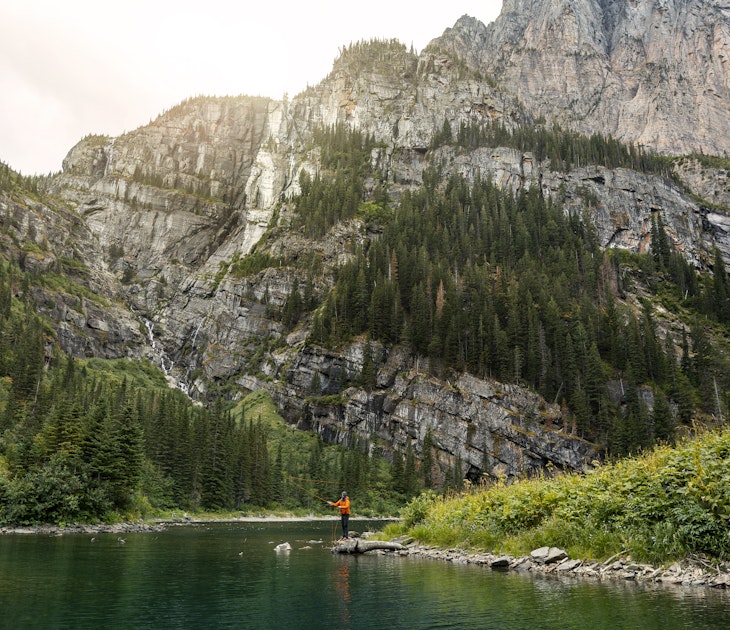
Sep 17, 2023 • 7 min read
Montana is one big, authentic slice of the American west. From national parks to historic towns, here are the best places to visit in Montana.
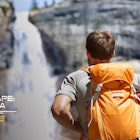
Apr 11, 2023 • 6 min read

May 18, 2024 • 11 min read

May 19, 2024 • 6 min read
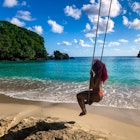
May 19, 2024 • 11 min read

May 19, 2024 • 5 min read

May 18, 2024 • 10 min read

May 18, 2024 • 7 min read


Yellowstone Itinerary 4 Days: The Ultimate First Time Visitor Guide
by Mark and Kristen Morgan
Published: June 18, 2020
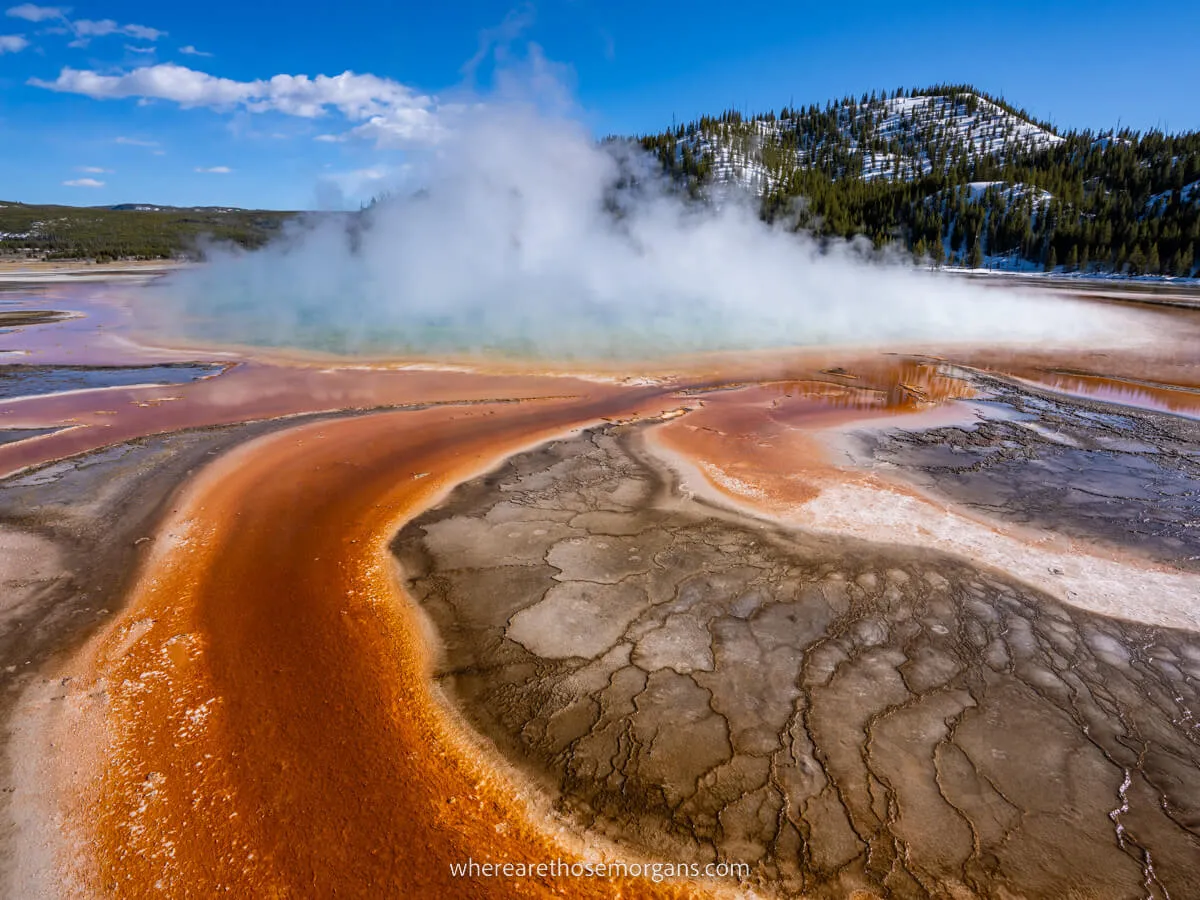
Yellowstone National Park is an extraordinary and unique landscape. After visiting the park in both April and October, we know how challenging but rewarding planning the best Yellowstone National Park itinerary can be. We’re going to share all of our knowledge about Yellowstone National Park here, including an amazing 4 days itinerary example.
Above ground, Yellowstone can be described by every synonym of the word breathtaking. But lurking just below the surface is a super-volcano known as Yellowstone Caldera.
As hot magma rises from Earth’s Mantle toward the Crust, pressurized heat escapes in the form of thermal geysers, creating a spectacle worthy of millions of tourists each year.
This ultimate Yellowstone National Park Itinerary explains how to get to Yellowstone, all the best things to do, where to stay and of course walks you step-by-step through 4 amazing days ticking off everything that makes this place so special.
Let’s get stuck into planning your Yellowstone itinerary!
Why Visit The World’s Original National Park?
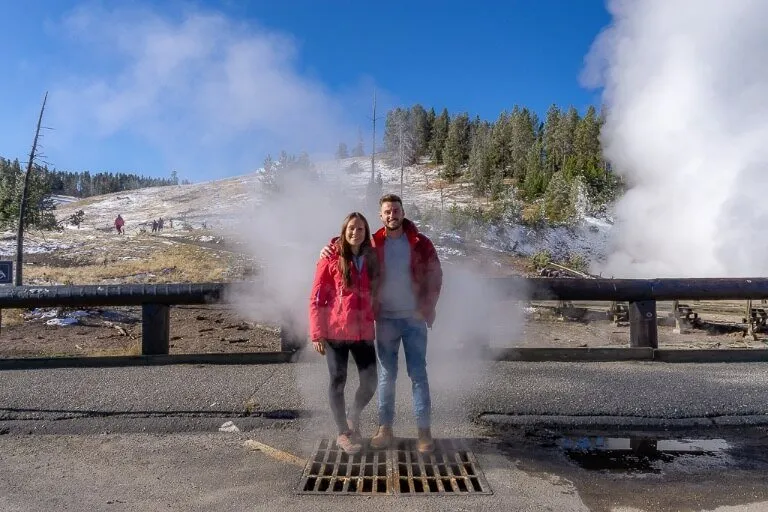
What is the fist thing you think of when you consider Yellowstone National Park? Probably super heated geysers blowing steam high into the sky, right?
We’d seen geysers before high up in the Chilean Altiplano and they were the one thing we knew for sure we would see here at Yellowstone.
However, the billowing plumes of pressurized steam had stiff competition for our favorite aspect at the park.
Spotting wildlife immediately becomes more exhilarating than looking at steam, the Grand Canyon of Yellowstone is immeasurably more awe-inspiring than steam, and the sheer scale of the world’s very first National Park blows the mind more than steam.
Now, that’s not to say we weren’t impressed by the gigantic geothermal caldera and all of its features, trust us, we were. It’s to let you know Yellowstone is far more than simply clouds of hot, sulfuric acid smelling steam.
Yellowstone is one of the most immense USA national parks and it covers a total of 2.2 million acres of land. Yes, it’s a little bigger than your back yard!
So in a nutshell, why should you visit Yellowstone National Park?
- Beautiful scenery throughout the entire park, plenty of wow-factor moments
- Some of the best wildlife spotting in America – including Grizzly Bears
- Fantastic hiking opportunities surrounded by nature at its finest
- Majestic waterfalls with multiple viewpoints cascading into deep canyons
- And of course Geysers, Hot Springs, Steaming Rivers & Bubbling Mud-Pots
Why 4 Days Itinerary For Yellowstone National Park?
For us personally, Yellowstone National Park had been sky high on our travel bucket list since – well, forever! Who hasn’t always wanted to visit one of Earth’s most unique and natural marvels?!
But we made one mistake the first time we visited. We only gave ourselves 3 days to explore this vast volcanic landscape. We needed 4.
Needless to say we never made the same mistake again second time we visited Yellowstone and planned a full 4 days itinerary.
If you’ve already been to the park before and this is a second or third visit, you might not need as many days. However, if you are planning for a first visit to Yellowstone, plan for 4 days.
Here’s why:
- With 3 days in Yellowstone you aren’t going to have enough time to see and do everything. You’ll spend a lot of time driving, and you’ll rush some of the most popular attractions. Plus, you will have to compromise on some things.
- With 5 days in Yellowstone you are going to find you have already seen and done everything. You will spend a lot of money on accommodation and you should instead drive down to Grand Teton if you do have this spare time.
You will strike the perfect balance between costs, attractions, drive time and being efficient if you plan a 4 days in Yellowstone National Park itinerary.
Grand Teton : Combine Yellowstone with the stunning Tetons for the ultimate 6 or 7 day vacation. Our extensive Grand Teton National Park travel guide covers the 7 best things to do and an ultra scenic 2 day itinerary.
Park Statistics And Factfile
Address : PO Box 168, Yellowstone National Park, WY 82190 Website : nps.gov/yell Phone : (307) 344-7381
Park Hours : All day, every day Entrance Fee : US$ 35 Vehicle (free with America the Beautiful Annual Pass )
Backcountry camping : Permitted, you will need a backcountry permit Accommodation : Hotels, Lodges, Cabins and Campgrounds
Annual Visitors : 4 million Peak Season : July-August
Size: 2.2 million acres Yellowstone Caldera : 45 by 30 miles Last Eruption : 640,000 years ago Geothermal Features : 10,000 Geysers : 300
How To Get To Yellowstone National Park
Okay, we’re talking about Yellowstone and 3,500 square miles of wilderness here! The park has several entrance and exit points, so getting to Yellowstone will depend entirely on where you begin your journey.
There are no fancy names for the entry points, simply the direction they bring you into the park from. But we have included the nearest town to each entrance for reference:
- North – Gardiner, MT
- Northeast – Cooke City, MT
- East – Cody, WY
- South – Jackson, WY
- West – West Yellowstone, MT
Once inside the park, getting around is easy thanks to a well maintained 142-mile figure of 8 road network known as ‘Grand Loop Road’.
Be aware this road will be almost unbearably busy if you visit in Summer, we even experienced some traffic flow issues in snowy October!
Here’s a factor to consider that will impact your 4 days in Yellowstone National Park itinerary:
- Are you visiting only Yellowstone, from point A with a plan to return to point A afterwards in a loop?
- Or is Yellowstone part of a wider road trip?
For example, on our first visit we drove West from South Dakota to Yellowstone, before heading South.
We visited Badlands , Custer State Park and Mount Rushmore , and stopped at Devils Tower National Monument on the way across Wyoming. We then took the South exit out of Yellowstone to Grand Teton National Park.
Therefore, we entered and exited Yellowstone at different entrances. That meant we had to work out how to efficiently see the park on both loops of the figure 8 road without driving back on ourselves.
Consider which entrance you plan to use on the way in and out when planning your visit.
Important Note : When we visited Yellowstone in October after a heavy snowfall, many of the roads in / out of the park were closed. Please be sure to check current road conditions before setting off.
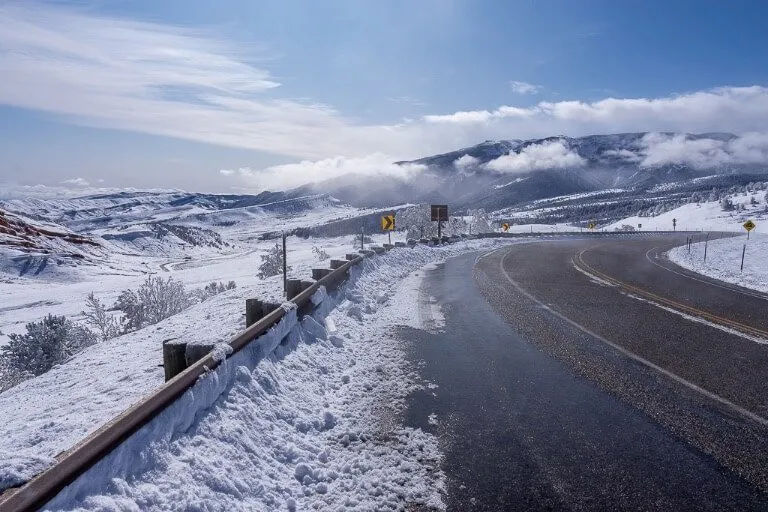
Popular Yellowstone National Park Road Trips
Salt lake city to yellowstone.
- Option 1 : Take I-15 North to Idaho Falls, then 20 to Yellowstone West entrance (320 miles / 4h 45m).
- Option 2 : Take I-80, 16 and 89 to Jackson, WY and Grand Teton before entering Yellowstone South entrance (330 miles / 6 hours).
The route via Jackson is far more scenic but takes much longer once you factor in driving through Grand Teton.
Read our amazing 7 day Salt Lake City to Yellowstone and Grand Teton road trip itinerary for more information.
Denver to Yellowstone
- Option 1 : Take I-80, 287 and 26 to 191 which is the link road between Grand Teton and Yellowstone South entrance (500 miles / 8h 30m).
- Option 2 : Take I-25, 26, 20 to Cody, WY and 14 into Yellowstone East entrance (545 miles / 8h 30m).
South Dakota to Yellowstone
- From Mt Rushmore, drive through Spearfish Canyon and take I-90W towards Buffalo, WY.
- Scenic Byway US-16 from Buffalo to Ten Sleep (Cloud Peak Skyway) is awesome.
- Take 31, 20 and 14 to Cody, WY and then on to Yellowstone East entrance (440 miles / 8 hours).
Read our popular 10 days road trip itinerary from Mount Rushmore to Yellowstone for a day by day break down of best things to do.
North Dakota / Billings to Yellowstone
- Take I-94 to Billings, I-90 briefly and US-212 (known as Bear Tooth Highway).
- This is the route we eventually took first time as we were forced to enter Yellowstone via its Northeast entrance due to road closures.
- Bear Tooth Highway is one heck of a scenic drive – particularly when covered in snow (150 miles / 3 hours).
Jackson, WY / Grand Teton to Yellowstone
Take US-191 scenic road (John D Rockefeller Jr Road) all the way to Yellowstone South entrance (80 miles / 1h 45m).
Need help organizing your visit to Yellowstone? Our popular 60+ page Yellowstone Guidebook can help you with planning every aspect of your trip.
Best Airports To Use For Yellowstone
Yellowstone is enormous and if you’re traveling from further afield in the US or internationally, you will of course need to fly.
Our in depth guide to the 6 best airports near Yellowstone will help you plan exactly which airports to arrive into and depart from near the park.
Pro-tip : Remember, you can fly into one airport and leave from another.
There are a dozen or so airports ranging in size close to the park, here’s a summary of the best airport options along with which entrance you would enter Yellowstone:
- Bozeman, MT (North entrance)
- Cody, WY (East entrance)
- Jackson, WY (South entrance)
- Yellowstone airport, MT (West entrance – seasonal)
- Salt Lake City, UT (South entrance)
- Denver, CO (East entrance)
International travelers can fly directly into SLC or Denver and either drive or take a connecting flight to on of the smaller regional airports listed above.
For US based travelers, check prices for all airports from your closest origin airport. The smaller and closer airports are far more expensive than SLC or Denver. You will pay for convenience!
- When it comes to booking flights, we always use and recommend Skyscanner flights search engine for finding the best value in air tickets.
- Similarly, when we need to pick a car up at the airport, we always use Rental Cars hire car search engine to find most options and best value for vehicles.
What Are The Best Things To Do At Yellowstone National Park?
Yellowstone is blessed with having an endless amount of amazing things to do for visitors to include on a 4 days itinerary. You could spend a month here and still not see or do everything this incredible place has on offer.
The only way to plan effectively is by structuring the park into regions. Therefore, in this guide we will break down each region of the park and explain some of the best things to do in each.
Read our ultimate list of the 30 Best Things To See And Do In Yellowstone National Park next for a detailed overview of the most popular geysers, waterfalls, hikes and wildlife spotting areas.
There’s a lot of information coming your way but we will organize it and clearly display everything on a map!
First up, let’s take a look into what makes Yellowstone National Park one of the most sought after landscapes in the world, before we break the park down into 6 distinct regions.
Yellowstone National Park Wildlife Spotting
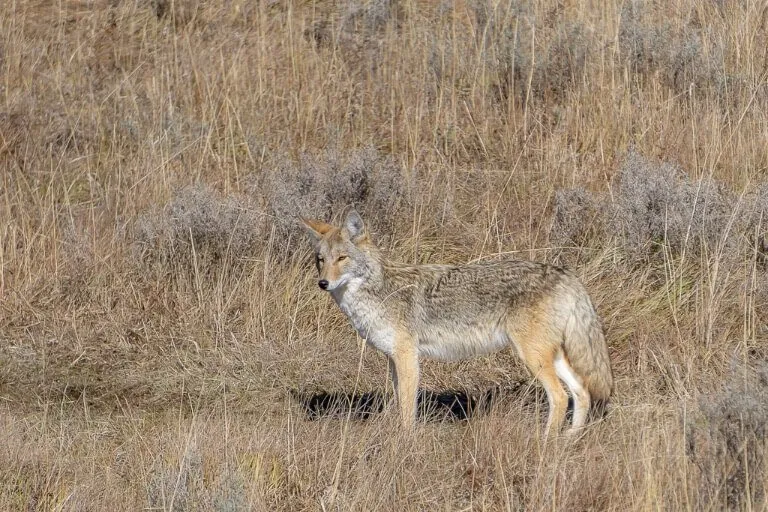
Wildlife spotting is one of the biggest drivers of tourism to Yellowstone National Park and it has to be a major part of your 4 days itinerary.
This is one of the best places in America to observe a wide range of wild animals in their natural environments.
You have the opportunity to see Grizzly Bears – seldom seem in the lower 48 US States – if that is of interest to you. Personally, we didn’t mind NOT seeing a grizzly!
However, Grizzlies are just the beginning. If you are lucky you might also see Black Bears, Wolves, Elk, Pronghorn, Bighorn Sheep, Moose, Antelope, Mule Deer, Coyotes, Lynx, Mountain Goats, Cougars and Bald Eagles.
It is extremely difficult to predict exactly where these animals are going to be at any given time. But you can give yourself the best shot at seeing wildlife by visiting the right places at the right times of day.
That being said, if these particular areas become busy with humans, animals are likely to move to quieter areas. In truth, we saw more wildlife when we didn’t go looking for it, instead we waited for them to come to us.
Top-tip : If you see small gatherings of people with professional looking photography / telescopic equipment, there’s a good chance of spotting wildlife. However, be polite, don’t make a lot of noise. You might even get a chance to look through their equipment .
Wildlife Respect & Safety
Something vitally important to remember is respect for wildlife. Keep your distance, don’t try to feed them and don’t intimidate the wildlife.
Our number one disappointment with Yellowstone was other tourists. Yes, it can be exciting to see an animal, but that doesn’t mean slamming on your brakes and abandoning your car in the middle of the road so you can take a picture.
More than once, we witnessed altercations between tourists who wanted the best angle from their car window. Be civil toward each other, as well as animals and the environment .
We use the word safety and that’s not for the animals, its for you.
Each year, Yellowstone National Park has to deal with injured tourists who thought they could get close to animals, but they were wrong. Bear in mind (pun intended!) that some of these animals can become dangerous if threatened.
Yellowstone Geyser Basins & Hot Springs
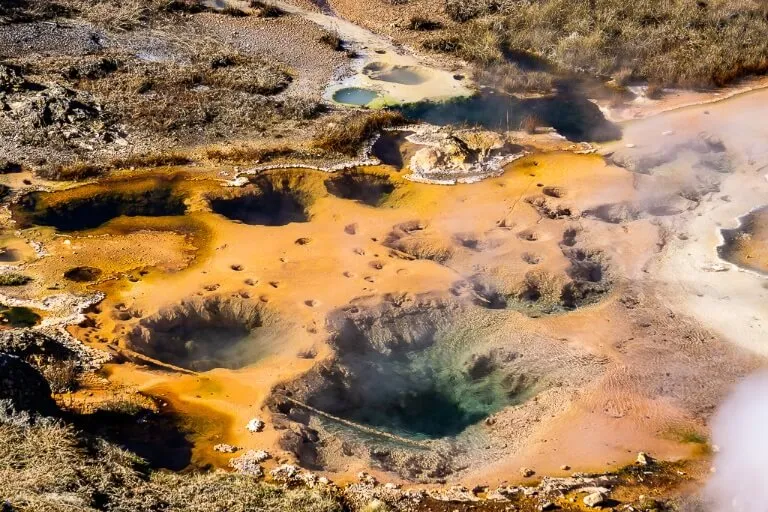
There are over 10,000 geysers and hot springs within the 2.2 million acres of Yellowstone National Park, making this the largest geyser field on the planet.
Almost all geysers and hot springs throughout the park can be viewed from safe distances along wooden boardwalks. It is important to stay on designated board walks, otherwise you may lose a toe or two!
We will cover Yellowstone’s most famous geysers and hot springs within each region of the park below.
You will either have to visit the lesser known basins or plan your visit outside of high season (more on seasons later) if you’re looking for a less crowded experience
Remember there are also bubbling mud pools, smaller colorful geysers and lesser known hot springs. If Old Faithful and Grand Prismatic Spring are too busy, try again early or late in the day.
Yellowstone Hiking
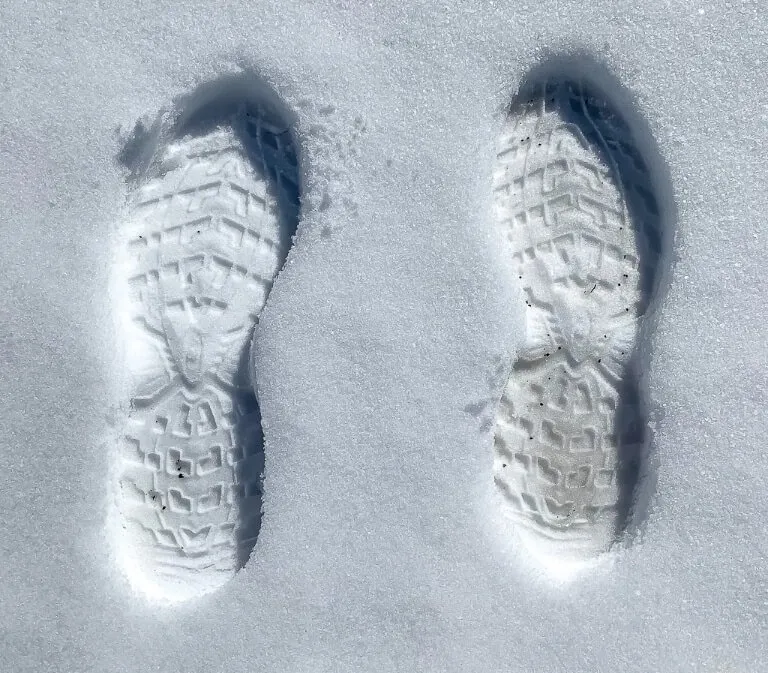
Hiking is less synonymous with Yellowstone than geysers and wildlife, however, you should not overlook this aspect of visiting the park.
Did you know there are over 900 miles of hiking trails here? The problem is, how do you choose which trails to hike?!
To begin with, err on the side of caution by checking Yellowstone’s backcountry situation report – particularly if you intend to hike away from major trails.
This live updated report will inform you of bear activity, trail closures, rising water levels and depth of snow among other important aspects.
Hiking is the best way to escape crowds and see Yellowstone’s best sites from different (and quieter) perspectives. Plus, you drastically increase your chances of spotting wildlife away from roads and hordes of tourists.
The downside to hiking at Yellowstone National Park is how much time you will lose from an already tightly packed itinerary. Can you really afford to lose a day hiking a 10 mile trail?
That depends on what your goals are and how you like to explore new places.
There are a number of shorter hikes well worth your time, but the longer hikes / backcountry hiking should be reserved only for those who are more interested in hiking than sightseeing.
Is this your second or third vacation to Yellowstone? Try hiking more on this visit if you’ve visited the famous geysers on previous trips.
Grand Canyon of Yellowstone / Yellowstone Upper and Lower Falls
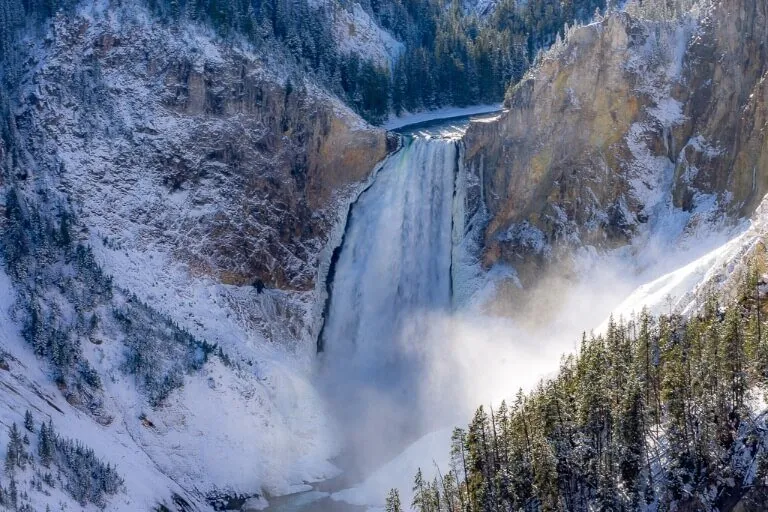
The Grand Canyon of Yellowstone has allured avid photographers to the park for decades. Upper Falls is an impressive spectacle but Lower Falls is the major draw and has to be included on your 4 days in Yellowstone itinerary.
The Yellowstone River crashes into a stunning canyon from 308 ft (twice the height of Niagara Falls), making Lower Falls a paradise for lovers of dramatic scenery.
The best part?
There are various viewing platforms along both the North and South Rim drives running adjacent to the river. Each observation point offers its own perspective of the mighty falls, plus the chance to escape big crowds.
Our top recommendation is to visit the falls on more than one occasion and preferably at sunrise (for more special sunrises see our guides to Sunrise in the Grand Canyon and Mesa Arch in Utah ).
Although temperatures were below zero in mid-October, we witnessed a gorgeous sunrise over Lower Falls with just a handful of others.
Let’s Break The Park Down Into Regions
As we mentioned earlier, it’s hard to apply a typical list of ‘best things to do’ list for a place like Yellowstone, then expect to turn up and tick them off easily. It is simply too vast a landscape.
Many of the ‘must visit’ sites are spread out across the National Park, meaning planning your visit can become a little overwhelming (one of the reasons we recommend your Yellowstone itinerary to be 4 days and not 3 days).
Therefore, we will break down the park into regions. Take a look at the image below depicting the 6 major regions of Yellowstone:
- Mammoth Hot Springs (North)
- Tower-Roosevelt (Northeast)
- Canyon / Grand Canyon of Yellowstone (Central / East)
- Norris Geyser Basin (Central / West)
- Old Faithful / Upper Geyser Basin (Southwest)
- Yellowstone Lake / West Thumb (Southeast)
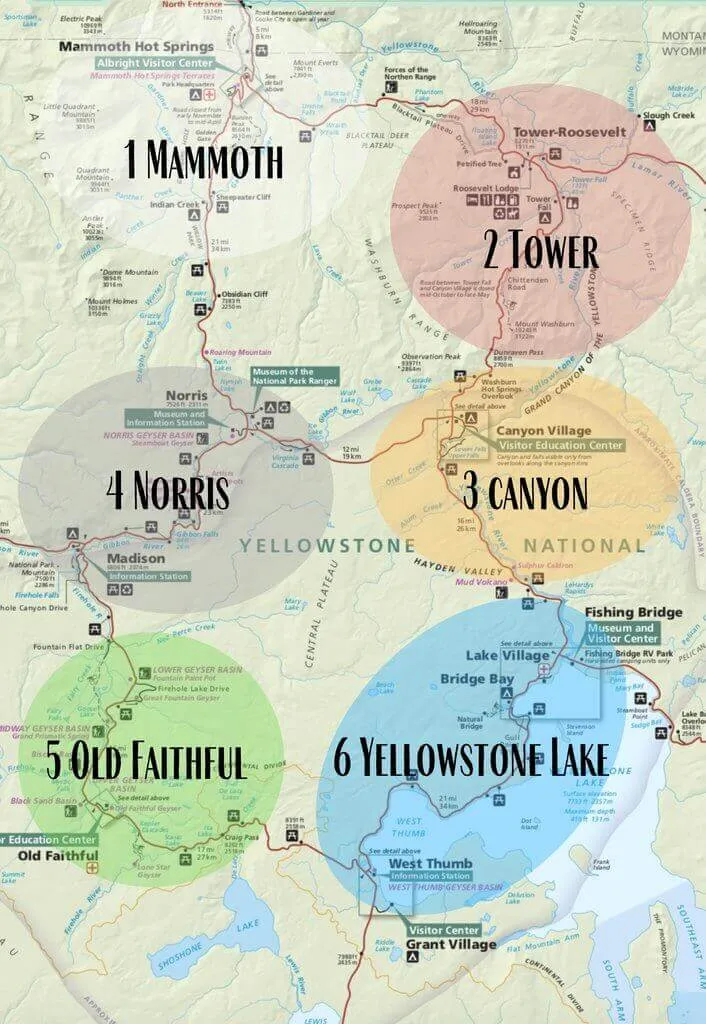
Within each region, we will discuss the following where appropriate:
- Most prominent Geysers / Hot Springs
- Best hiking trails
- Wildlife spotting opportunities
- Must visit miscellaneous attractions
- Lodging / Camping
Note : At the end of this section, study the interactive map showing all accommodation and sites of interest. The map will give you an idea about which regions will be top of your wishlist.
1. Mammoth Hot Springs (North)
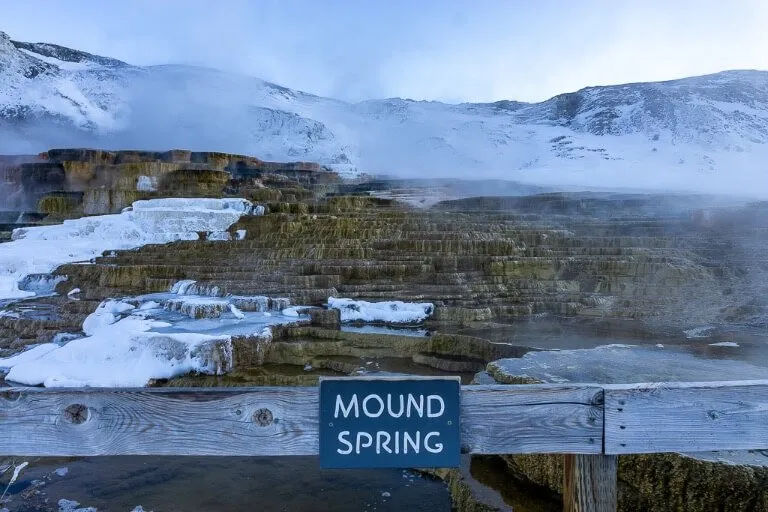
Mammoth is one of the more built up areas inside Yellowstone National Park and is located just 5 miles from the North entrance.
You will find a hotel, cabins, a grand dining hall, post office, gas, campground, shopping and Albright Visitor Center. Nearby attractions are all within a stones throw of Mammoth village.
Mammoth Geysers and Hot Springs
A spectacular complex of terraces formed by calcium carbonate (travertine) dominates a hillside just minutes from Mammoth village.
By far the busiest attraction in Mammoth, these terraces are best seen at sunrise to avoid crowds and enjoy the first light of day burn through hazy steam in the morning.
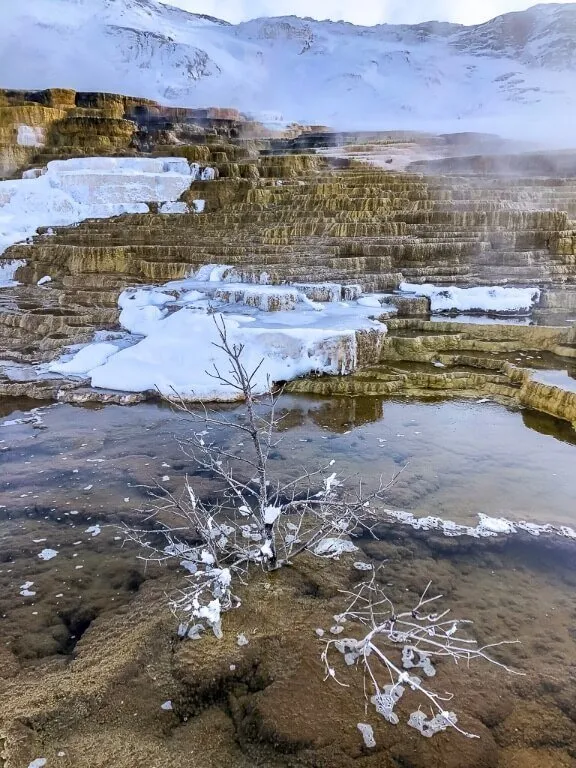
Mammoth Hiking Trails
Mammoth isn’t known for epic hikes and we would recommend not using up any time on your 4 days in Yellowstone itinerary with a hike here.
That being said, if you have extra time in the area, there are 2 shorter trails worth looking into:
- Boiling River – a popular short hike (1 mile roundtrip) and don’t forget your swimwear!
- Lava Creek – mid-distance (7 miles round-trip) passing by Undine Falls – 60 ft waterfall.
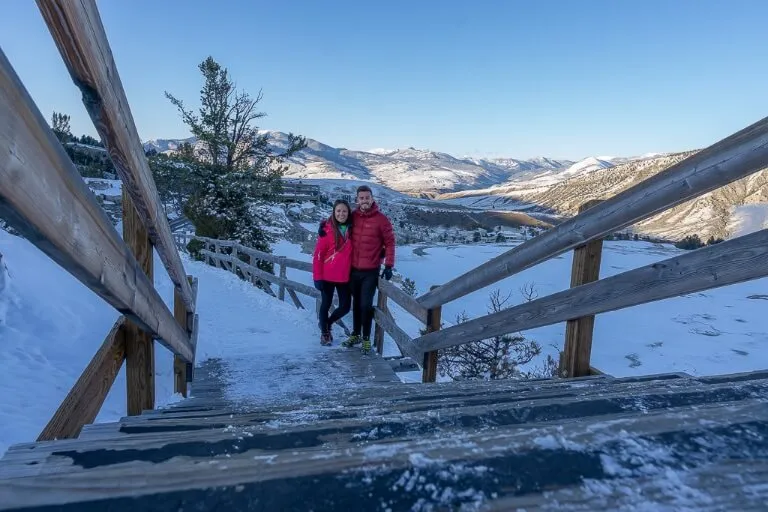
Mammoth Wildlife
Although this area is not usually regarded as prime wildlife spotting territory, we saw our fair share around Mammoth. There were around 30 or 40 bison walking through Mammoth village during our second visit in April, which was really cool to see.
You will more than likely see mule deer wandering the hotel and dining hall car park when you arrive. We also saw pronghorn and elk but bison are well known to be regular visitors to the area.
Black bears can be found around Mammoth. If you want to find one, look in forested areas around less busy areas away from the travertine terraces.
But if you want to avoid bears (particularly if you head up to the terraces for sunrise) is to make noise, talk and clap intermittently.
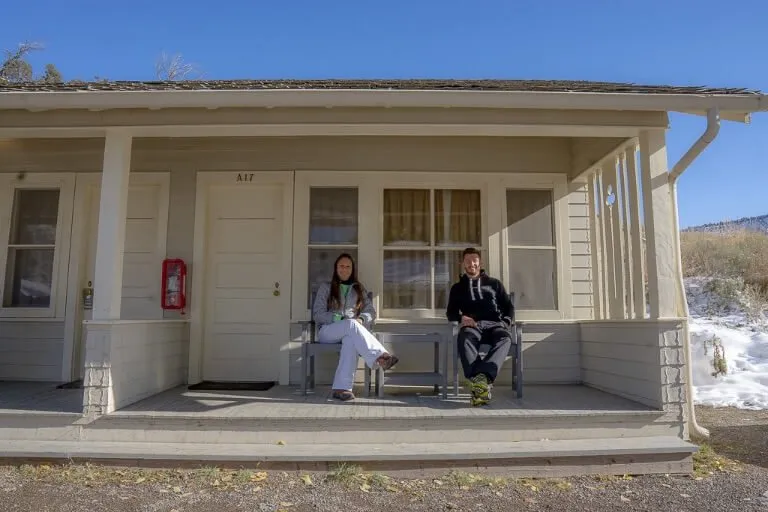
Mammoth Accommodation
Campgrounds – Mammoth campground is the only campground open all year at Yellowstone. This is a first come first served site and costs US$ 20 per night. More information .
Hotel and Cabins – Mammoth offers a Frontier Cabin, Hot Tub Cabin, Suite, Premium Hotel Room and Cabin without bath. We stayed in a Frontier Cabin and it was perfect with a wonderful hot shower. More information .
2. Tower-Roosevelt (Northeast)
Tower-Roosevelt is located to the Northeast of Yellowstone and is one of the lesser built up areas of the park. You can find gas, primitive lodging and camping here.
This region is best used as a gateway for wildlife spotting in Lamar Valley and hiking Mt Washburn before continuing on to another region for accommodation.
Unfortunately, the section of road between Tower and Canyon has been completely closed for the entirety of both our visits.
Therefore we are yet to hike Mount Washburn or see Tower Fall. There’s always the third time, right?!
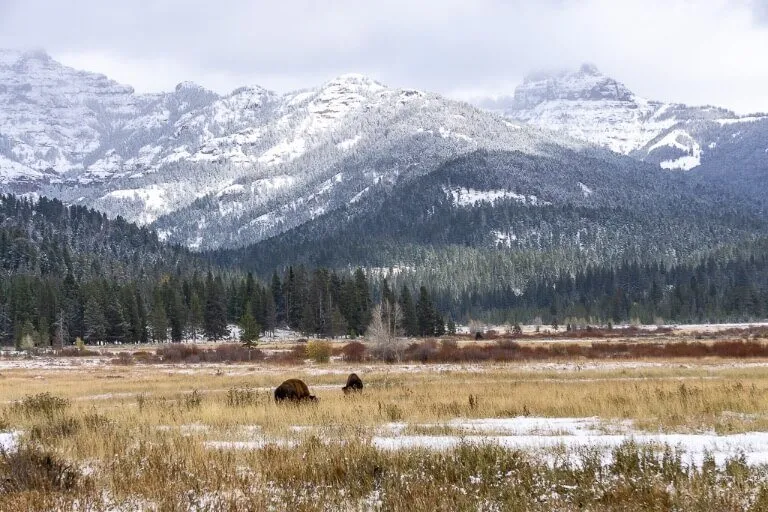
Tower Hiking
Mount Washburn is one of the most popular hikes in Yellowstone National Park and one of the most iconic hikes in the US thanks to its panoramic sweeping views stretching as far as Grand Teton on a clear day.
At 10,243ft (3,107m) and with just a 2.5 mile one-way hike from Chittenden or 3 mile on-way hike from Dunraven Pass, the rewards are more than worth your efforts!
Specimen Ridge is a long point to point hike beginning just after turning onto the road into Lamar Valley. It is the perfect trail for those searching for wildlife who want to get away from the main road filled with tourists.
You can hike for 10 minutes or an hour before turning around but you can expect to see wildlife, particularly early in the morning.
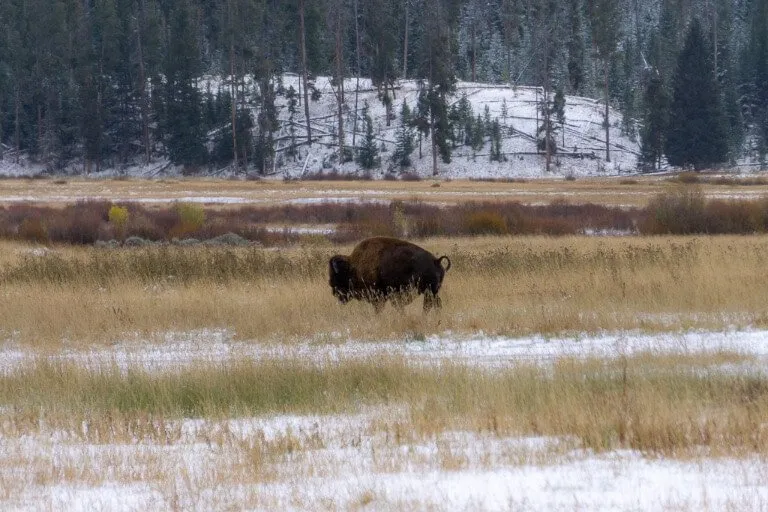
Tower Wildlife
Tower Junction is where Yellowstone’s top rated wildlife viewing area ends, as US-212 reaches grand loop road from the Northeast entrance.
This area is known as Lamar Valley and it is the place to be if you are visiting Yellowstone for wildlife observation.
We strongly recommend you visit early or late if you want a real chance of seeing abundant wildlife. You’re all but guaranteed to spot Bison roaming but you can see much more if you time it right.
We entered Yellowstone via the Northeast entrance and drove the entire way through Lamar Valley but it was right before midday (and snowy!) so we didn’t see many animals.
Note : If you are visiting Yellowstone primarily for wildlife spotting, Tower Fall campground is the closest accommodation to Lamar Valley.
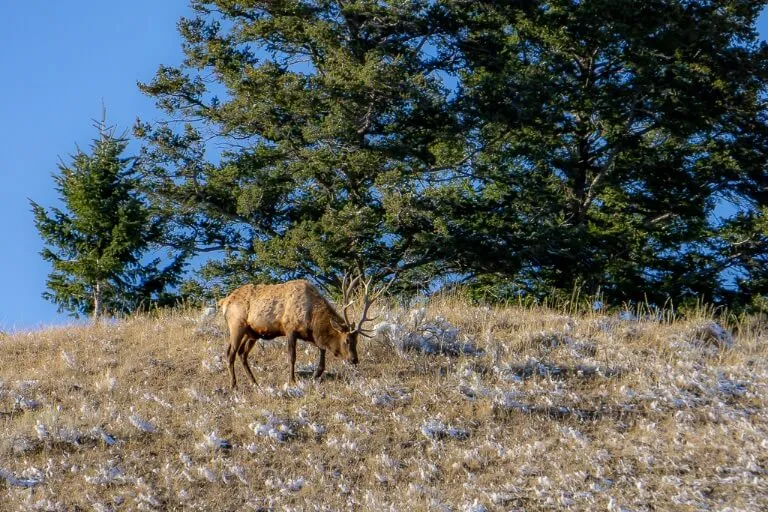
Tower Attractions
Yellowstone River Overlook and Tower Falls are the two major attractions around Tower-Roosevelt region.
Tower Falls is a 132 ft narrow needle-like waterfall. A 4 mile roundtrip trail allows you to see the Yellowstone River flowing powerfully through a gorge.
The trail is family friendly but there are steep cliffs for children to be aware of.
3. Canyon (Central / East)
Canyon is one of the most popular places to set up base in Yellowstone thanks to its central location and volume of accommodation, with over 500 rooms available.
You will also find a good selection of food at Canyon Lodge Eatery, which is more like a canteen than restaurant.
Canyon is your best choice if you prefer to stay at just one place for your entire Yellowstone visit. Right around the corner is Yellowstone Falls.
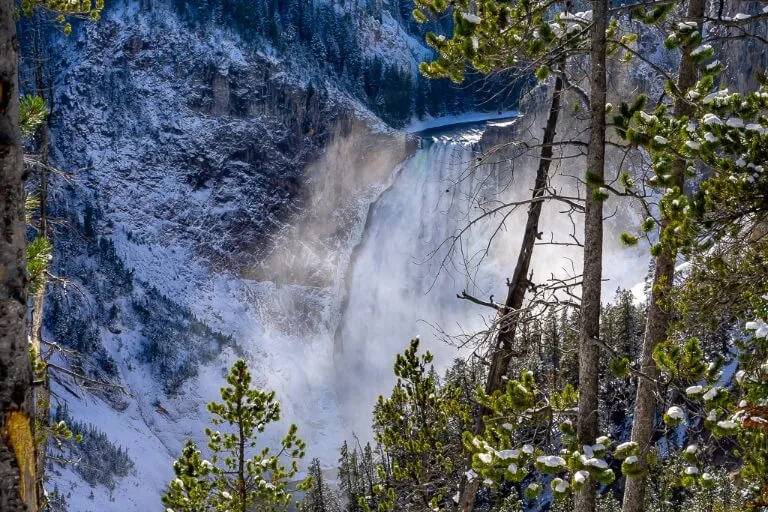
Grand Canyon of Yellowstone and Yellowstone Falls
Prepare to be blown away!
This is one sight you will not forget from your Yellowstone National Park itinerary. We encourage you to visit each and every viewpoint along both North and South rim drive – and do that more than once.
For the best photographs, arrive before sunrise to Artist Point . We couldn’t get enough of these dramatic views as the Yellowstone River pounds its way through the breathtaking canyon.
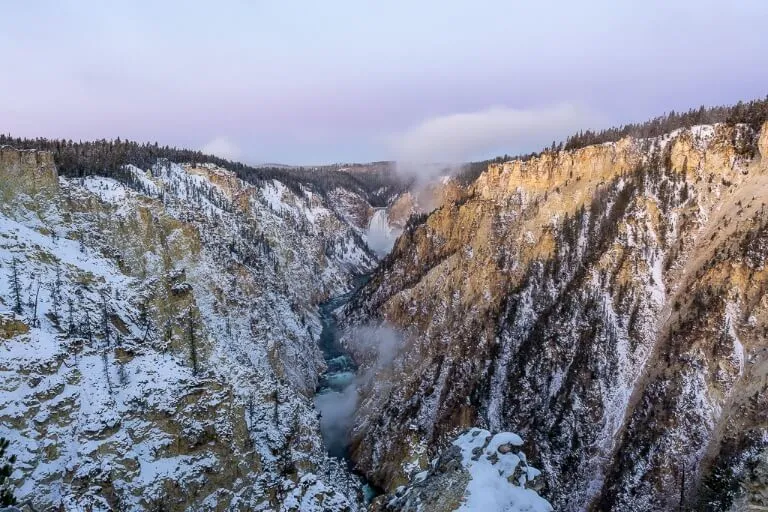
Canyon Hiking
There are no hikes worth mentioning around Canyon for a Yellowstone itinerary only lasting 4 days. With more time, maybe!
We don’t consider each of the small trails along North and South Rim roads to Yellowstone falls viewing platforms as hikes.
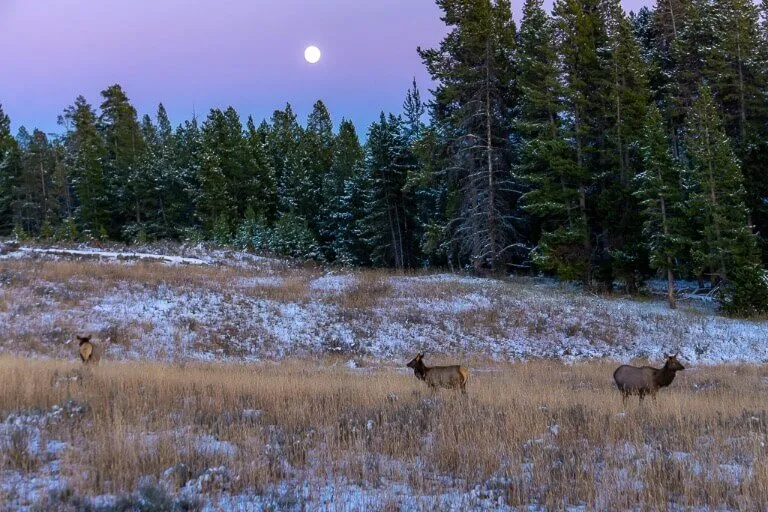
Canyon Wildlife
Just South of Canyon Village and Yellowstone Falls, you will find Hayden Valley , regarded as the second best part of the park for wildlife spotting.
This is the place we saw by far the most wildlife including coyotes, mule deer, bison and our first ever bald eagle . We saw bald eagles here again the second time we visited so you do stand a good chance of seeing one soaring around this area.
Again, it is best to arrive early or late to increase chances of spotting animals but be warned – Grizzlies roam alongside Yellowstone River. We never saw a grizzly, but we did see a lone Grey Wolf from afar, which was awesome .
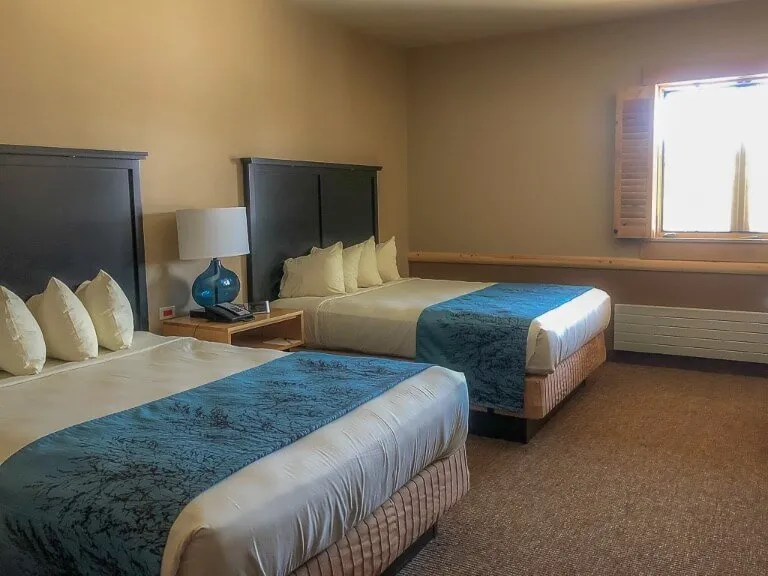
Canyon Accommodation
Campgrounds – Canyon campground is open late May to Mid Sept. There are 273 reservable sites at a cost of US$ 32 per night. More information .
Hotel and Cabins – Canyon offers the most accommodation by far at Yellowstone. It is open from the beginning of June until early October.
You can choose between a Western Cabin, Standard Lodge Room, Superior Lodge Room, Premium Lodge Room and Suite.
We snagged a free upgrade to Premium Lodge Room (from Western Cabin) which was a welcome escape from the cold nights! More information .
4. Norris Geyser Basin (Central / West)
Norris is the oldest and hottest of Yellowstone’s thermal regions, with the highest recorded temperature measuring a whopping 459 f (237 C) just over 300m below the surface.
This region is where your Yellowstone geyser hunting experience springs to life and you can witness the tallest active geyser in the world.
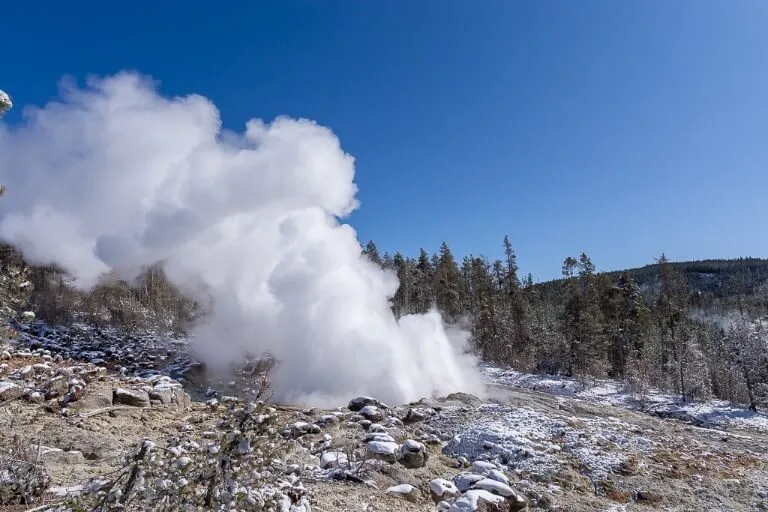
Norris Geysers and Hot Springs
At Norris geyser basin you will find several thermal geysers in very close proximity. The area is easy to explore via boardwalk and has to rank as one of the must visit regions on your 4 days in Yellowstone National Park itinerary.
Waters around Norris basin are acidic, rather than alkaline, which means bacteria creates those colorful patterns you associate with Yellowstone.
Steamboat geyser – the world’s tallest at 300ft – went years with barely any activity but in 2019 there were 48 eruptions.
But there’s no guarantee boiling hot water will erupt the day you visit and you could be standing around a long time waiting. We saw it blow a few times but not to it’s maximum height.
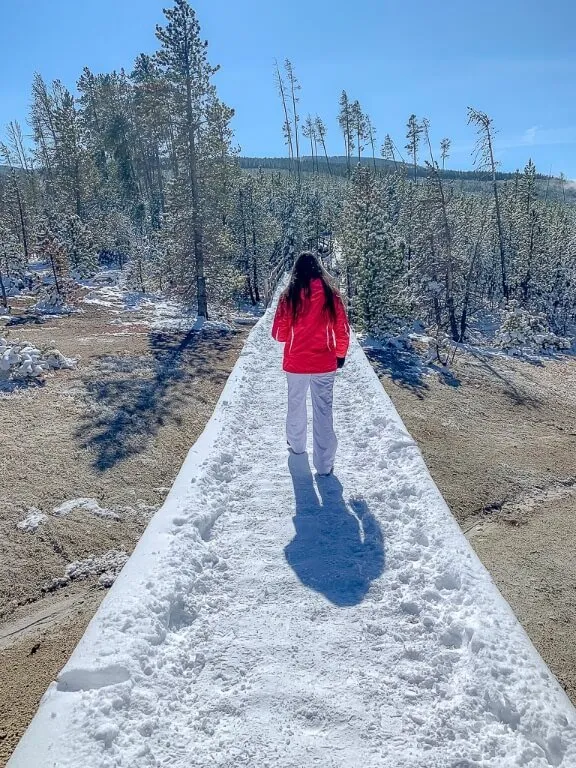
Norris Hiking
Artist’s Paint Pot – This 1 mile hike beginning just South of Norris Geyser Basin is definitely worth a quick stop off.
After a short walk through a forest you will come across a small open area featuring thick grey mud bubbling pools and blue/grey/brown colored holes in the ground.
Highly recommended easy hike.
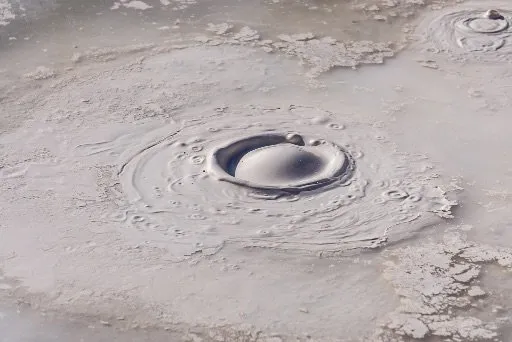
Norris Region Campgrounds
Norris campground – Open late May to late September and just to the North of Norris Geyser Basin. There are 111 first come first served sites at a cost of US$ 20 per night. More information .
Maddison Campground – Located 14 miles Southwest of Norris and open late April to mid October. Longer opening times and central location make this one of the most popular campgrounds at Yellowstone. There are 278 reservable sites for tents and RV’s at US$ 27 per night. More information .
5. Old Faithful (Southwest)
Old Faithful is the iconic Yellowstone geyser everyone knows about before visiting the park.
But the Old Faithful region has much more on offer, including perhaps the most eye catching feature of all: Grand Prismatic Spring.
This region contains Lower, Midway and Upper Geyser Basins – which means a lot of geyser hunting. You can find almost all amenities here, except a campground.
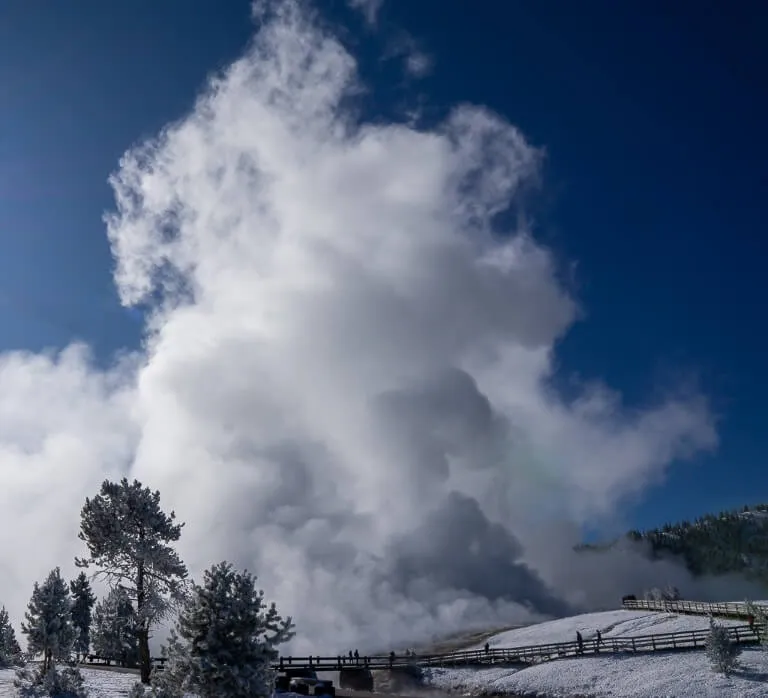
Old Faithful Region Geysers and Hot Springs
Lower Geyser Basin – Fewest geothermal features in the region but one of the most sought after spots for sunset in Great Fountain Geyser along Firehole Lake Drive (closed in Winter).
Midway Geyser Basin – Smaller in area but possibly the most rewarding in terms of natural beauty.
The vibrant colors of Grand Prismatic Spring are difficult to appreciate from its boardwalk, so you will need to climb Fairy Falls Trail for that postcard perfect view.
Excelsior Geyser can not be overlooked as it’s on the same boardwalk and produces an enormous amount of hot steam, often shrouding the Firehole River.
Upper Geyser Basin – The crown Jewel, Old Faithful is located here along with the highest density of geothermal activity in the park.
Old Faithful erupts once every 35-120 minutes for anywhere between 1-5 minutes. This isn’t the most spectacular of geysers, it’s just the most regular and predictable.
Don’t miss Morning Glory Pool at Upper Basin.
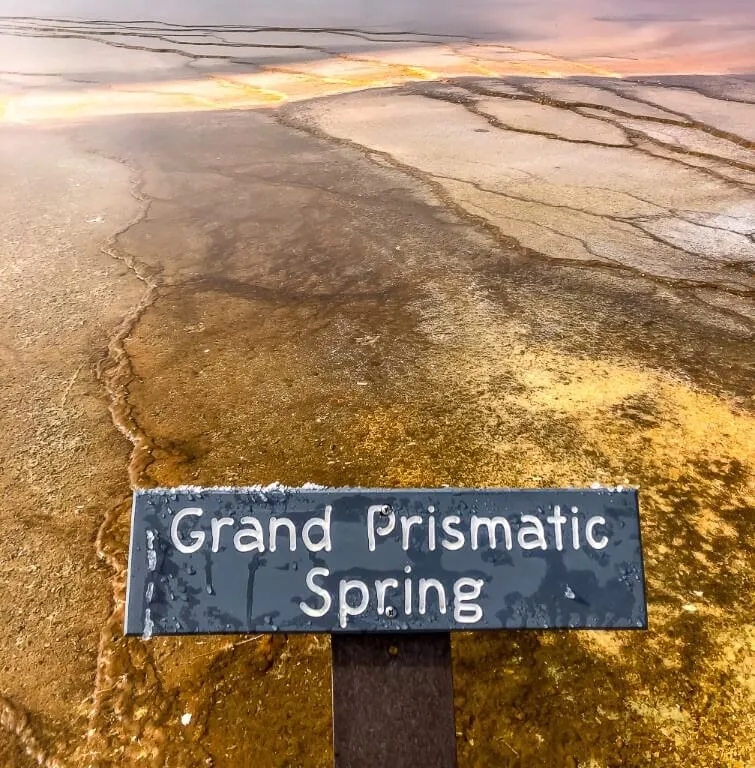
Old Faithful Hiking
Fairy Falls – Begin at Fairy Falls Trailhead for an easy 5 mile roundtrip to one of Yellowstone’s most spectacular falls. This trail also offers postcard-perfect views over Grand Prismatic Spring.
Observation Point – If you want to escape the crowds (knows as ‘the bleachers’) sitting in a half circle around Old Faithful, take this moderate 1.5 mile roundtrip hike.
You will be rewarded with a much more tranquil viewing platform.
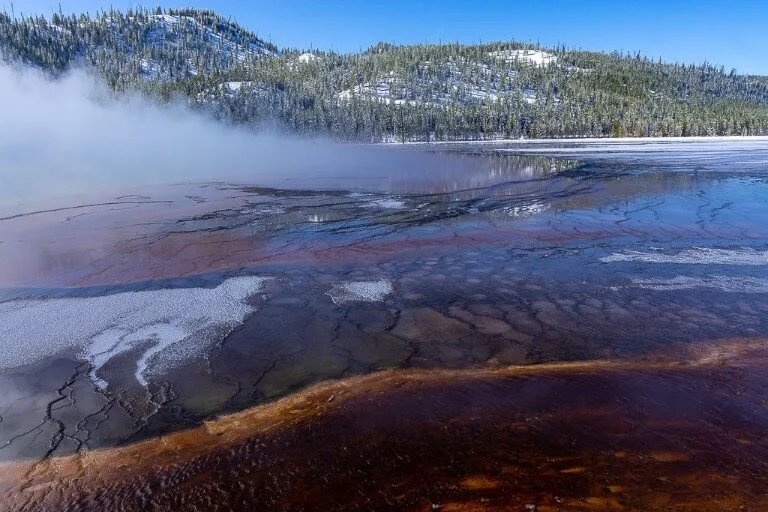
Old Faithful Accommodation
Old Faithful Lodge – Simple Frontier Cabins are more affordable and offer views over Old Faithful. More information .
Old Faithful Inn – 327 rooms and open from early May to mid October, but get in early as this is the most requested lodge in Yellowstone. More information .
Old Faithful Snow Lodge – Open mid December to end of February, only accessible by over snow vehicles. Wide range of rooms available at various prices. More information .
6. Yellowstone Lake / West Thumb (Southeast)
One thing you probably don’t know about – and certainly won’t appreciate until you see it – is the sheer scale of Yellowstone Lake. It is enormous!
We’ve combined West Thumb Geyser Basin and Grant Village with Fishing Bridge and Lake Village into the one region here.
They all hug the lake edge in Yellowstone’s Southeast corner. All amenities can be found at both locations on the lake.
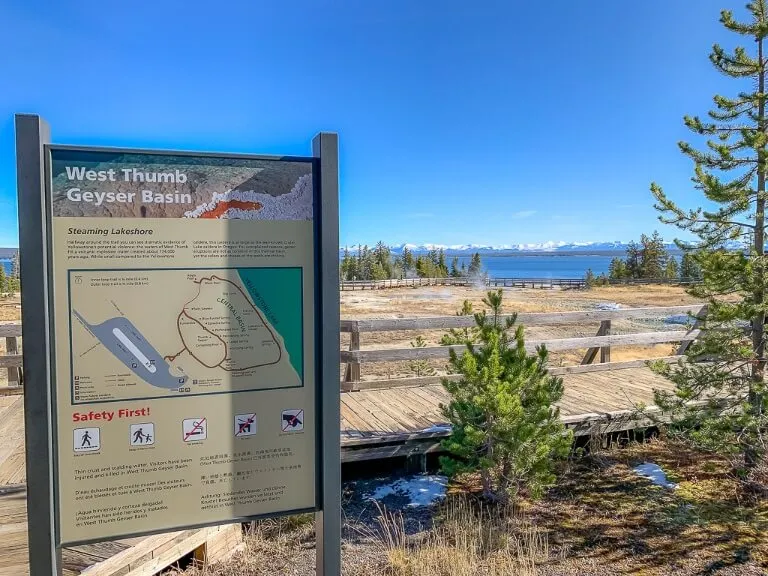
Yellowstone Lake Geysers & Hot Springs
At the Southern end of Yellowstone Lake you will enter West Thumb Geyser Basin. What makes this place unique is stunning views of Yellowstone Lake and snow capped mountains behind geothermal features.
A boardwalk loops around West Thumb Basin allowing you to see the most impressive features while enjoying some of the best views in the park.
Look out for Fishing Cone and Big Cone Geyser in the lake.
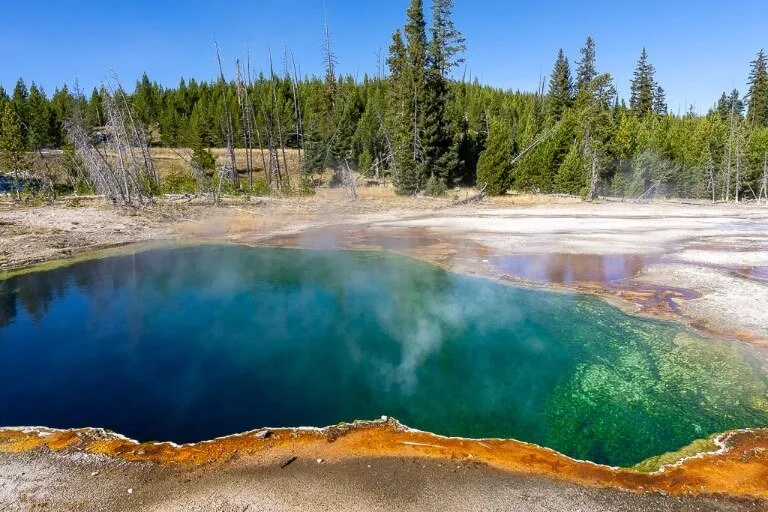
Yellowstone Lake Hiking
Yellowstone Lake isn’t the place to visit if you’re looking for serious hiking trails on your 4 days itinerary. However, there are two easy going walks ending with excellent views over the lake and West Thumb.
Lake overlook – Easy to moderate 1.5 mile roundtrip hike from West Thumb parking lot for elevated views over West Thumb Basin.
Storm Point – Easy 2.5 mile roundtrip beginning close to Fishing Bridge for close up views over Yellowstone Lake.
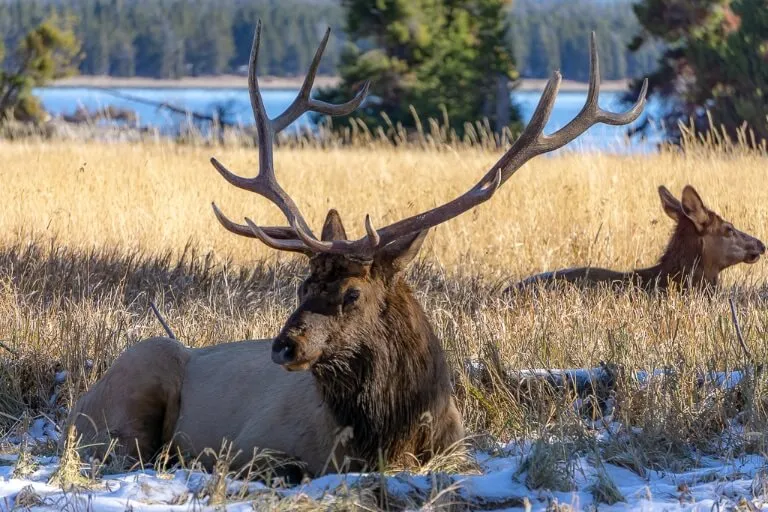
Yellowstone Lake Wildlife
The Northern part of Yellowstone Lake is where Yellowstone’s East entrance (from Cody) arrives into the park.
Areas surrounding East entrance road are known to be a favorite of the Grizzly Bear, but you can also expect to see a wider variety of wildlife in this region.
We saw coyotes and mule deer (pictured above) around Lake Lodge during our visit.
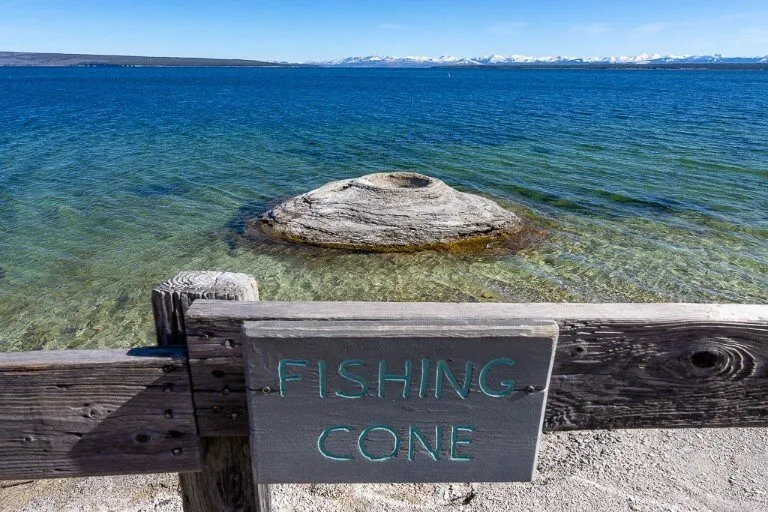
Yellowstone Lake Accommodation
Campgrounds.
Bridge Bay has 432 reservable sites at US$ 27 per night. It is open late May to early September ( more information ).
Grant Village has 430 reservable sites at US$ 32 per night. However, this one is only open mid June to mid September ( more information ).
Fishing Bridge RV Park has 310 RV only electrical hookup sites at US$ 79 per night. The RV park is open early May to mid September ( more information ).
Hotel and Cabins
- Lake Yellowstone hotel offers a wide variety of rooms from basic to extremely expensive ( more information ).
- Lake Lodge Cabins – Consisting of 186 Frontier and Western cabins at much more budget friendly prices ( more information ).
Example Of A Perfect 4 Days Yellowstone National Park Itinerary
You can begin to construct your plans now you have an idea about each region inside the park.
The following example itinerary is 4 days long, which means you can relax and take things slowly but still see and do the best of Yellowstone National Park.
Our biggest frustration when first visiting with 3 days was only having enough time to visit each attraction once and having to rush through. If a geyser or waterfall viewing area was crowded, or if the weather wasn’t playing nicely – well, that was just tough luck.
But with that extra fourth day, it means you can re-visit any place you missed, was too busy or you enjoyed the most.

Best Entrance To Begin 4 Days in Yellowstone Itinerary?
You can start your itinerary at any entrance. The figure 8 road inside the park makes it easy to adapt this itinerary to suit beginning from any direction.
The most popular entrance into the park is West Entrance / West Yellowstone and the second most popular in North Entrance / Gardiner / Mammoth.
However, we will begin this itinerary as though you are entering from Northeast Entrance / Cooke City and exit on Day 4 via South entrance to Jackson and Grand Teton.
This is the most efficient way to visit because you can drive through Lamar Valley early on your first morning for the best chance of seeing abundant wildlife, see the park and leave without driving back on yourself too much.
If you are staying in West Yellowstone or Gardiner for the duration of your visit, or are entering via any other entrance, simply move around the days as we list below. The same things to do still apply, you can just adjust the itinerary to fit.
Driving Distances Between Major Yellowstone And Grand Teton Regions
One final thing to touch on before we get into an example Yellowstone itinerary is driving distances between major areas in the park.
We have mentioned it’s a big park and there can be a lot of driving, but we thought it would be more helpful to show you in numbers.
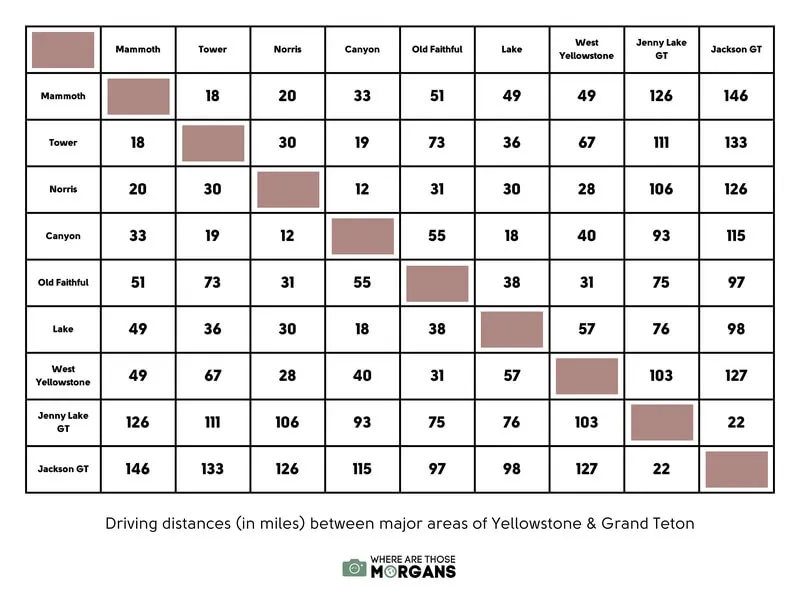
Use the distances to gauge how far you might travel on any given day during your Yellowstone itinerary.
This is a Yellowstone guide but many visitors will also want to see Grand Teton either before or after, so we included Jackson and Jenny Lake for reference.
We have also included West Yellowstone because a lot of people stay here for their entire visit to Yellowstone and it helps to see how far it is to each major region.
OK, let’s finally get stuck into our 4 days in Yellowstone itinerary example!
Yellowstone Itinerary Day 1 – Lamar Valley, Tower-Roosevelt and Mammoth Hot Springs
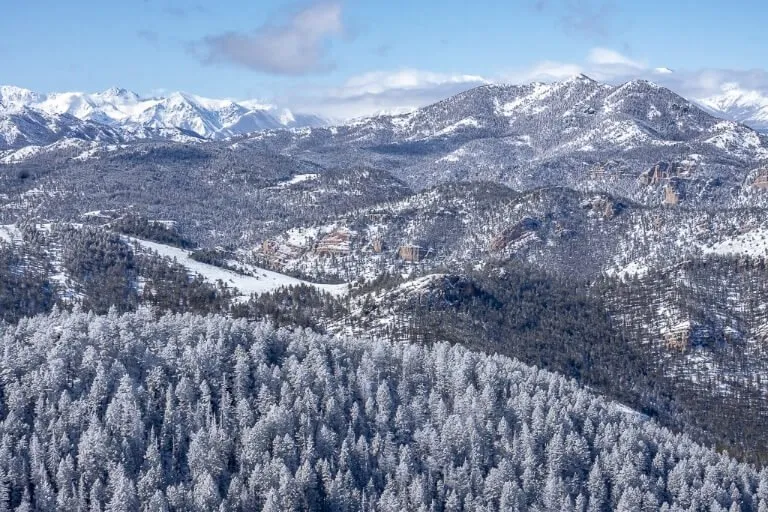
Lamar Valley
Entering via Northeast entrance isn’t always reliable in Spring or Fall, but North entrance is always open. If you can’t enter via Cooke City, it’s easy enough to enter at Gardiner and drive straight to Lamar Valley early in the morning.
Approaching from Northeast / Cooke City – As you draw closer to Grand Loop Road you will pass through Lamar Valley , widely regarded as the best wildlife spotting in Yellowstone.
Try to arrive early morning for the best shot as seeing Bison and other animals. Spend an hour or two stopping at various pull-offs. Remember, if you spot any serious gear, that’s where you need to pull out your binoculars .
Just before Grand Loop Road you will find Specimen Ridge Trail , hike this trail if you didn’t see a lot of wildlife in Lamar Valley, you want to see even more wildlife or you just love hiking.
Tip : By getting away from the road you give yourself a much better chance at seeing animals in the wild.
When you arrive at Tower Junction turn left and drive a few miles to see Tower Fall and if time allows, hike to Yellowstone River Overlook.
Turn around and head back the same way but pass US-212 and continue on Grand Loop Road towards Mammoth.
Your next stop is Yellowstone’s Petrified Tree . Now, this gated tree stump isn’t the most wow-factor attraction you will see on this 4 days Yellowstone itinerary.
But it is around 50 million years old, which means it is in fact, mightily impressive.
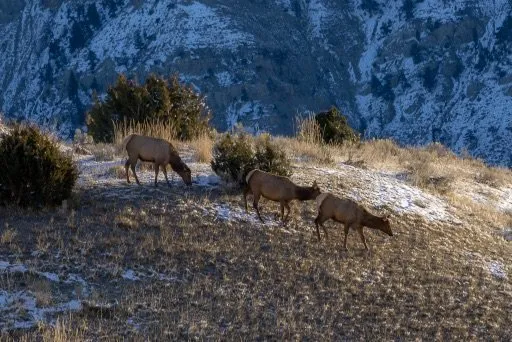
Mammoth Hot Springs
There’s not much else between Tower and Mammoth with the exception of Lava Creek hiking trail. If it’s earlier than you expected, hike this trail past Undine Falls, but if it’s already getting on, it’s time to check in at your Mammoth accommodation.
You’re likely to see mule deer and / or bison wandering around the car park so drive carefully .
You need to check in inside the hotel whether you’re staying in the hotel or a cabin. Mammoth dining hall is directly across the car park ready for once you’re all settled in to your room.
Alternatively, Gardiner is the best place to stay outside of the park boundaries on this first night.
After dinner (depending on light and time of year), drive a couple minutes up to Mammoth Hot Springs for a quick look around the area.
Don’t forget your camera because these terraces are extremely photogenic. It’s a shame the sunset is directly behind a huge hill but you’ll be back here at first light.
Yellowstone Itinerary Day 2 – Mammoth Hot Springs, Norris Geyser Basin, Mount Washburn and Yellowstone Falls
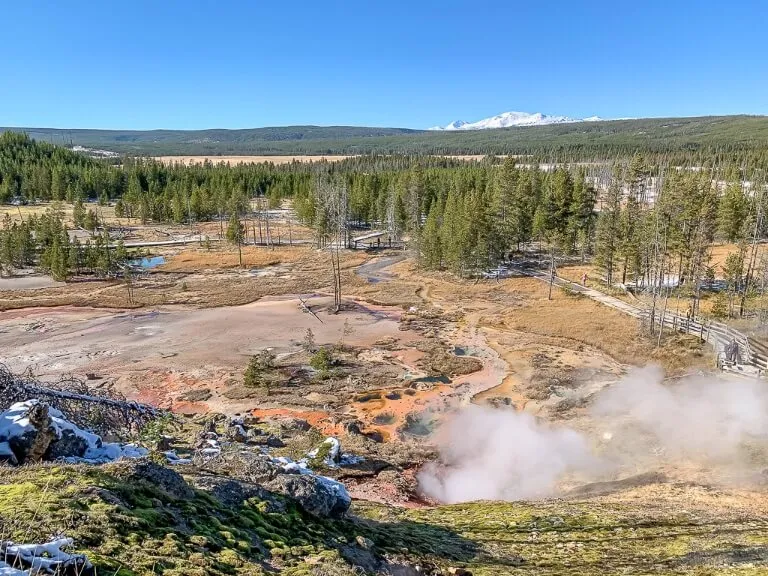
Norris Geyser Basin
Wake up early. If you’re animal mad, head back out to Lamar Valley at sunrise, otherwise make your way over to see the vibrant colors of Mammoth Lower and Upper Terraces and dense steam penetrated by soft rays of morning light.
We’ve seen Mammoth at sunrise and in midday. Sunrise in October was in the snow and stunning but we didn’t last long. Midday is busy but allows you spend more time walking the boardwalks comfortably and better chance to see the radiant springs.
Return to your cabin or the dining hall for breakfast, check out and get on the road heading South towards Norris Geyser Basin . Scenery along the way is gorgeous, stop if you see anything you like the look of but not for too long .
There’s a lot to see today!
Park up at Norris, be sure to look around the educational Visitor Center before spending the next few hours wandering the Geyser Basin boardwalks.
You have plenty of geysers to take in throughout two loops of boardwalks . D on’t miss Steamboat geyser – it was extremely active when we visited.
There are dozens of springs and geysers in all colors and varieties here, just keep following the boardwalks and the crowds.
Echinus geyser is a popular stop, however, this once prolific steam sprayer has become far less inclined to blow its top in recent years.
A few minutes drive South you will find Artist’s Paintpots trail . We highly recommend this quick 1 mile roundtrip hike where you can see deep earthy colors surrounding small hot springs.
In addition, you have an opportunity to get up close and personal with boiling mud bubbling in grey molten clay-like pools. Don’t miss this hidden gem.
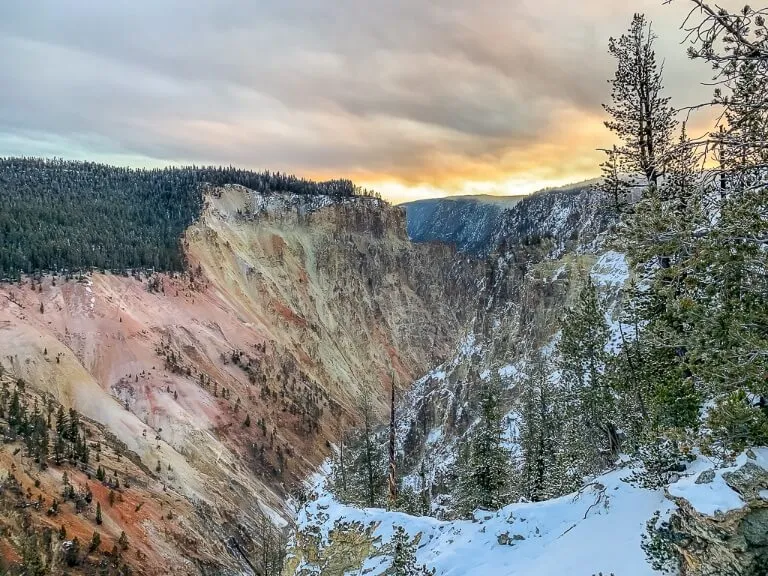
Grand Canyon of the Yellowstone
Take Norris Canyon road due East towards Canyon without stopping before checking in at your Canyon accommodation. If you’re not staying inside the park tonight, book a hotel room in West Yellowstone.
Drive a few miles North from Canyon and park up at Dunraven Pass, before setting off on the most popular hike in Yellowstone National Park – Mount Washburn . Panoramic views from the summit will be worth the time and effort.
Closure : This is the hike we unfortunately couldn’t access and unfortunately it is still scheduled to be closed in 2022 as the road between Canyon and Tower is under works.
- If the road and hike are open, it will be late afternoon / early evening by the time you finish your hike.
- If not, head straight down to Grand Canyon of the Yellowstone.
Drive back past Canyon and turn onto one-way North Rim Drive.
Your first time seeing the powerful Yellowstone Lower Falls is from Lookout point, which is awesome, but less awesome than some of the other viewpoints coming up.
Continue driving round to Grand View, before either driving or hiking (if time allows and you’re not too tired) to Inspiration point – the best observation area along North Rim Drive. It shouldn’t be long until the sun sets directly behind Lower Falls.
At dusk, on the way back to Canyon, drive slowly and look out for wildlife. We saw Bison and a lot of Mule Deer on this stretch with a stunning deep purple sky sunset and moonrise over the plains.
Yellowstone Itinerary Day 3 – Yellowstone Falls, Hayden Valley & Yellowstone Lake
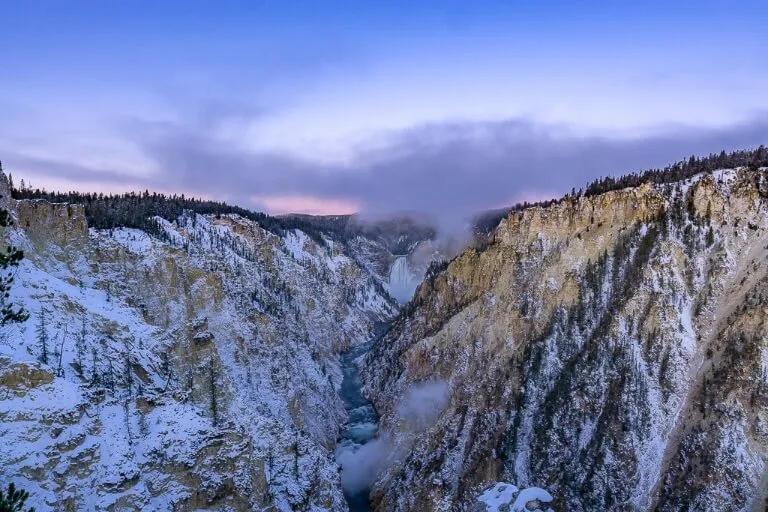
Hayden Valley
Another early start and this one is non-negotiable!
Check out and leave at least 30 minutes before sunrise ( check times here ) so you can get parked, walk the very short trail to Artist Point .
Get your camera set up before the sun rises and illuminates the Grand Canyon of Yellowstone . It’s worth waking up for this iconic Yellowstone sunrise.
On the way back out of South Rim, stop off at Upper Falls View and hike down Uncle Tom’s Trail for an amazing close up vantage point of Lower Falls.
The steep staircase trail descent was not open when we visited so be sure to check trail closures and current conditions before you visit.
Once the sun has risen and you’ve marveled enough at the wonderful canyon, jump back in the car and drive South towards Hayden Valley .
This is Yellowstone’s second major area for seeing animals and if you’re early enough, you’ll have a high probability of spotting wildlife.
The key is not to go looking for the animals, but to park up where nobody else is parked along the Yellowstone River and wait for them to come to you.
You might see a multitude of amazing wildlife, or you might not see any animals at all, it all comes down to chance. Be prepared for both eventualities.
Next up as you head South is Mud Volcano. There’s a short circular boardwalk here covering a number of caldrons and springs, most notably Dragon’s mouth spring .
No need to spend long here and you’ll be hungry by now. Grab lunch at Fishing Bridge / Lake Yellowstone.
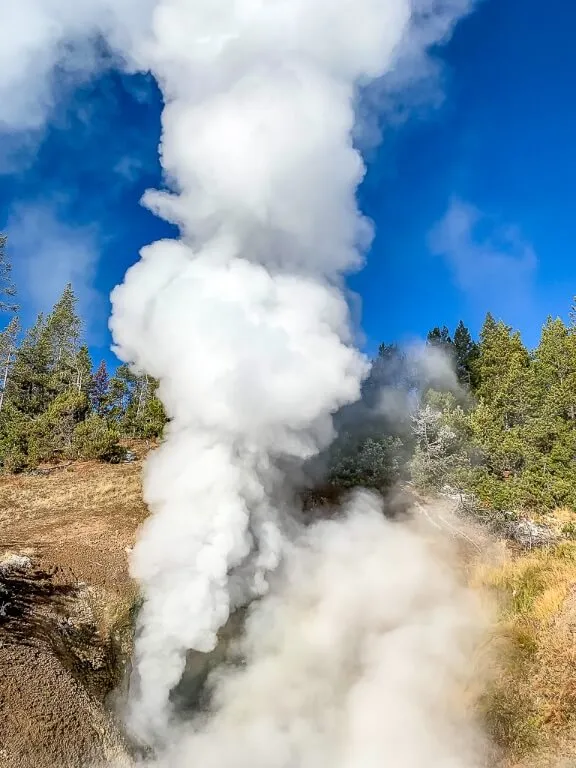
Yellowstone Lake and West Thumb Geyser Basin
Remember that just because an area isn’t recognized as a wildlife ‘hotspot’ it doesn’t mean you won’t see any animals.
We spotted a gang of Elk and more coyotes right on the lake edge around Lake Yellowstone lodge. Explore the area before following the Lake South to West Thumb Geyser Basin.
Spend the remainder of the afternoon walking around West Thumb Basin , taking in the likes of Abyss Pool, Black Pool, Big Cone Geyser and Fishing Cone.
Don’t forget you can take the short Lake Overlook hike right from West Thumb parking lot.
Drive West to Old Faithful and check in to your final accommodation. Again, if you’re not staying inside the park on night 3, book a hotel room in West Yellowstone.
Depending on the time, you can either stick around Old Faithful for sunset or drive 11 miles North to Great Fountain Geyser , which has a magnificent sunset.
Yellowstone Itinerary Day 4 – Lower, Midway and Upper Geyser Basins
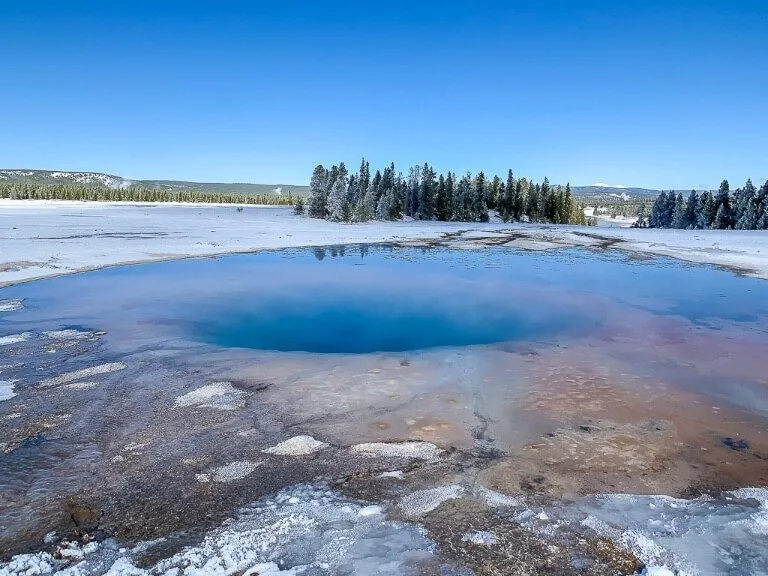
Grand Prismatic Spring
You get to sleep in a little (finally!) on your last day. No rush this morning, you’ll be driving up to Lower Geyser Basin and working your way back down to Old Faithful. Slowly does it today.
It is important to note here – if you want to get photographs of one particular area such as Grand Prismatic Spring, it might be worth beelining straight there first thing in the morning.
Start the day by entering one-way Firehole Lake drive – where you can now visit Great Fountain Geyser if you didn’t the night before.
Opposite the one-way exit from Firehole Lake road, park up at Fountain Paint Pot trailhead and walk the very short trail.
If you missed swimming in Boiling River at Mammoth due to closure, you could drive a few miles North to Firehole swimming area .
Otherwise, heading South once more, your next stop is one of Yellowstone’s finest geothermal features: Grand Prismatic Spring .
Firehole River will likely be engulfed in a cloud of steam as you walk towards Grand Prismatic, giving off an eerie effect. This huge heated cloud is produced by Excelsior Geyser , which was once the tallest geyser at Yellowstone.
Without question, the place will be packed with tourists, so try to be courteous as you walk the relatively narrow boardwalks.
Stop off as much as possible on the looped boardwalk to soak up Yellowstone’s largest hot spring and one of its most iconic features.
If you would like to see Grand Prismatic Spring’s colors in all their glory from above, you will need to drive a few minutes to Fairy Falls Trail and hike a 1 mile round trip trail to GPS overview.
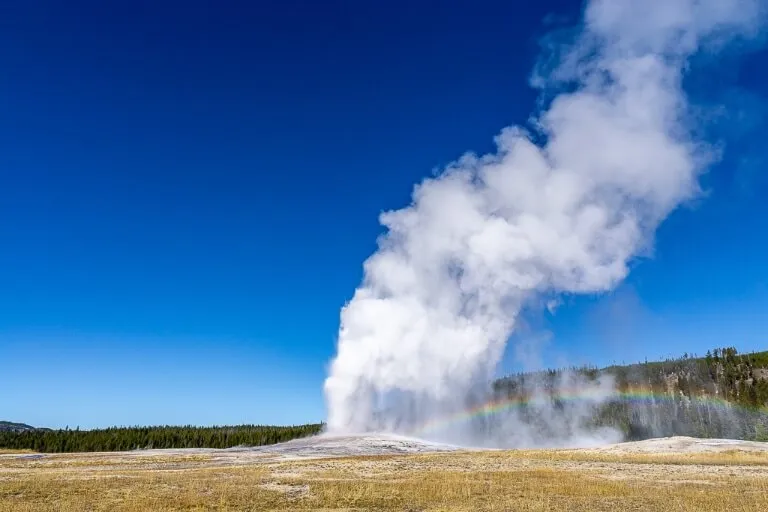
Old Faithful
Finish your 4 days in Yellowstone itinerary back where you started this morning at Old Faithful .
What better place to sign off an incredible experience than its most iconic feature. Check times of eruptions, noted all around Old Faithful area including the dining halls. Plan to arrive 10-15 minutes before the predicted eruption.
The bleachers will be busy so be sure to walk around and behind Old Faithful, before taking the Observation Point trailhead to a much better vantage point.
The crowds will cheer once Old Faithful begins to erupt and you will have finally seen the most famous geyser in the world spurt its hot steam into the deep blue sky above!
Don’t forget that you are in Upper Geyser basin, the most active of all geothermal areas within Yellowstone and more than a one trick pony.
Behind Old Faithful – past the trailhead for observation point – you can follow a path leading to multiple hot springs and geysers.
Geysers : We highly recommend you do spend time walking behind Old Faithful as far as incredibly vibrant Morning Glory Pool, one of our favorites in the entire park.
Exit Yellowstone via the South entrance towards Grand Teton National Park. If you like to kayak, Lewis Lake on the way out of Yellowstone is the best place in the park to paddle .
There’s plenty of time left on Day 4 to make it down to Jackson, WY with a few detours along the way in Grand Teton.
It’s almost like you planned it that way!
Best Time to Visit Yellowstone National Park
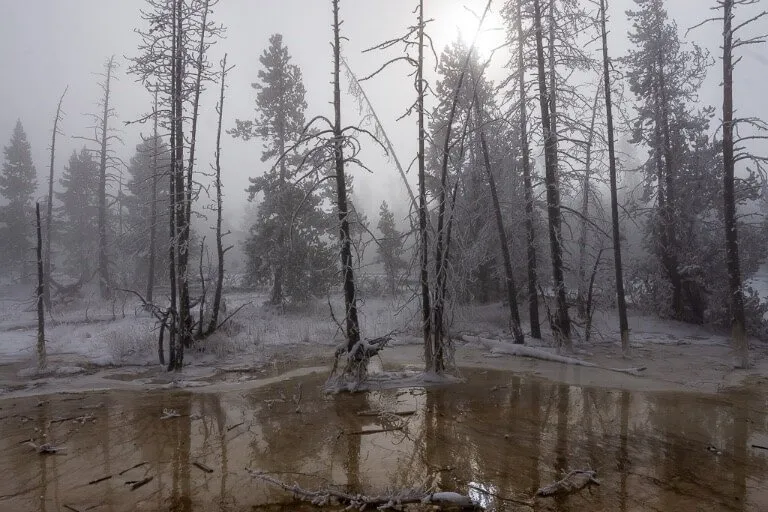
Animals are very active as they come out of hibernation, grizzlies are very grizzly so care must be taken. Snow melting causes waterfall volumes to increase and the weather begins to warm slightly. May and June are excellent months to visit Yellowstone before it gets too crowded.
April in Yellowstone is interesting, you will have attractions almost to yourself but road access is limited and no park lodging is open.
Summer in Yellowstone is jam packed with tourists, which personally isn’t our cup of tea. However, you get more daylight and warmer temperatures which means perfect conditions for crushing hikes, sightseeing and comfortable camping.
Of 4 million annual visitors to the park, over half visit in July and August. Not only will every attraction be busy but getting a camping spot or hotel room would be tough going.
When we visited Yellowstone in October it had snowed heavily just a few days before our arrival. The scenery was staggeringly attractive, with glittering ice and snow dancing under sunlight.
It was the first big snowfall of the year so we just missed those beautiful rustic fall colors. September would be a fantastic alternative if you prefer to avoid crowds and enjoy cooler temperatures.
Yellowstone in Winter
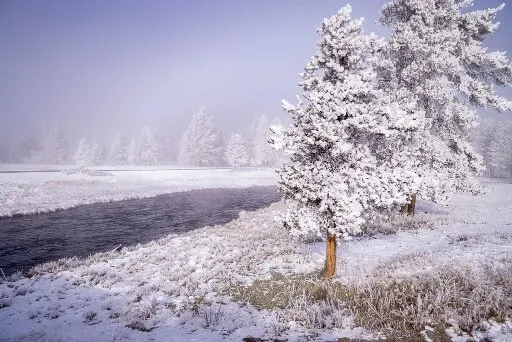
Although we didn’t technically visit in Winter, both April and October had a ton of snow and cold temperatures. Most of the park shuts down in Winter and access can only be achieved by snowmobiles.
Our photographs will give you an idea of what Yellowstone would look like if you were to visit in Winter. We were blown away by the ‘Winter Wonderland’ scenery and felt fortunate to have visited when we did.
Following a huge snowfall, the temperature stayed below zero for 3 days but the sun was shining brightly from a deep blue clear sky every day.
On our second morning in October we woke up to a thick mist and fog which left Yellowstone feeling positively spooky!
Yellowstone Accommodation
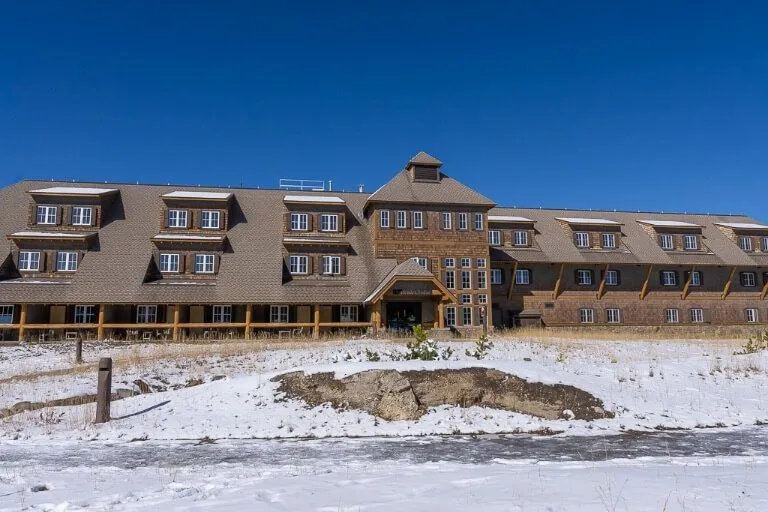
Certain US National Parks can be notoriously difficult to secure accommodation. Yellowstone is one of those parks.
There are options inside the park (as we listed in each region earlier) but they are in high demand and can be out of many visitors’ budget range. You can instead stay at hotels near the park boundary.
Either way, you need to be as organized as possible when it comes to booking your Yellowstone lodging. Start booking as soon as you have dates to avoid missing out on rooms inside the park or at good value near the park.
We think booking hotels, lodges or cabins is the most difficult and important part of planning this vacation. Once rooms are secured, you can begin to plan your Yellowstone itinerary.
Resources and Tips
- Lodging – We have written an extremely popular where to stay in Yellowstone guide to help you figure out the best places to stay for your visit. It has helped thousands of visitors to find lodging around the park.
- Hotel tips – If you decide to stay outside the park in hotels, you have control over budget. Read our ultimate guide to booking cheap hotels to learn about ways you can save money.
- Booking platform – We always use and recommend booking hotels with Booking.com for best value and most options to suit your budget.
- Camping – Take advantage of our exclusive 30 day free trial of The Dyrt PRO to get reservations at sold out Yellowstone campgrounds with no extra booking fees, and gain access to free dispersed camping locations around Yellowstone National Park. You can try The Dyrt PRO for free, no strings attached!
- The earlier you book, the more chance you have of securing the exact locations you prefer. Be flexible and adaptable if planning your vacation last minute.
Suggested Lodging for this 4 Day Itinerary
- First Night – Mammoth Hot Springs or Gardiner MT
- Second Night – Canyon
- Third Night – Old Faithful or West Yellowstone
- Fourth Night – Jackson WY
Note this is a North to South route. If your entrance and exit points will be different, plan your accommodation accordingly.
If you want to take a much closer look at the top rated hotels around Yellowstone, head over to our sister site Best Hotels Anywhere to see the best hotels in West Yellowstone, Gardiner, Cody and Jackson.
You can only book accommodation inside the park using Yellowstone National Park lodges service, which means set prices and limited availability.
Expect to pay handsomely for hotel rooms if you stay inside the park, it is Yellowstone after all!
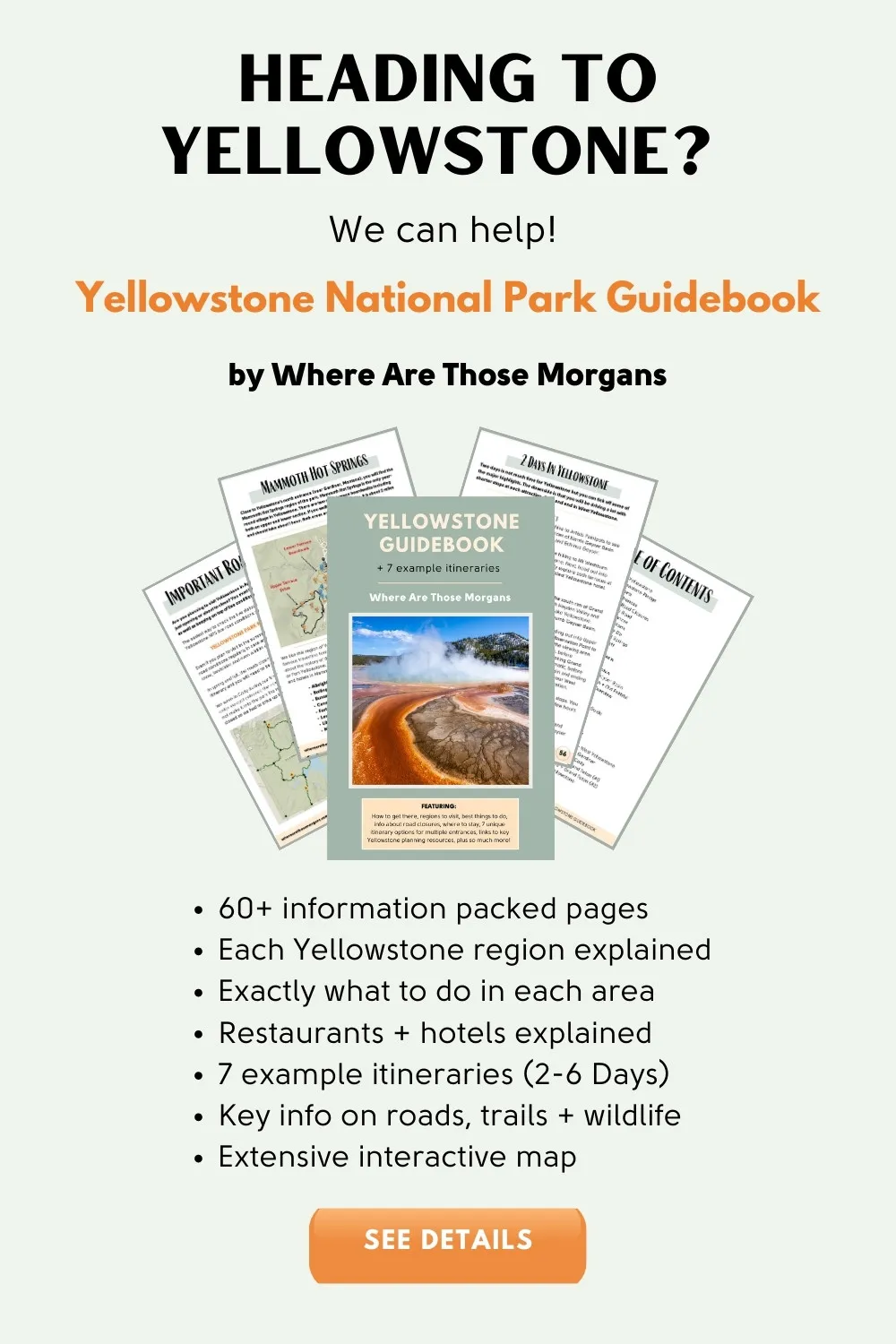
Read More About Yellowstone and Grand Teton …
- Things To Do: 30 Most Popular Things To See And Do In Yellowstone National Park
- Airports: 6 Best Airports Near Yellowstone for Domestic and International Travelers
- Hotels: Where to Stay Inside and Near Yellowstone – Best Hotels and Locations
- Spring: 10 Key Things To Know About Visiting Yellowstone In April
- Fall: 10 Important Things To Know About Visiting Yellowstone In October
- Grand Teton: 7 Amazing Things to do and Perfect 2 Day Itinerary
- Mormon Row: Sunrise and Sunset Photography Guide to Mormon Row Grand Teton
- Schwabacher Landing: Complete Photography Guide to Stunning Schwabacher Landing
Yellowstone Road Trips:
- SLC – Salt Lake City to Yellowstone 7 Day Road Trip Itinerary
- Rushmore – Mt Rushmore to Yellowstone 10 Day Road Trip Itinerary
More Incredible US National Parks …
- Death Valley: Perfect One Day Death Valley Road Trip Itinerary (Las Vegas and Yosemite)
- Zion & Bryce Canyon: Epic 3 Day Road Trip Zion and Bryce Canyon Best Bits
- Yosemite: The Ultimate Guide to Yosemite For First Time Visitors
- Grand Canyon: Perfect One Day Itinerary Grand Canyon South Rim
We hope this guide helped with planning your 4 Days Yellowstone National Park Itinerary!
Yellowstone is one of the very best places to visit in the USA and we sincerely hope you have the most amazing vacation to this special part of the world.
Please let us know if you have any questions or you need any help planning your Yellowstone trip, we’ll be happy to help.
Happy Travels ,
Mark and Kristen
Was This Post Helpful? Pin It For Your Yellowstone National Park Itinerary!
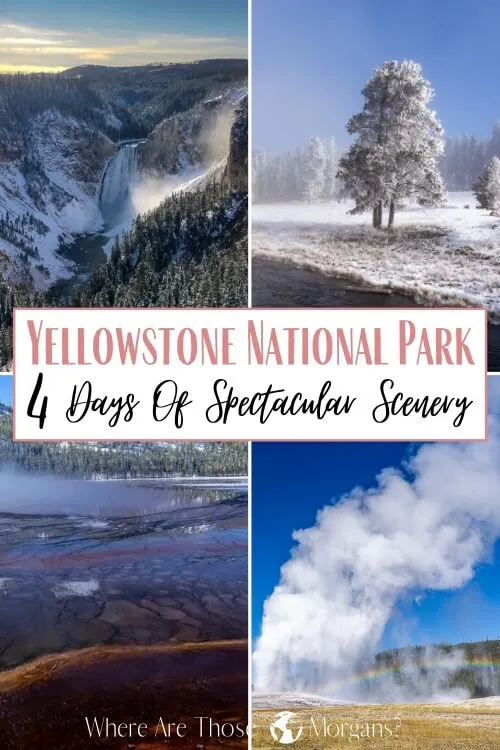
Note : This article contains affiliate links. When you make a purchase using one of these affiliate links, we may earn a small commission at no extra cost to you.
All Rights Reserved © Where Are Those Morgans, LLC. Republishing this article and/or any of its contents (text, photography, maps, graphics, etc.) in whole or in part is strictly prohibited.
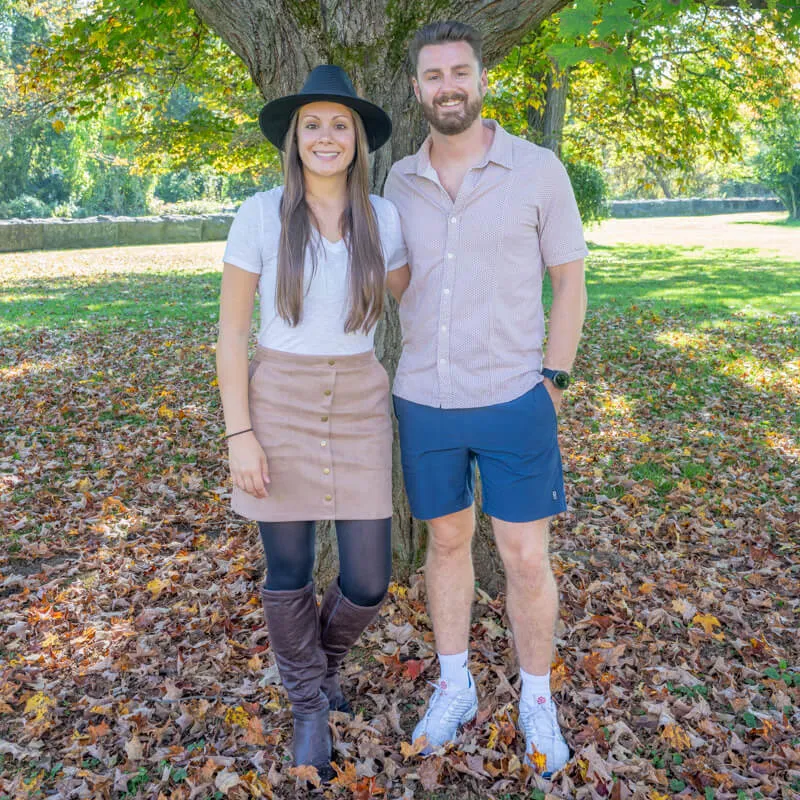
Mark and Kristen Morgan are travel, hiking and photography experts. Over the last 6 years traveling full time, they have explored more than 40 countries and 30 US states.
Where Are Those Morgans has been featured in USA Today, Gestalten, Get Your Guide, CityPASS and Condé Nast Traveler along with various other publications. Read more about us .
24 thoughts on “Yellowstone Itinerary 4 Days: The Ultimate First Time Visitor Guide”
Hello, I am driving from spokane to Teton on June 7th. I want to do teton, YN and glacir and drive back to spokane. So I think it would be best for me to stay in jackson or teton for one night and then drive up to west entrance for 2 nights and stay in Gardiner for one night because my plan is to do teton in one day 3 or 4 days for Yellowstone and then drive on to Glacer national park. I know it makes perhaps more sense to to go Glacier first and then drive down to YN and to teton but I have to take a return flight from spokene and Galcer sun road is not open untill June 15th or so, so I decided to drive down to Teton via Misoula and then drive up so I reach Galcier park around 13th or 14th and have more chances to see the sun road. I know it is driving double a little but looks like best optin to me. I am also doing this loop so I can take the car from spokane and return it at spokane. Taking a car from spokane and returning at teton is very expensive.
Am I on right track?
Hi Anjana, yes it sounds like you’re exactly on track with your plans. That’s exactly what we would do in your circumstances. Have a great trip!
How long does it take to get a guidebook to Yellowstone? Is it downloadable?
Hi Melissa, yes our Yellowstone guidebook is a digital download so you can get it instantly to your phone and computer. Thank you and have a fantastic trip!
Looking to also go in through Cooke City. Any recommendations on where to stay in Cooke City that night before entering the park? Thanks!
Hi Bret, glad to hear you will be visiting Yellowstone soon. Take a look through our where to stay in Yellowstone guide to see our hotel recommendations for Cooke City. It is a great place to start because you get instant access to Lamar Valley for wildlife at dawn. Have a great trip!
is there an actual print out of just the 4 day yellowstone itinerary? point to point to see?
Hi Tricia, At the moment we do not have a printable version of this itinerary, but we hope to have one soon. You are more than welcome to print out the travel guide and if you have any specific questions about Yellowstone, feel free to ask any time. Have a great trip!
Yikes! We are planning a trip this summer starting in South Dakota and heading into Yellowstone for 4 day. Unfortunately we have to go in the summer since I work at a high school. Yellowstone is so overwhelming and it looks like we will be entering Yellowstone the week of July 4th. Planning is so overwhelming 🤪 We will be pulling our RV as well. There are no campsites available in Yellowstone so hoping to find something not too far away. Since we will be driving in each day which entrance makes themost sense or should we split time between a couple of. Entrances?
Hi Holly, we are glad to hear you have a trip planned to Yellowstone but “yikes” is definitely a great word to describe your situation! If it were us, we would try staying at a campground in or around Gardiner the first and maybe second night, then staying at a campground in West Yellowstone for the next 2 nights. We have driven from South Dakota to Yellowstone twice, entering once into northeast entrance and once into north entrance at Gardiner. Your drive over on I-90 won’t be very exciting but for you it will be about efficiency and getting to Gardiner as quickly as possible is your best bet. Then you can see the “top half” of Yellowstone in the next 2 days, before pulling your RV to a campground in West Yellowstone so you have easier access to the “bottom half” of Yellowstone. Hope that helps and best of luck getting booked up. Have a great trip!
I’m so grateful to have found this site. It’s amazing! You are so thorough and organized – I am in awe. Without this guide I would have just booked a full week in West Yellowstone and then spent most of my days driving and being stressed about being in the park after dark. Now I think I’ll book 4 nights at YGI and 3 nights in Jackson. I have dogs, so I can’t stay in the park or move around too often. We primarily want to see wildlife – I hope we see a wolf!!!
Thank you Noelle, we’re glad our guide has helped you plan your trip to Yellowstone! Last time we visited we saw a wolf near Grand Prismatic Spring, just look for a group of people with expensive cameras / binoculars / telescopes and it’s either a wolf or a bear. Have a great time!
Hi, how does one find out the driving time or distance to different areas within the parks – Yellowstone and GTNP?
Hi ALice, thanks for getting in touch with a great point – we have updated our Yellowstone itinerary with a driving distance chart to show how far it is between the major regions in Yellowstone and Grand Teton. We didn’t include times because that will change heavily depending on season but it should give you a better idea of how much driving will be involved during your visit.
Wow thanks for taking the time and sharing all that info! With that said, it is a bit overwhelming 🙂 appreciate your help in planning my trip with my teenage daughter in early July 2022. We’re flying in from San Francisco for 4 days. Is there any way to contact you directly? Thanks
Hi Meytal, yes planning a trip to Yellowstone can be overwhelming! Head over to our contact page and send us a message with any questions you have for your trip 🙂
Great article, thank you for the detailed information. We are headed for 4 days with a stay booked at the West entrance for all nights. All things considered, would you advise that I keep that spot or split it up between other entrances? All of the lodging INSIDE the park is booked up…so our only options would be to head out of the park for overnights. Looking at your itinerary for the 4 days it looks like staying where we are may just be the best option vs moving each night out to the North and then the East entrances…what do you think having been?
Hi Mel, yes getting booked inside the park is going to be a challenge this year. Stick with what you have booked in West Yellowstone for the 4 days. It’s the most central location with easier access to each of the areas inside the park. We were in Yellowstone again a few weeks ago and stayed in West Yellowstone both nights. It is a bit of a pain driving in and especially out each day as you drive directly into the sunset, but it’s by far the best option for keeping drive time down. That being said, if you are really keen to see wildlife, Lamar Valley at sunrise is your best bet and staying one night in either Gardiner (North entrance) near Mammoth or even Cooke City (Northeast entrance) would cut your driving time down significantly early in the morning. You will see wildlife without doing that but it would likely be a better experience. The drives East to Cody and South to Jackson are too long. Let us know if you have any more questions and have a great trip!
planning a trip for the summer, reading through piles of pins about Yellowstone and this is the most helpful yet! thank you so much!
Thank you Chelsea, we’re glad you were able to find the info you needed for Yellowstone. Please let us know if you have any questions about your plans but if not have a great trip!
This is such a helpful and informative review! With limited time in Yellowstone, we will be following your suggestions, but in reverse, coming up from Tetons.
Thank you Sarah, we’re glad you found it helpful – doing both Grand Teton and Yellowstone is such an amazing trip. Please do let us know if you have any questions about either park and have a great time!
Wow this has to be the best national park yet, something for everyone there, it must of been amazing.
Yes this was one of the most diverse US National Parks we visited, you’re spot on with something for everyone. We had a love / hate relationship with the snow, it was freezing cold and we might have missed out on some wildlife spotting opportunities, plus the Mt Washburn hike was closed and we couldn’t see much at Grand Prismatic Spring – but the Winter Wonderland scenery was unique and spectacular. Hope you are able to visit Yellowstone one day Graham!
Leave a Comment Cancel reply
Subscribe to our newsletter
Get the latest in travel straight to your inbox
Click here to subscribe
Yellowstone | Grand Teton | Winter Glacier | Badlands

Free Yellowstone Trip Planner
Download our free stunning Yellowstone Trip Planner filled with an inspiring itinerary, gorgeous photographs, a park map and everything you need to plan your dream vacation. Order this insider’s guide to Yellowstone today to get tips on how to get there, what to do and where to stay.
Get even more trip planning information in our email newsletters and by selecting to receive email and/or mail from our Yellowstone travel partners.
Featured Partners
Customize your Yellowstone travel guide based on your road trip or airport approach to the park. On the form above, select to receive trip information directly from vacation partners for the regions you will be vacationing in.
Grand Teton National Park to Yellowstone
Discover the beauty of Yellowstone's neighbor national park to the south, Grand Teton, and its neighboring town, Jackson.
- Signal Mountain Lodge in Grand Teton National Park - Stay at the only resort located on the shores of Jackson Lake in Grand Teton National Park, with camping and boat rentals available.
Salt Lake City to West Yellowstone
One of the most direct routes to Yellowstone launches in Salt Lake City, with attractions all its own, and travels up the west side of the Teton Mountain Range. Stunning wildlife, ski towns and western culture dominate this tour.
- Diamondville/Kemmerer Area - Gateway to the Bridger and Teton National Forest, including Yellowstone. Unearth a fossil, visit the JC Penney Motherstore and camp in the Hamsfork Recreation Area .
- Southeastern Idaho - The 11 communities of Southeast Idaho have museums, an historic state park, hot springs, Bear Lake and fantastic wildlife-watching for the Yellowstone and Grand Teton vacationer .
- Eastern Idaho's Yellowstone Teton Territory - Eastern Idaho is full of adventure and great outdoor activities such as Yellowstone Bear World, fly-fishing, biking, rafting and camping.
- Flaming Gorge Country - Halfway between Yellowstone and Arches National Parks is an unspoiled playground of stunning natural features. Flaming Gorge National Recreation Area offers year-round adventure for families of all ages. Scenic trails. Superb boating. DIY rafting. Trophy fishing. Wow. Flaming Gorge is a ‘must see’ stop on your next western journey.
- Cache Valley, Northern Utah - Stay a day and explore Logan, Utah. Famous for outdoor beauty, hands-on heritage experiences, food tour and performing arts.
- Salt Lake City, Utah - Salt Lake is a combination of metropolitan city and quaint mountain town; the towering Wasatch Mountains embracing Salt Lake offer a dramatic backdrop to the vibrancy and activities of downtown.
- Park City, Utah - Discover the endless activities this charming mountain town has to offer including hiking and biking on over 400 miles of trails. After a day of adventure, explore the shops, galleries and restaurants on Historic Main Street and wind down with a local craft beer or whiskey.
- Dinosaurland - One of the West's biggest secrets is northeastern Utah, an easy day's drive south of Yellowstone National Park. Some call it Dinosaurland, and you'll find it offers adventure and sites not seen anywhere else in the world.
- Bear Lake Valley - Come to the "Caribbean of the Rockies" with an intense turquoise blue lake. Jet ski, go sailing, boating, fish, swim and play on our sandy beaches. Winter offers snowmobiling, ice fishing and snow skiing.
- Yellowstone Vacations - Stay in West Yellowstone, Mont., and you will be one step closer to enjoying the majestic scenery of the national park. The west entrance is the closest entrance to world famous Old Faithful geyser and Grand Prismatic Hot Spring.
- Days Inn by Windham West Yellowstone - Conveniently located off highways 191 and 20, this hotel near Yellowstone’s West Entrance offers great value and quick access to the most popular attractions in the area.
- Natural Retreats Park City - Handpicked for prime mountain access and high-end amenities, these vacation rentals include private homes nestled on the slopes, luxury lodge condos at Silver Star, and ski-in, ski-out estates in gated communities at both Deer Valley Resort and Park City Mountain Resort.
Yellowstone to Glacier National Park
On the north side of Yellowstone, you'll find wildlife galore along the banks of scenic rivers. But there is culture here too. See a world-class art museum, hot springs, historic towns and high peaks under Montana's big sky on the way to Glacier National Park.
- Montana’s Glacier Country - Home to iconic Glacier National Park, Western Montana’s Glacier Country is a region that needs to be explored. It’s time to discover your Montana moment.
- Great Falls, Montana - Resting on the high plains along Montana’s Rocky Mountain Front Range, Great Falls is located at the confluence of the Missouri and Sun Rivers, the ideal gateway for your Genuine Montana experience.
- Missoula, Montana - Situated halfway between Yellowstone and Glacier National Parks, Missoula is an impeccable balance of ultimate adventure by day and unique, hip culture at night.
- Southwest Montana - Hemmed by the snow-crowned peaks of Glacier National Park to the north and the geological marvels of Yellowstone National Park to the south, this vast region holds the best of Montana.
- Visit Yellowstone Country - This unparalleled year-round vacation destination, made up of five Montana counties: Gallatin, Park, Sweet Grass, Stillwater and Carbon, offers recreation, lodging, dining, seasonal activities and cultural treasures.
- Visit Helena - Helena truly offers an extraordinary range of mountain biking and convenient trailhead shuttles. Or get out on a hike or boat the waters at Gates of the Mountains. After your adventure, drop into town where five microbreweries await.
- Central Montana - Wide-open spaces. Gracious people. Where a rugged past meets a vibrant present. Central Montana remains an authentic experience unlike any other.
- Gardiner, Montana - Quaint, Old West-style Gardiner sits on the north edge of Yellowstone, making it a convenient gateway town. It's the only year-round entrance to the park.
- Big Sky, Montana - Tucked in the flanks of the green mountains that roll up to Big Sky Resort, come to Big Sky for world-class recreation such as hiking, biking, rafting and in the winter, skiing.
- Natural Retreats - Offering Big Sky vacation rentals to suit every vacation style, from mountain chic slopeside homes to grand hilltop chalets and modern condos.
Chicago to Rushmore to Yellowstone
Take your family on the All-American road trip starting in the Midwest and traveling through South Dakota's Badlands on through Wyoming's cowboy country to Yellowstone. Explore the Black Hills, Devils Tower and more en route.
- Drive the Safest and Easiest Route to Yellowstone - See hidden treasures on the way to Yellowstone via HWY US 16: The Cloud Peak Scenic Skyway, Ten Sleep Canyon, Petroglyphs, Ancient Mammoth Hunters and Museum.
- Billings, Montana - Billings is the scenic home base for Yellowstone trips and a wild West destination in its own right. In the heart of southeast Montana, Billings is knows as "Montana's Trailhead."
- Southeast Montana - Visit epic battlefields, breathtaking canyons, museums, dinosaur dig sites and more en route from the Black Hills to Yellowstone National Park.
- Crazy Horse Memorial - Near Mt. Rushmore in South Dakota, another rock carving in process honors Crazy Horse, the legendary Lakota leader, and his people.
- Missouri River Country - This unspoiled land offers a fantastic getaway for those who truly enjoy the outdoors and have a spirit of adventure - from hunting and fishing to exploring the history of dinosaurs and Lewis and Clark.
- Rapid City, South Dakota - Explore nearby South Dakota national parks, learn about American heroes, take in local arts and culture, explore the outdoors and indulge in a unique dining scene in Rapid City.
- Park County Travel - Explore the communities of Buffalo Bill’s Cody Yellowstone and see that the Wild West isn’t so wild after all. Find welcoming accommodations, fine restaurants and plenty of adventure.
Denver to Yellowstone
Start your trip to the park in the heart of the Rocky Mountains. Then travel through Wyoming's southern cowboy towns and native nations before exploring Yellowstone's southern ranges.
- Sweetwater County, Wyoming - Take a national park road trip & fill up on adventure, history and the cowboy spirit in Sweetwater County, Wyoming, the perfect stopping point to refuel and rediscover.
- Carbon County, Wyoming - Carbon County is a year-round destination for anyone who enjoys the great outdoors. We say, “Star count is more important than thread count."
- Cheyenne, Wyoming - Get a cowboy’s welcome at the place known for the world’s largest rodeo, Old West museums and huge painted boots scattered about town.
- Colorado State Parks & Wildlife - Colorado’s 42 state parks are places to have fun, get away and recreate in beautiful settings. Book your camping reservations or find activities across the state.
- Moffat County, Colorado - The 1.7 million acres of pristine, picturesque public lands, abundant wildlife, wild horses, and untamed rivers define Moffat Country.
- Casper, Wyoming - World-class fly-fishing is not the only game in town. From a rowdy ride on a pioneer wagon to a hike up Casper Mountain, you’ll be doing your own trailblazing.
- Laramie, Wyoming - Explore a colorful historic past and some of the region’s best scenery. Find unparalleled adventure within a short drive of the city or visit the historic downtown with great lodging, art culture, nightlife and unique shopping.
- Wind River Country - Towns like Riverton, Lander, Dubois and the 2.2 million-acre Wind River Indian Reservation offer incredible outdoor recreation and the history of Wyoming from the Mountain Man to wild mustangs.
Tour Guides and Tour Apps
Don't miss a thing by following an expert - a literal "Yellowstone Travel Guide."
- GuideAlong - Get the driving app that’s like having a tour guide in your car. GuideAlong automatically plays interesting and entertaining commentary as you go.
- Active Adventures - Explore the best of the world’s most beautiful destinations, from the well-known to the well-hidden. Discover natural wonders and dynamic cultures with expert guides leading the way and every detail handled from start to finish.
About Outside Interactive, Inc.
Home » Itineraries » Yellowstone National Park Itinerary
Yellowstone National Park Itinerary
One hour, one day or one weekend in yellowstone national park..
A dynamic volcanic hotspot that also boasts more than 1,000 miles of hiking trails, nearly 300 waterfalls and the largest concentration of mammalian wildlife in the lower 48 states? That’s what we call a national treasure. Here’s how to cash in on Yellowstone’s riches, no matter how much time you have to spend.
Itinerary Overview
Route Distance:
40 miles (1 Hour)
55 miles (1 Day)
150 miles (2 Days)
Suggested Time:
1 Hour, 1 Day, or 2 Days
1 Hour: Steam Train
Old faithful geyser.
If you’re aiming for the Yellowstone speed record, make a beeline for the park’s most famous feature: Old Faithful Geyser. With approximately 20 eruptions every day, this reliable geyser’s frequency can be predicted with 90 percent accuracy, within about 10 minutes. Avoid the crowds with an early morning visit, then tuck in for a hearty breakfast at the Old Faithful Inn, a true icon of pioneer architecture.
1 Day: Hot Water
Geyser basin or lone star geyser.
While you can’t see all of Yellowstone in a single day, it’s relatively easy to prioritize the fascinating geothermal features for which the park is known. Starting at the park’s south entrance, head north to the West Thumb Geyser Basin, on the edge of Yellowstone Lake. Two short boardwalk loops will take you past the steaming Thumb Paint Pots, vibrant Abyss Pool and miniscule Fishing Cone. Before you leave, check in at the nearby ranger station to find out when Old Faithful is likely to erupt next.
Or, if you’re the road-less-traveled type, skip the attraction and make the easy 5-mile hike to Lone Star Geyser, which erupts every three hours for a full 30 minutes. Your journey along the Firehole River will reveal colorful bacteria mats and hissing fumaroles, too.
Midway Geyser Basin
Your next stop is Midway Geyser Basin, also known as Hell’s Half Acre for the vaporous clouds clinging to its banks. The main attraction here is Grand Prismatic Spring — the third-largest hot spring in the world, this colorful pool is bigger than a football field and 10-stories deep. Its enchanting spectrum is caused by the different species of heat-loving bacteria that live in the spring.
Firehole Lake Drive
Next, off the Grand Loop just south of Madison. Take Firehole Lake Drive, a 3-mile scenic jaunt past at least a dozen geothermal features. If you’re lucky, you’ll catch one of Great Fountain Geyser’s breathtaking and highly unpredictable displays. Then, head back to West Thumb for a casual waterfront dinner at the Grant Village Lake House.
1 Weekend: North Score
To experience total immersion during your quick weekend in the park, camping is always a great bet (choose from over 2,000 sites spread across 12 camping areas). Norris Campground — located in the visibly dynamic geyser basin of the same name — is a solid central base for exploring and offers evening campfire programs nightly, June through September.
Mammoth Hot Springs
If you’re coming in through the park’s north entrance, Mammoth Hot Springs will set the tone for your weekend. With a fantastical landscape straight out of Middle Earth, it’s like a limestone cave turned inside out. Two boardwalks give you access to more than 50 geothermal features — including free-standing Liberty Cap, colorful Minerva and Palette springs, and Angel Terrace. History buffs will enjoy a quick side trip to Fort Yellowstone, just a stone’s throw from the springs.
Artist Point
With an early start, you can tour the springs area and still score a site at Norris by 10 a.m. Break to make camp and lunch, then it’s off to Grand Canyon of the Yellowstone. This 20-mile-long, 1,000-foot-deep natural work of art is best explored on foot, with the canyon’s colorful walls rising around you. There are 10 official overlook spots in the canyon, and Artist Point is one of the most popular. After uttering your oohs and aahs at this spectacular view of Lower Falls crashing into the abyss, leave the paved trail and keep hiking along the canyon’s south rim to Point Sublime.
Lamar River
Nature-loving anglers can kill (or rather, catch and release) two birds with one stone, as the tranquil Lamar River offers some of Yellowstone’s best fly-fishing. Surrounded by rolling verdant hills in all directions — and interrupted only by glimpses the valley’s plentiful fauna — visitors can expect to hook both rainbow and native Yellowstone cutthroat trout sized in the upper teens.
Yellowstone Lake
This afternoon, you’re headed due south for an up-close-and-personal view of Yellowstone Lake. The largest high-elevation lake in North America and nearly 400-feet deep in places, it’s too cold for swimming but is wonderful to explore by kayak or canoe.
Because of the lake’s many hidden underwater geysers, submerged fumaroles and other geothermal features, we recommend a guided tour with one of the many outfitters in the area. After your paddle, enjoy a rewarding dinner in the charming Lake Yellowstone Hotel Dining Room before bidding farewell to the park — until next time.
[OPEN MAP IN NEW WINDOW]
Hit the road with other great itineraries.
Wyoming’s open roads and beautiful scenery make it an ideal state for a road trip.

PET-FRIENDLY ACTIVITIES
Pets are not allowed on boardwalks, hiking trails, in the backcountry, or in thermal areas at Yellowstone, but there are plenty of activities just outside the park for you and your pup.
If you are planning on bringing your dog with you to the park, make sure to check out these regulations from NPS .
- Take a lap around Earthquake Lake.
- Go for a stroll through West Yellowstone. You’ll find various pet-friendly coffee shops and retailers to visit.
- Hike Coffin Lakes Trail, a moderate hike with stunning views and stream crossings.
- Don’t miss out on the popular Old Faithful geyser. Dogs are allowed on the sidewalks around the visitor center with a leash.
- Have a picnic at Yellowstone Lake and let your dog dip their paws in the chilly water.

Enjoy comfortable, modern, amenity-rich lodging when you stay outside Yellowstone National Park.

Wildlife Viewing
Yellowstone is home to more than 200 species of animals, and spring is one of the best seasons to see them in action.

West Yellowstone Snowcoach Tours

Gardiner Snowcoach Tours

Yellowstone Vacation Snowmobile Tours

Two Top Snowmobile Tours

West Yellowstone Summer Bus Tours

Yellowstone Vacations Snowmobile Rentals

Two Top Snowmobile Rentals

Car Rentals
Tips for Planning a Yellowstone RV Trip
The first national park in the U.S. offers spectacular sights and plenty of space. Taking an RV trip to Yellowstone can feel daunting—but with some extra planning, it’s absolutely worth it.
By Gretchen Holcombe & Roadtrippers
When approaching Yellowstone National Park from the east, your first view is of the vast, wild, and eerie landscape formed by ancient volcanoes. It’s shaped by thousands of years of thermal activity and scarred in more recent times by fire. As you drive farther into the park, the vastness is shared with visitor centers, traffic, and crowds.
A Yellowstone RV trip can be overwhelming to plan and execute, but it’s absolutely worth it. Yellowstone offers spectacular landscapes with one-of-a-kind terrain and geological surprises at every turn. It’s a place every U.S. traveler should visit, but figuring out the best way to explore the park’s 3,472 square miles can be daunting.
The good news is that much of the trip planning has already been done for you—just follow the park’s two big loops. RVers can cover ground at a decent pace by planning which stops to make along the loop each day. As you plan, keep in mind that you won’t be able to see everything (after all, the park spans three states), and it’s perfectly okay to just hit the highlights on a first trip and to save certain sights for another time.
Some General Advice for Visiting Yellowstone
It’s difficult to recommend an ideal trip length for a Yellowstone RV trip because there’s just so much to see. An RV trip to Yellowstone generally involves long days with lots of driving and crowds, which can cause exhaustion for even the most seasoned traveler. If you’re planning your first RV trip to Yellowstone National Park, you should give yourself at least five or six days, with a planned rest day where you stay close to the campground. This trip length is manageable for most people, but still allows for enough time to see many of the park’s best sights.
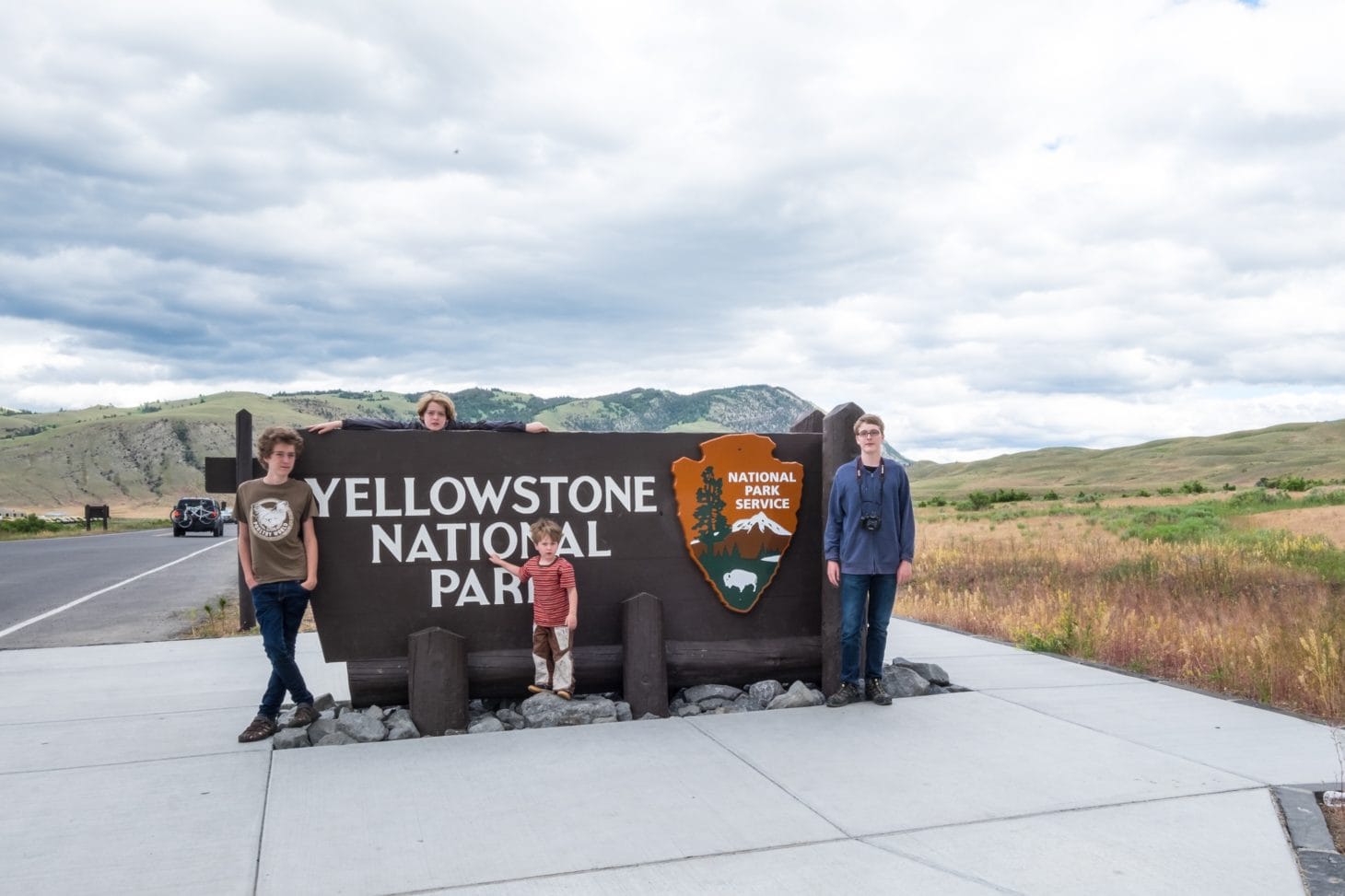
If you only have a couple of days as part of a longer trip, you can still enjoy some of the sights and get a taste of the park. Pick just a few highlights, and leave wanting more. However long your trip, keep in mind that traffic—often caused by bison or bear jams or by road construction—is very common. Make sure you have the right gear to enjoy the park in all temperatures as Yellowstone’s weather can be temperamental at any time of year.
If you’re looking to beat the crowds in Yellowstone National Park, rainy days can often bring a rare break from crowds at popular sights, so take advantage of them. Always get an early start to your day. Historically, the park is most crowded in July and August, so planning a trip outside of peak months will also yield fewer crowds.
Getting to Yellowstone National Park in an RV
Yellowstone National Park is larger than the state of Rhode Island, and your experience will vary depending on which direction you’re entering the park from.
Yellowstone has five entrance gates: north, south, west, east, and northeast. The biggest challenge for most people in getting to Yellowstone in an RV is figuring out which route to take coming through the mountains from the east, which can be a difficult entrance for RVers. Your three main options are U.S. highways 14, 14A, and 16. The conventional wisdom is that Route 14 is scary in an RV, Route 14A is terrifying, and Route 16 is reasonable. U.S. Route 16 is a well-maintained road with wide shoulders, passing lanes, and minimal steep drop-offs. It will still take you up to 9,666 feet at Powder River Pass and back down again via some long grades, so make sure to brush up on your mountain driving skills before attempting this route.
The northeast entrance is perhaps the most dramatic and scenic, but can also be challenging in an RV. The route passes through the Beartooth Mountains on U.S. Route 212, which includes switchbacks and steep mountain grades, so it’s generally not recommended for large rigs.
If you’re arriving from the north, you’ll travel on I-90, which connects to Yellowstone via U.S. Route 89 in Gardiner, Montana. This is the easiest entrance route for RV driving. For those arriving from the west, you’ll enter the park through the West Yellowstone gateway community and then choose either a north or south route. U.S. Route 191 travels north toward Bozeman. If you choose to go south, you’ll travel along U.S. 20 toward I-15, which includes the Targhee Pass—a long up-and-down grade with truck lanes and pull-offs. Both routes are manageable in an RV. Finally, the south entrance connects Yellowstone National Park and Grand Teton National Park via U.S. Route 89. You’ll see plenty of RVs on this scenic route, but pay attention to the grades in the Yellowstone section.
Where to Stay in Yellowstone National Park with an RV
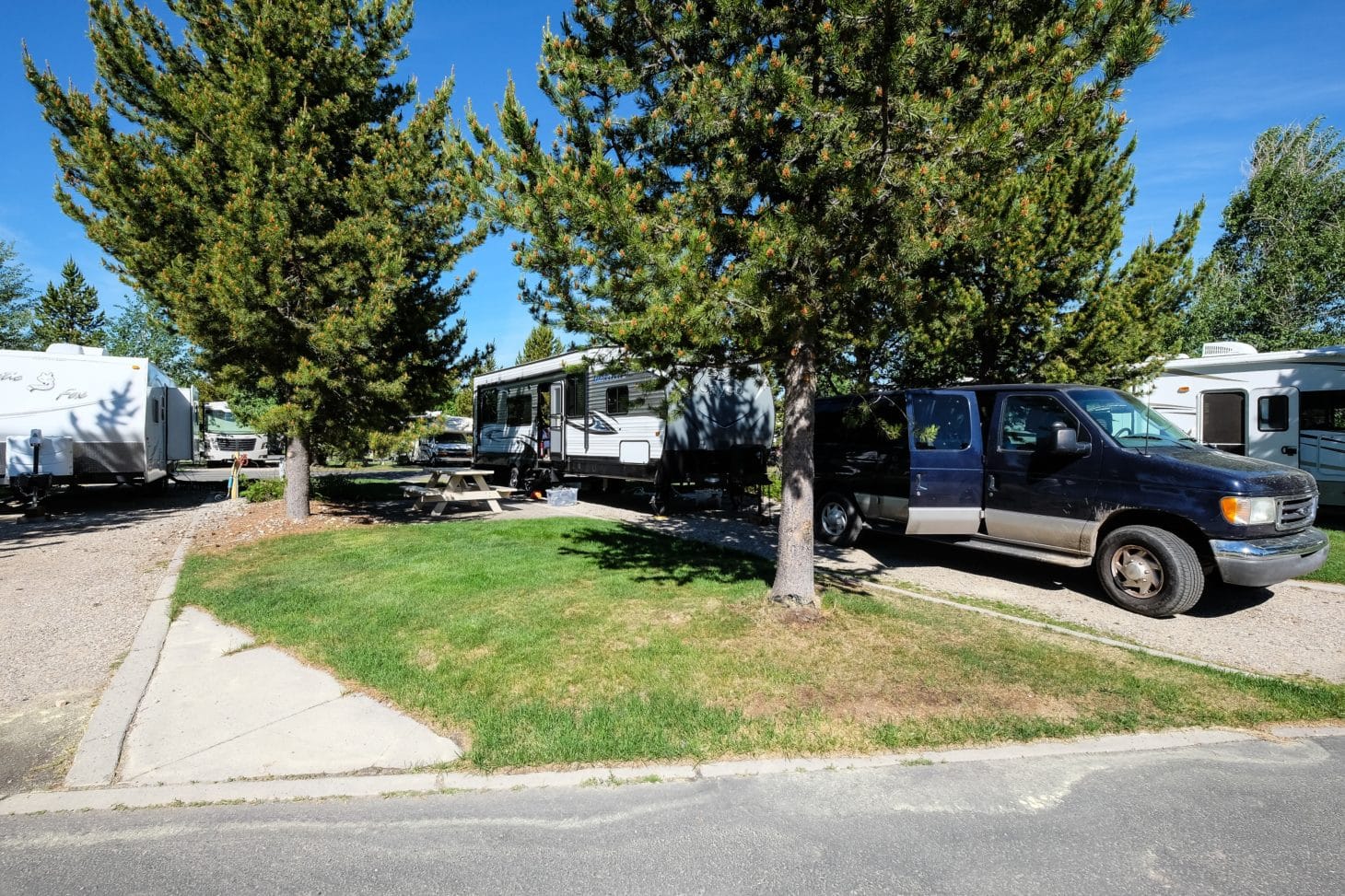
Yellowstone is massive, which means you have plenty of options when it comes to choosing a campground. You may decide on a single base camp to avoid having to pack up halfway through your trip, but that will mean some very long driving days if you want to hit all the highlights. By choosing two different campgrounds throughout the park, you can split the trip into more manageable segments.
Another factor to consider on an RV trip to Yellowstone National Park is whether you want to stay inside or outside of the park. If you have a smaller RV and you’re set up for dry camping, there are several National Park Service campgrounds to choose from. If you need hookups, Fishing Bridge is your only in-park option. Outside the park, look to the small towns of West Yellowstone and Gardiner for campgrounds with hookups.
Fishing Bridge, Wyoming
Fishing Bridge is the only RV park with full hookups that’s actually inside Yellowstone National Park, which is the main reason to stay here. While it’s a bare-bones RV park, visitors note that it has a high price tag for national park standards. As long as you go into your experience with expectations in check, Fishing Bridge is an excellent jumping-off point for exploring close-by sites like Yellowstone Lake and the Grand Canyon of the Yellowstone. NOTE: Fishing Bridge is closed for renovations until the fall of 2021 with hopes that it will reopen with some upgrades.
Yellowstone Grizzly RV Park, Montana
Yellowstone Grizzly , which is located just outside the western park entrance, offers manicured sites and full hookups right in the charming little town of West Yellowstone. The location is within easy walking distance of shops, restaurants, and other attractions like the Grizzly and Wolf Discovery Center.
Mammoth Campground, Wyoming
Mammoth Campground is an in-park option without hookups, look toward the beautiful Mammoth Hot Springs area, which is close to the town of Gardiner, Montana. This corner of the park is a long haul from most of the other popular attractions, so you will most likely encounter fewer crowds here. If you’re looking to visit off-season, it’s also the only campground in the park that’s open year-round. Note that the sites here cannot accommodate RVs longer than 30 feet.
Other Great Campgrounds in Yellowstone National Park
- In West Yellowstone: Yellowstone Park/West Gate KOA , Baker’s Hole Campground (USFS)
- In Gardiner: Rocky Mountain RV Park
- In Yellowstone National Park: Madison Campground , Grant Village Campground
What to Do on a Yellowstone National Park RV Trip
No matter where you go in Yellowstone, you’re bound to see plenty of strange and beautiful sights—the park alone is home to over half of the world’s active geysers, more than 500 in total. But of course, there are some standouts that shouldn’t be missed in this expansive national park.
Old Faithful, Wyoming
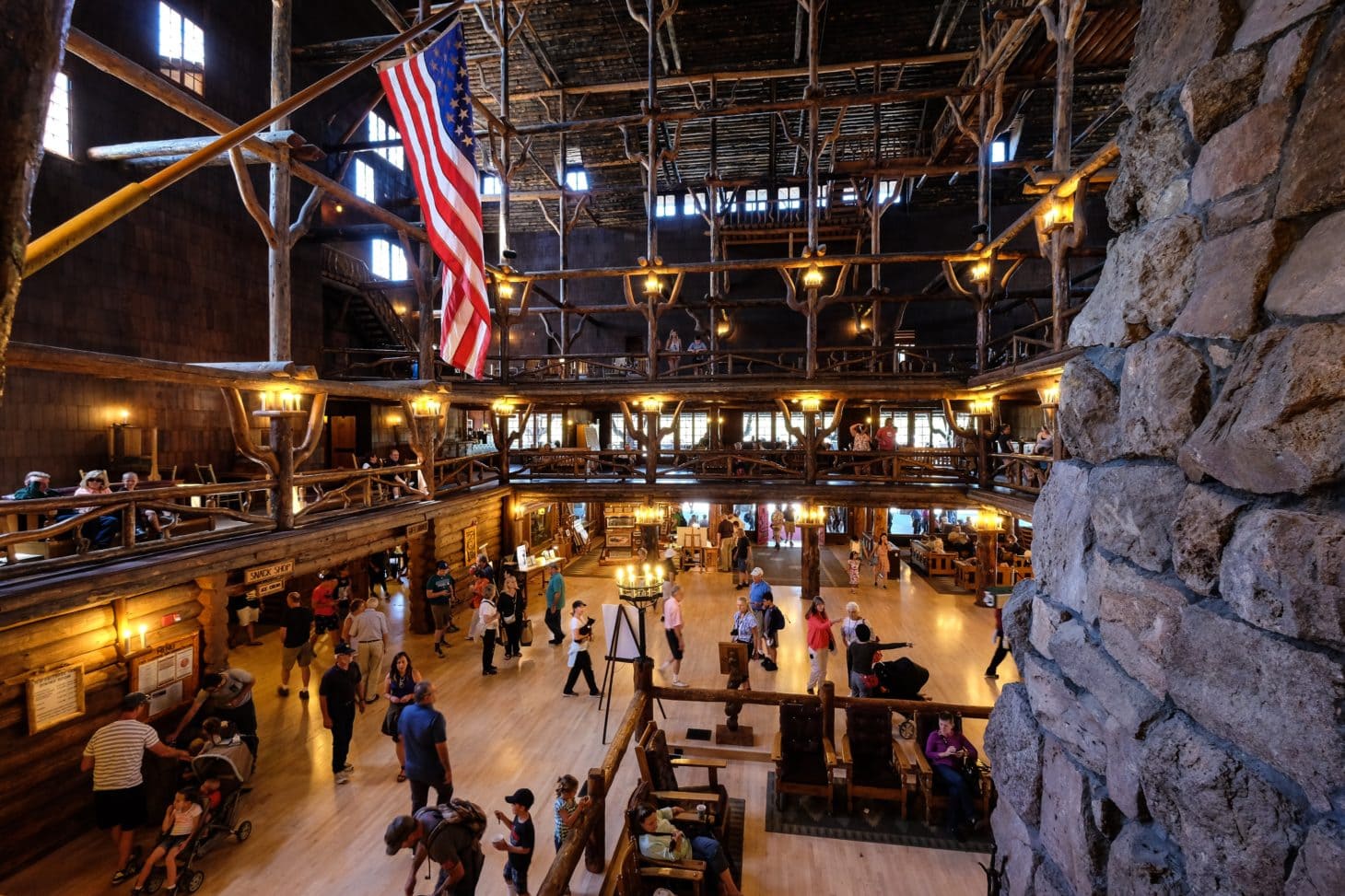
If you only know about one thing in Yellowstone, it’s probably Old Faithful, the geyser that erupts with convenient regularity every 75 minutes or so. It’s not Yellowstone’s most impressive geyser, but it’s by far the easiest to see, both because of the predictable timing and because it’s right outside of the Old Faithful Visitor Center. Due to accessibility, it’s one of the more popular park attractions, so arrive early to beat the crowds. While in the area, make sure to explore the Upper Geyser Basin for even more geysers and other geothermal phenomena. For history buffs, the Old Faithful Inn offers free historic tours of the property, which is an impressive example of early “Parkitecture.”
Related These 20 National Park Service lodges showcase ‘parkitecture’ at its finest
Midway Geyser Basin, Wyoming
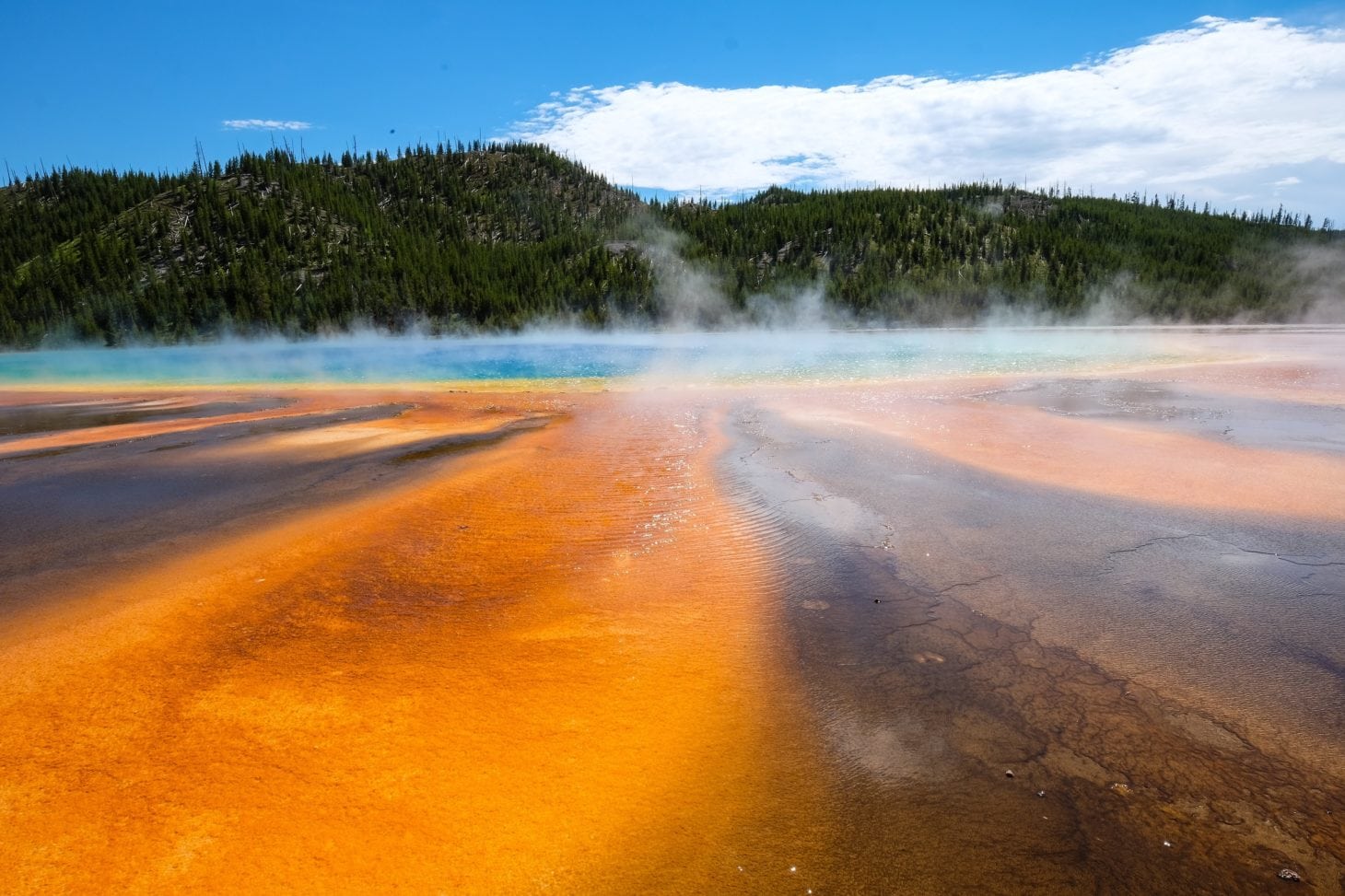
If you continue driving clockwise around the Grand Loop Road, you’ll encounter Midway Geyser Basin just a few minutes away from Old Faithful. Here you’ll find the colorful Grand Prismatic Spring, the third largest hot spring in the world. A short boardwalk takes you past the spring to other thermal features nearby.
Mammoth Hot Springs, Wyoming
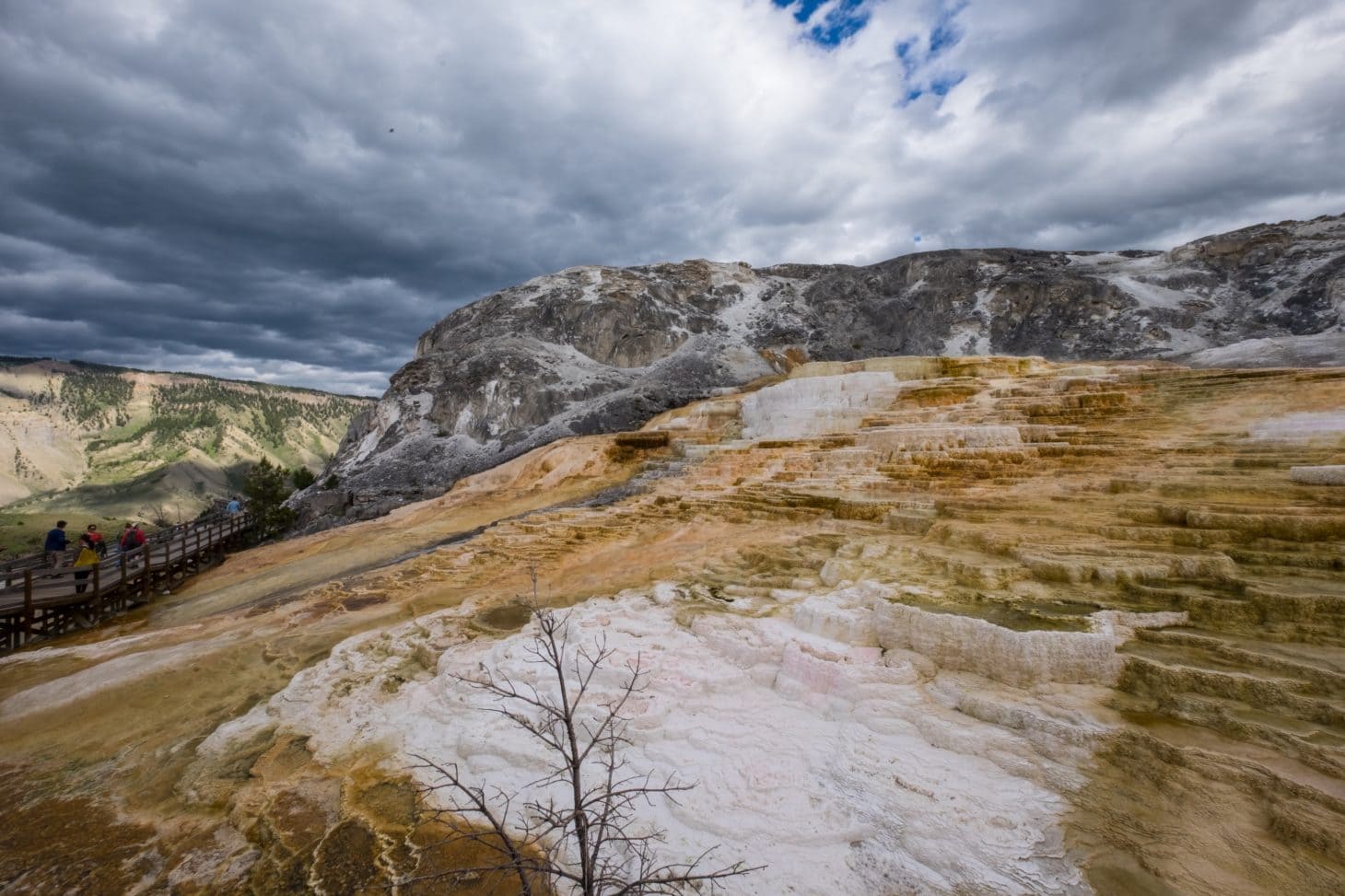
Located in the far northwest corner of the park, Mammoth Hot Springs showcases a completely different landscape from anywhere else in Yellowstone with its steaming travertine terraces. You can get up close to the hydrothermal action via a boardwalk trail that winds through the area. This is also the site of Fort Yellowstone, where U.S. Army soldiers once protected the just-established national park from poachers and developers. It’s an interesting stop for those looking to learn about the park’s early days, as many of the original buildings are still standing. And, while you’re at this end of the park, make sure to visit the north entrance gate and the Roosevelt Arch.
Lamar Valley, Wyoming
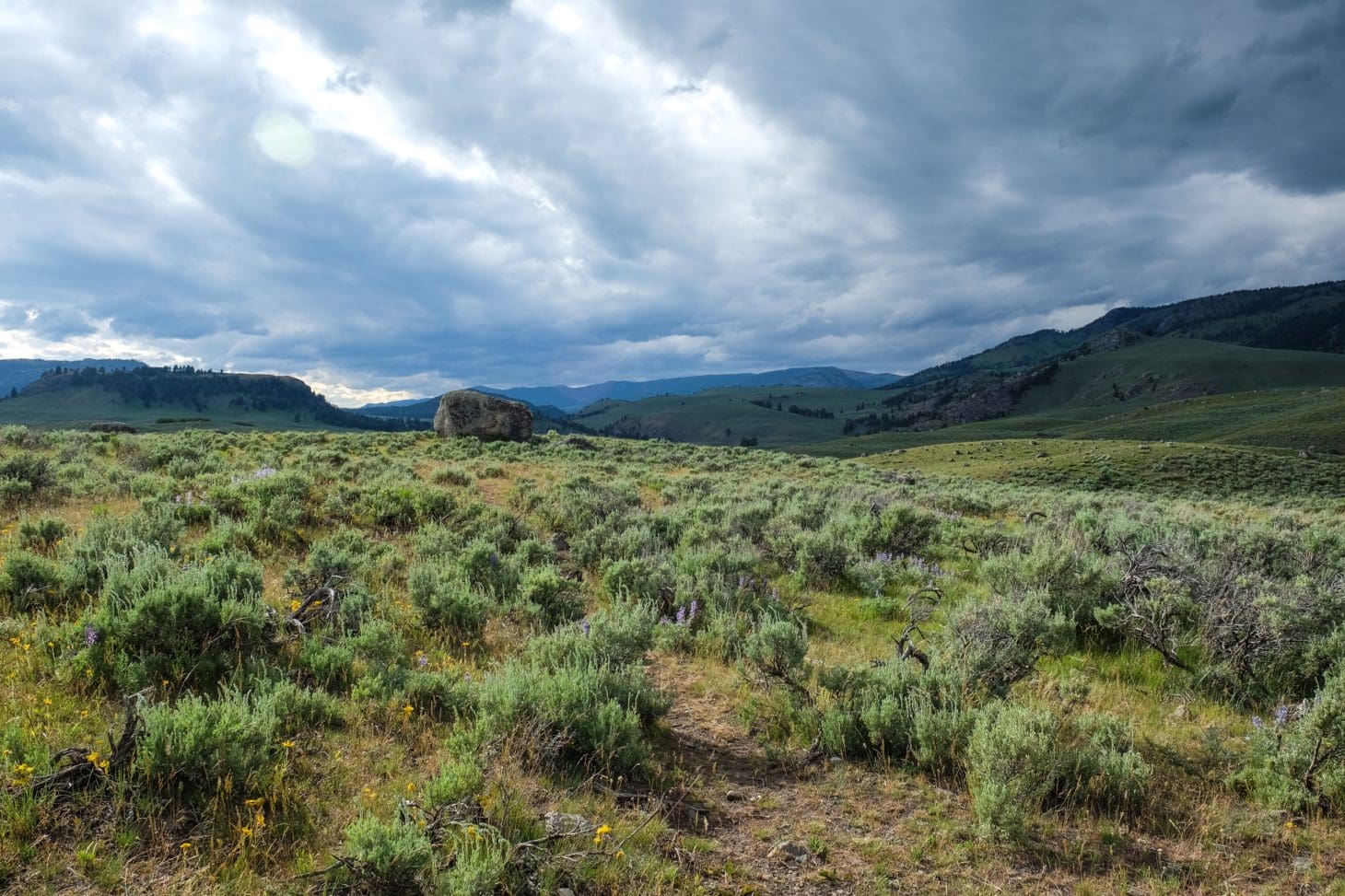
It’s easy to spot bison in Yellowstone as they roam freely all over the park. But the Lamar Valley offers a glimpse of some lesser-seen wildlife, like the 100 or so wolves who live inside the park. Here, you’ll also find the Lamar River Trail, which is a 20-mile out-and-back trail through an area that’s home to unique wildlife and fewer crowds. Don’t feel like you have to hike a marathon though, you’ll be able to enjoy some peace and quiet (and rare animals, if you’re lucky) even just a few miles in.
Grand Canyon of the Yellowstone, Wyoming
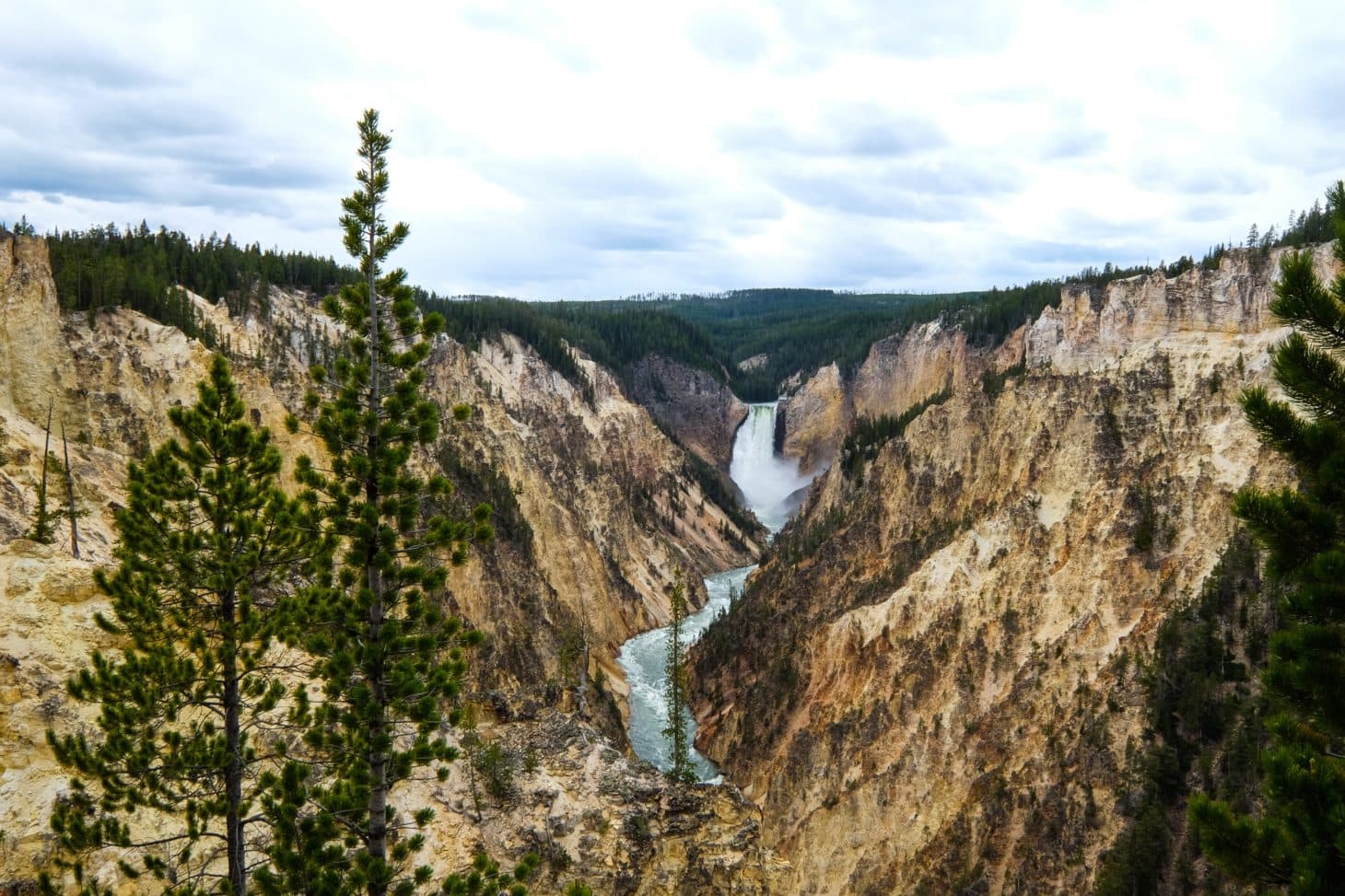
You may recognize the distant view of a waterfall pouring into the 1,000-foot-deep canyon from Artist Point as you approach the gushing falls. Just make sure you drive the North and South Rim roads for the best views. And don’t miss the Canyon Visitor Education Center for exhibits on the supervolcano that’s responsible for Yellowstone’s one-of-a-kind landscape.
Yellowstone Lake and West Thumb Geyser Basin, Wyoming
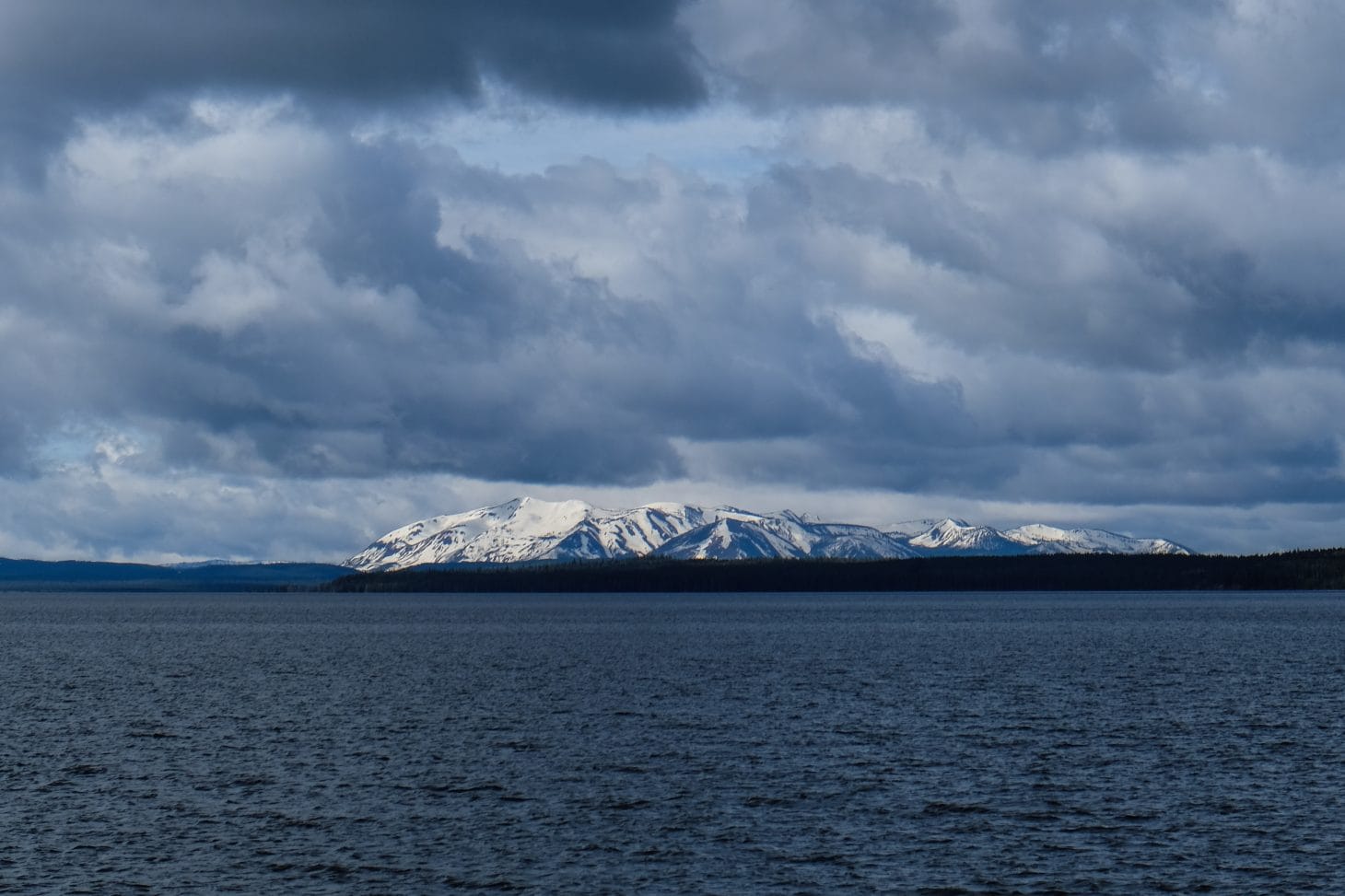
Yellowstone Lake is the largest high-elevation lake in North America, with more than 140 miles of shoreline. Private boats are allowed, but the cold water temperatures and frequent, sudden winds make it suitable only for experienced boaters. A concessionaire offers an hour-long guided tour on an enclosed boat. At West Thumb Geyser Basin, you can walk along the boardwalk and see the lake and geysers at the same time, including at least one geyser that’s actually in the lake.
A trip to Yellowstone should be on every RVers bucket list as there’s really nothing that parallels its history and nature. With some extra planning and a well-devised itinerary, a trip here in an RV can be simple, fun, and sure to wow the whole family.
Related Everything you need to know to plan a national park road trip
Meet the Authors

Gretchen Holcombe
Gretchen is a blogger and homeschooling mom who lives in North Georgia with her husband, four boys, and assorted dogs, cats, and chickens. Her family spends as much time as they can exploring the U.S. and Canada with their Jayco toy hauler and a van called Big Blue. She blogs about their travels at Boxy Colonial on the Road.

Roadtrippers
Roadtrippers helps you find the most epic destinations and detours—from roadside attractions to natural wonders and beyond.
Get the most inspiring stories from the road sent directly to your inbox.

- Trip guides
- Trip Planner
- Sign up Log in Sign out
- Log in Sign out
- ROADTRIPPERS MEMBERSHIP
- RV RESOURCES
Plan your journey, find amazing places, and take fascinating detours with our app.
We couldn't find an existing Roadtrippers account using that service. Please try signing in with another option or create a new account with Roadpass.
We need your email address to send you trip itineraries and other updates.
- Destinations
- United States
Clever Tricks To Visit Yellowstone National Park In The Summer On A Tight Budget
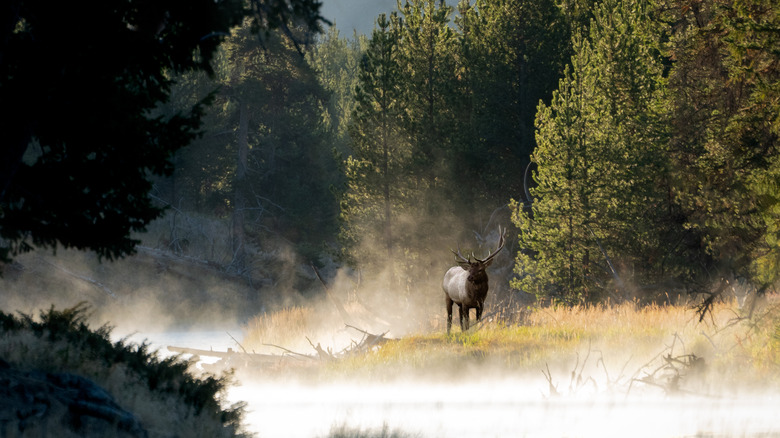
From watching the sunrise over a field where a herd of bison is grazing and admiring shockingly colorful hot springs to hiking along the rim of deep canyons to see rushing waterfalls, Yellowstone National Park has some incredible experiences to offer those who make the journey. Unfortunately, while national parks are supposed to be for everyone, with the cost of flying across the country, the climbing prices of rooms at the park's inns, tours, and dining, this breathtaking park is rapidly becoming too expensive for most Americans to visit. If you're willing to compromise on how you get to the park, rough it in nature when you get there, and do your research in advance, however, you may just be able to swing a trip to this iconic place.
For travelers looking to save money, the best way to do that might be to visit at a time of year when there aren't as many visitors, like December or January. However, for families looking to take their kids when school is out, the busiest months, July and August, might be the only option. You could choose an alternative setting, like Badlands National Park, where you can also see bison roaming free, or Lassen Volcanic National Park, which is like a mini Yellowstone without the crowds , complete with natural steam vents and hot springs. However, if your heart is set on a classic pilgrimage to Yellowstone in the summer, here are some tips and tricks to keep your budget affordable.
Fly to Salt Lake City and drive to Yellowstone
If you're too far from Yellowstone to drive, or can't justify the extra days off from work to have a road trip before and after your vacation, you're going to have to fly. A lot goes into picking the perfect flight for an upcoming vacation, from avoiding long layovers to picking the best seat on the flight so you can get some last minute work done , but have you considered flying into an airport that's farther from your actual destination? It's definitely less convenient than just getting off the plane and being where you want to go, but for destinations like Yellowstone, being willing to travel a little farther once you get off the plane can save you a lot of money.
Yellowstone Airport and Bozeman Yellowstone International Airport are both great choices for getting as close as possible to a park entrance, but if you're feeling overwhelmed by the price tag on your summer vacation, you might want to consider another option: Salt Lake City. If you're leaving from New York City, choosing Salt Lake City might save you almost $200, and more than $500 if you're flying from some international locations. Once you're in Utah you'll have to drive around 5-6 hours to reach Yellowstone, but depending on how much you enjoy road trips, that could be more than worth the savings.
Skip the tours at Yellowstone
There are some amazing tours you can book while you're in Yellowstone, where expert guides will lead you around some of the park's best landmarks and give you the best shot at seeing the most exciting wildlife — but these come at a premium. Many of the most popular tours cost more that $300 per person, with some private tours costing more than $1,000 for a single day. While many of these tours make for a fun trip, you can have incredible experiences in the park without paying for a guide if you take the time to research the best spots to go on your own.
For instance, if you are traveling to Yellowstone in order to see incredible wildlife, you might want to go to Lamar Valley. This broad grassland is home to elk and bison, and sometimes you can even spot wolves there. If you want to see Old Faithful and other exciting geothermal spots, you can hike the Upper Geyser Basin and Old Faithful Observation Point Loop (just make sure you do it safely, especially if this is your first solo hike .)
Consider driving around Yellowstone
You're coming to Yellowstone for scenic hiking, so why do you need a car? Yellowstone National Park is absolutely huge, larger than the entire state of Delaware and its tiny neighbor Rhode Island put together. If you were planning a vacation to these states, you probably wouldn't assume you could walk the entire time, and the same is true of Yellowstone. Unless you only want to stay in a small, specific area of the park, you'll need transportation. The only other real alternatives for anyone who isn't a cycling pro or has months to explore the park on foot is to take a tour bus, and that's pretty expensive. It only costs $35 to bring your car into Yellowstone — just steer clear of reckless road trip mistakes while driving and don't get too distracted looking at the scenery. You can always pull over.
If you live too far away to take your own car, you may have to get a rental, which does add to your budget. Even if you're roadtripping to Yellowstone, however, that might not be a bad monetarily to take a rental car instead of your own vehicle. In one of his road trip hacks, financial expert Clark Howard advises renting a car for most vacations, since adding a lot of mileage to your own car could cost more in the long run.
Camp at Yellowstone
In the past, one of the best ways to visit Yellowstone was to stay in the inns and cabins there, but according to a 2023 report from Montana Free Press , prices at some of those venues had gone up more than 50% since 2018. If you're looking for a more affordable option, try camping. Not only is it an incredible way to experience the natural beauty of the park up close, some of the park's most popular campgrounds cost between $20-40 a night, instead of the $125-475 you could end up paying for a cabin or lodge in August. Before you pack up all the items you need for a quick and easy camping retreat , be aware that you'll need to book around a year in advance to secure one of these coveted spaces.
You might want to choose Slough Creek, which is considered one of the best places to see wild animals like bison, wolves, and bears in their natural habitat near your campsite. If you're looking for more privacy in a crowded park at peak season, try booking Pebble Creek, where there are less than 30 campsites. If you're not a big fan of roughing it outside but are still willing to give camping a shot to save some money, you might want to book Grant Village Campground, which has cell service, laundry, and showers, and is also close to shops and restaurants.
Cook your own meals at your Yellowstone campsite
There are plenty of restaurants to eat at in Yellowstone National Park in summer, and general stores where you can purchase and heat up quick meals — but even if you skip the Mammoth Hotel Dining Room for cheaper options like the Old Faithful Inn Bear Paw Deli, eating out for every meal on your vacation is going to make a serious dent in your budget. If you're going to camp in the park, however, you might as well cook there, too. It's easier than you think.
You should do all your grocery shopping at a regular supermarket before you arrive at the park, and prioritize snacks and meal choices that don't need to be kept colder than a cooler can handle. You definitely can live off of sandwiches and fruit, but if you prep your meals in advance or buy easy meal components pre-marinated meats and pre-made pastas, all you'll need to do is rev up your camp stove and your favorite portable grill , and you can eat well for the same money you'd be spending at home. Just don't bring your own firewood to the campsite .
Recommended

Your ultimate guide to visiting a National Park for the first time
These essentials will make your National Park visit a breeze.

Updated May 14, 2024
Recommendations are independently chosen by Reviewed's editors. Purchases made through the links below may earn us and our publishing partners a commission.
Whether you're headed to the extreme heat of Death Valley or the mountains of Glacier, these packing essentials will help you be ready for your National Park excursion, even as a first-timer.
Sign up for our newsletter.
Enter your email:
Thanks for signing up.
Your national park checklist .
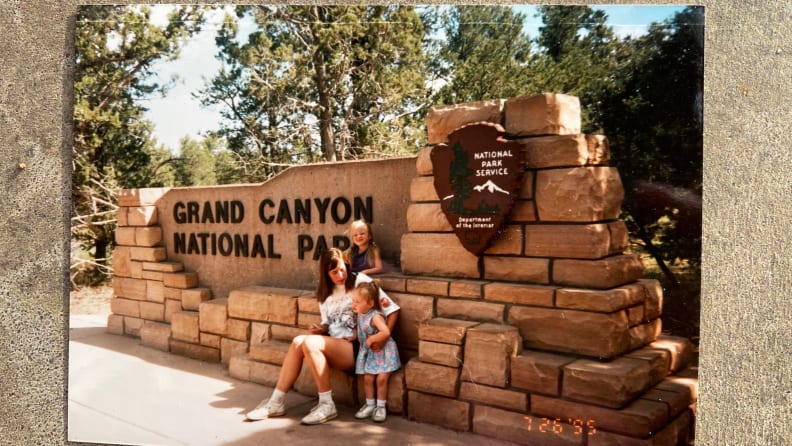
My mom keeps a close eye on me and my cousin Emily while at Grand Canyon National Park.
Buying an America the Beautiful Pass
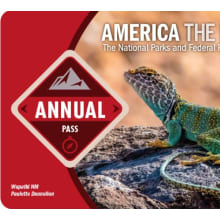
National Parks are a great way to get fresh air, get away from screens, and experience the beauty of nature. Get your annual pass from REI.
Protection from the elements
Speaking of rain, every park has different weather to consider. Look up the weather patterns for the time period you'll be there and plan accordingly.

Look for environmentally friendly sunscreens for your park visit. The Haruharu Wonder Daily Sunscreen is reef safe.

Grab a great sun hat to keep the sun off your head, neck, and face.

Stay dry with this lightweight rain jacket.

Keep yourself bug bite free with this insect spray.
Comfortable and fast-drying clothes and shoes

These fast-drying wool socks are perfect for hiking in any weather and will keep water and sweat from lingering.

These pants can convert from pants to shorts, making them perfect for parks with extreme temperature and weather changes.

Comfortable walking sneakers like these are a must for any amount of walking in parks.

You will not need thermal clothing for every park, particularly if you won’t be camping or hiking. If you are though, thermal underwear is perfect for colder parks and prolonged time outdoors.
Ways to keep your devices charged
It may seem counterintuitive to focus on charging electronics when you're off to your first National Park. After all, one of the best things about them is how easy it is to disconnect from our digital, fast-paced world, slow down, and really enjoy the natural world around you. However, for most of us these days, our camera is the same as our phone, and these moments will definitely be ones you don't want to forget.

Charge your phone while you’re on the road with this plug-in charger.

This portable battery pack lets you charge your phone anywhere.
Maps and guidebooks for when your devices stop working
Note that at nearly every park, the ranger at the entrance will offer you a map. Yes, paper maps still exist, and you should hang onto it! They're free and call attention to the must-see features of the park while helping you avoid getting lost. The visitor center is also a great safe place should you get lost or lose your devices. You can get maps of individual trails there and ask park rangers for advice about the best places to go.

If you want to see the map ahead of time, the National Geographic illustrated maps are a great way to plan your routes.

Grab a trail guide from the ones who know the trails best—the parks themselves.
A first aid kit
When hiking or camping, always have some type of first aid on you. Ideally, you'll never need it, but it's one of those situations where being over-prepared will always be better than being under-prepared. If you don't have room in your pack (but you should!) or will be close enough to populated areas, even just tucking a few Band-Aids and some disinfectant into your pocket can be a good compromise.

This 330-piece first aid kit is comprehensive and perfect for the car or campsite.

Bring first aid on hikes easily with this mini, crush-resistant travel kit.
A backpack to carry it all

A lightweight, waterproof backpack is a great way to store all your stuff.

For serious hiking, a backpack like Loowoko can help you carry everything you need.
Snacks and drinks
There aren't very many places (or any places, depending on the park) to buy food or drinks within a National Park. Because of this, it's essential to plan your meals and snacks so that you always have a way to stay fed and happy.
There are, however, plenty of places in the park to fill up a water bottle and stay hydrated so a refillable water bottle is a must. A cooler is also a good idea (there are places in most parks to buy ice near campgrounds and visitor areas). Just be sure to know whether bears are a factor with the park you're headed to. If they are, take the appropriate precautions.

This collapsible, leak proof, insulated cooler is convenient for hiking or road trips.

Keep your food and drinks cool with this bear-proof cooler.

Staying hydrated is a must in any park, particularly when doing physical activities like hiking.
Hiking gear

For serious hikers, a solid pair of durable, waterproof hiking boots will help you stay comfortable and safe on the trails.

This plastic whistle is a reliable way to draw attention in an emergency no matter the weather.

These lightweight trekking poles are a great way to keep your balance on any terrain.
Camping gear

This flashlight can convert to a lantern and even charge your phone in an emergency.

Having a reliable, waterproof, easy to set up tent should always be a priority while camping.

Sleeping bags are a classic for a reason—they’re compact, cheap, and work for most weather.
What are National Parks?
Can you bring pets to national parks .
That said, pets are only allowed in certain areas of some parks. Generally, if it is a developed area (think roads, paved walkways, buildings) they're okay to be outside with you walking around. However, not all park buildings allow pets and many trails do not allow pets for their safety and yours.
Keep a close eye on your pet for their safety and yours

A leash is a must for any pet that is traveling to a park with you.

Always have a poop bag handy with a reusable dispenser that can attach to your leash.

Smaller pets can travel in backpack-style carriers—just be sure they have proper ventilation.
Hydration matters just as much for them as for you
Be sure to plan for how your pet will stay hydrated just as you will. For hikes, it can be useful to carry a larger water jug that you can use to refill your water bottle and your pet's bowl.

This water bottle comes with an attachment that will work as a bowl in a pinch for most dogs.

These lightweight water bowls fold flat to make them easy to pack for any hike.
Related content
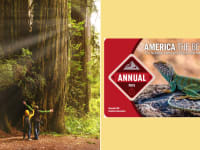
Prices were accurate at the time this article was published but may change over time.
Tired of overcrowded national parks? Here’s how to go backcountry camping.
How to dig a toilet and other essential lessons for backcountry camping.

Everyone seems to be a camper these days, including folks who once feigned an allergy to nature.
According to recreation.gov , which handles reservations for nine federal agencies, the number of camping reservations increased from 2.72 million in 2019 to 4.14 million last year. For this summer, 143 campground facilities are sold out from June through August, and another 232 campgrounds are at capacity for a least one peak month.
If your version of the outdoors does not include trunk-slamming car campers and wheezing RVs, then you need to venture deeper into the wild.
“Backcountry camping is an opportunity to connect more with the wilderness, to have a little more solitude and to get away from cellphone service,” said Sarah Martin, Rocky Mountain director of the National Outdoor Leadership School .
Not surprisingly, wilderness or backcountry camping has also grown in popularity. Recreation.gov issued 371,000 permits last year, compared with 188,000 in 2019. Due to demand, the number of permit facilities has jumped from 38 in 2019 to 81 this year. However, the rigors of backpacking without standard services work as a filter; only the heartiest apply.
“Nobody is responsible for taking care of you, for cleaning up after you, for making sure that you put out your fire,” said Andrea Ference , an experienced backcountry camper based in the Canadian Rockies. “It is more self-reliant camping than traditional front-country camping.”
For first-timers, backcountry camping might seem intimidating. But with the right tools, digging a latrine and sleeping far from civilization can become second nature.
What is backcountry camping?
The National Park Service defines the category as “one or more primitive or wilderness areas which are reached primarily by hiking, boating, or horseback.”
The agency emphasizes that a developed campground on a remote parcel of land, such as Isle Royale National Park in Michigan, does not qualify. The campsites fall into one of three categories: designated, designated-dispersed and dispersed , the most rugged option.
Backcountry camping is available on public lands in a range of environments, such as mountains, deserts and wetlands. The parks distinguish the backcountry from the more established hiking and camping areas.
For example, Shenandoah National Park in Virginia boasts more than 196,000 acres of backcountry and wilderness. Denali National Park in Alaska divides its 6 million acres into 87 backcountry units covering thousands of acres each. In Everglades National Park, the 1.4 million-acre Marjory Stoneman Douglas Wilderness is the largest subtropical wilderness in the country.
Though backcountry campers carry all of their gear and basically fend for themselves, the activity has a few guardrails. Many parks will map out routes and designate campsites for backcountry campers. You might even share trails with day-trippers or less ambitious campers. But in the wilder spots, you will be alone. Well, not entirely alone.
Purchase your permit
Many parks require backcountry campers to acquire a permit during peak times or year-round. Purchase it as soon as possible. The number of spaces is capped, and demand can be high.
“Gaining access to the permit has become a much bigger hurdle, especially since the pandemic,” said Ference, who has camped in about 20 national parks. “If you don’t have a permit in advance, there’s almost a zero-percent chance that you’ll be able to go backcountry camping, especially within a national park.”
The booking systems vary by park.
- Mount Margaret in Mount St. Helens National Volcanic Monument opens reservations to the Washington state lands the first day of a month before the month of your reservation.
- Santa Rosa Island in Channel Islands National Park uses a six-month rolling system. On May 9, the California park started releasing permits for its Aug. 15 through Nov. 9 camping season.
- Yellowstone National Park , which maintains roughly 300 backcountry campsites, offers an early-access lottery, a general sale period and walk-up permits two days before your trip.
When purchasing a permit, note any restrictions, such as length of stay, group size, open fires and pets. Also check the reservation policy. You can often cancel a few days before your booking and receive a partial refund. (Unless you’re Yosemite and keep the entire $15.)
Test equipment
For a backcountry camping trip, you don’t need to train with the same intensity as a marathon. Frequent neighborhood walkabouts in your hiking boots and pack will suffice.
“The biggest part of physical training is just time on your feet. Go on long walks and break in your gear,” Ference said. “The worst thing you can do is head out on the trails with a pair of brand-new hiking boots.”
If you purchased gear for your adventure, Ference recommends camping out in your yard for a night. This way, you can familiarize yourself with your equipment, work out any kinks and identify any ill-conceived items. On a test run, Ference discovered that her sleeping pad did not fit inside her one-person tent.
Campers not ready to invest in gear can rent a variety of items from REI . Inventory varies by store, but some common objects include sleeping bags, tents, propane stoves, trekking poles and bear canisters.
Bring only essentials
Before packing your rucksack, determine whether the campsite offers any amenities. The perk might be minor, such as an animal-proof food container, but it’s one less thing you’ll have to lug.
At Mammoth Cave National Park in Kentucky, for example, the sites come with campfire rings and tent pads. Yellowstone provides bear-resistant food boxes or storage poles (35-foot rope not included). Sylvania Wilderness camping in Michigan’s Ottawa National Forest has pit latrines.
Many national parks and outdoor outfitters provide checklists. (Check backcountry.com . ) NPS spokesman Dave Barak shared some of his essential items:
- Navigational supplies, such as maps, a GPS unit and a compass.
- Sun and insect protection.
- Extra clothing for insulation.
- A light source, such as a headlamp and flashlight.
- A first-aid kit.
- Fire starter.
- Extra food and water.
- A repair kit and tools.
- A communication device that is more reliable than a cellphone, such as a personal locator beacon or a satellite phone.
Ference brings a camping pillow, her one little luxury, and dehydrated meals, which she swears are tasty.
“The backpacking meals they make these days are shockingly delicious,” she said. “They are also made for the activity that you’re doing. So, it has a really high sodium content, because you’re sweating all day.”
As your camping skills advance, so can your cooking. If you carry a pot or pan, choose the nonstick kind, because cleaning burned, dehydrated eggs is a thankless chore.
To calculate your food quantity, take into account the activity level, weather and weight you are carrying. NOLS recommends 1 to 1.5 pounds of food (2,000-3,000 calories) per day for a short, leisurely trip in mild temperatures. For a more strenuous outing, increase your supply to 1.75 to 2 pounds, or 3,000 to 3,500 calories.
For drinking water, Martin plots out routes with natural water features, such as rivers and lakes in the mountains and springs in the desert. She uses chlorine tablets called Aquamira to purify the water. To rinse off before bed, she carries a hanging shower bag and a small bottle of Dr. Bronner’s biodegradable soap.
“It keeps me feeling more like a human and less like a wild animal,” she said.
Martin reminds campers to keep at least 200 feet away (or 70 paces) from a water source, to avoid contamination.
Find a campsite
If your permit includes a designated campsite, then you can stop there. If you are in charge of scouting out a site, location is critical.
The Park Service advises against ledges, high peaks and the middle of a field, which can be a vulnerable spot in high winds or lightning storms. Also avoid setting up camp under dead branches, which could crash down on your tent. Stay away from ravines that might flood.
Stake your tent at least 200 feet away from any trails and natural water sources. Ditto for your toilet and food storage and cooking area, especially in bear country.
Dig a toilet
When constructing a latrine, dig a hole at least eight inches deep. Martin said most people bury their toilet paper, but she said the product does not always quickly decompose.
“We cannot count on toilet paper to break down season after season. It just takes a lot longer than we think,” she said. “I think any sort of human products that we use in the backcountry need to be packed out.”
To reduce the ick factor, she said some people store the used toilet paper in empty coffee bags, so the coffee scent masks the less pleasant odors. If you use a plastic zip-top bag, she recommends covering it with duct tape.
“You don’t need to look at what’s in that trash bag,” Martin said.
More travel tips
Vacation planning: Start with a strategy to maximize days off by taking PTO around holidays. Experts recommend taking multiple short trips for peak happiness . Want to take an ambitious trip? Here are 12 destinations to try this year — without crowds.
Cheap flights: Follow our best advice for scoring low airfare , including setting flight price alerts and subscribing to deal newsletters. If you’re set on an expensive getaway, here’s a plan to save up without straining your credit limit.
Airport chaos: We’ve got advice for every scenario , from canceled flights to lost luggage . Stuck at the rental car counter? These tips can speed up the process. And following these 52 rules of flying should make the experience better for everyone.
Expert advice: Our By The Way Concierge solves readers’ dilemmas , including whether it’s okay to ditch a partner at security, or what happens if you get caught flying with weed . Submit your question here . Or you could look to the gurus: Lonely Planet and Rick Steves .

This Is Known As The Most Beautiful Highway In The U.S.
For those traveling to Yellowstone National Park, taking Beartooth Highway is the most amazing way to see all the beauty in the region.
- Beartooth Highway is known as the most beautiful highway in the US due to its diverse landscapes, from forests to glaciers.
- The highway passes through three national forests - Custer, Shoshone, and Gallatin - offering stunning views and natural beauty.
- Beartooth Highway is only open seasonally, from Memorial Day weekend to mid-October, so plan your trip carefully to avoid closures.
One of the best things about traveling to the national parks and national forests in the US is the roads on the way to explore them. From the different landscapes, the flora and fauna, and the elevation changes, there are views that go on for miles.
While many of the roads in these remote areas allow visitors to see some of the most untouched landscapes in the nation, there is only one that is known as the most beautiful highway in the US. To not only have gotten this title, but to have kept it for decades, not only speaks to the conservation of the area the highway runs through but also the respect that visitors give it who drive on the highway.
You might have even driven this highway without realizing it's one of the best-kept secrets in Wyoming . But after taking in the views, seeing the changes in the landscape in a matter of minutes, and even glaciers, it is clear why Beartooth Highway is the most beautiful piece of roadway in the nation.
This Least Populated Wyoming Town Is Home To Beautiful Attractions
Beartooth highway is the most beautiful highway in the us, beartooth highway allows for views of thick forests, arctic tundra, and glaciers while en route to yellowstone national park.
Beartooth Highway, also known as Highway 212, is a 68-mile stretch of highway that runs from Custer National Forest to Yellowstone National Park . Completed in 1936, the highway was deemed necessary after cars were becoming all the rage to take families to national parks throughout the nation.
The original road to get to Yellowstone was becoming too crowded and a new roadway needed to be built to accommodate visitors. Thus, Beartooth Highway was born.
Those who drive Beartooth Highway versus hiking the Beartooth Mountains will be taken through three distinct forest ranges along the journey to Yellowstone. As the elevation changes, the rugged beauty is on display as thick forests are replaced by more sparse tundra. Waterfalls can be seen from pullouts, and the Yellowstone River is clearly on display.
Even glaciers can be viewed the higher the elevation goes, giving those on the highway an idea of what the area looked like centuries ago, given that the landscape has been virtually untouched due to its remoteness.
What is interesting about Beartooth Highway is that, in conjunction with having the title of "The Most Beautiful Highway," it is also called the "Orphaned Highway" because, since the highway was completed, three sections of the roadway remain unclaimed by any state or federal entity.
As a result of the continued battle over jurisdiction and lack of funds to make proper repairs on Beartooth Highway, overlays have been done to areas on the roadway that need repair.
Given that the highway is already semi-treacherous with its narrow roadways and few pullouts on its nearly 70 miles of roadway, discussions have always been in earnest to determine who should have the responsibility of caring for portions of highway that are nearest to Yellowstone in Montana and sections of the highway in Wyoming that are essentially in the middle of nowhere.
However, with no one being able to take responsibility without funding being given, the roadways receive minimal repairs that will leave the Alpine roadway impassible over time.
14 Things To Do In Billings: Complete Guide To The City On The Yellowstone
Beartooth highway travels through three distinctly different national forests, during the 68-mile journey on beartooth highway, custer, shoshone, and gallatin national forests are traveled through.
Visitors who take Beartooth Highway on their way to Yellowstone are in for a high-country adventure like no other. This is because, during their journey, they will pass through some of the most diverse forest lands found in the nation.
Custer National Forest
Custer National Forest is also known as the gateway to Yellowstone. The forest covers 3.1 million acres throughout Montana and even into South Dakota. The ecosystem at Custer National Forest is one of the most diverse in the US.
This is because there are lush grasslands, thick forests, and glaciers to enjoy, many of which can be seen while driving on Beartooth Highway. Specifically, Granite Peak, at 12,799 feet , is considered one of the toughest hikes to complete in the US.
Shoshone National Forest
Shoshone National Forest was named the first national forest in the US . The forest covers 2.4 million acres, 1.4 million of which are integrated into Yellowstone National Park.
With its rugged mountain views, plateaus perfect for being able to see for miles, wildflower grasslands, and glaciers, there is much to see from Shoshone while traveling along Beartooth Highway.
Gallatin National Forest
Gallatin National Forest also makes up a portion of Yellowstone National Park. Located in Montana's Northern Rockies, the 1.8 million acres of forestland covers six mountain ranges that can all be enjoyed on Beartooth Highway. It is not uncommon to see snow on the mountains throughout the summer while driving on the highway.
With the diversity in these three different national forests, it is clear why Beartooth is one of the most beautiful highways in the US .
Montana's Most Scenic: 10 Mountain Ranges Worth Seeing In Your Lifetime
Beartooth highway offers seasonal passage, so plan accordingly, due to snow, beartooth highway is only open from memorial day weekend through mid-october.
Beartooth Highway is a seasonal highway. Those who want to travel to see the beauty of the region need to plan accordingly.
The official yearly opening of Beartooth Highway happens on Memorial Day Weekend every year. The highway remains open through mid-October . However, depending on when the snow begins to come to the region, the highway may close earlier.
For those who take to Beartooth in May, it is not uncommon to see walls of snow on either side of the highway. This is because there is no other place to put the snow, which can cause some drivers to feel a bit uneasy. But as long as those driving are paying attention and take the road at a safe pace, they will be fine.
While snow is present throughout the summer, during the fall, Beartooth Highway also provides a scenic road trip to explore fall foliage . Once the roadway opens, it is not uncommon for there to be several drivers on the highway at one time.
It should also be noted that it is not unheard of for the roadway to close during the summer months because storms bring in snow or ice. Road conditions should be constantly monitored so that plans to travel on Beartooth Highway do not have to be unexpectedly canceled mid-vacation.
- Skip to global NPS navigation
- Skip to this park navigation
- Skip to the main content
- Skip to this park information section
- Skip to the footer section

Exiting nps.gov
Alerts in effect, park footer, contact info, mailing address:.
PO Box 168 Yellowstone National Park, WY 82190-0168
307-344-7381
Stay Connected

National Parks Traveler
Climate change and the parks
National Park Travel
Help power the National Parks Traveler’s coverage of national parks and protected areas.
You are here
South entrance to yellowstone national park expected to open friday.
The South Entrance to Yellowstone National Park is expected to open Friday/NPS file
Barring a snowstorm, the South Entrance to Yellowstone National Park will open Friday at 8 a.m. local time.
According to the National Park Service, t he following roads in Yellowstone will open 8 a.m. Friday to public motor vehicle traffic as long as the weather allows:
- South Entrance to West Thumb
- West Thumb to Old Faithful (Craig Pass)
- West Thumb to Lake Village
- Tower-Roosevelt to Tower Fall
The public is asked to:
- Watch for quickly changing weather conditions and possible temporary closures due to late spring storms. Many areas of the park are still experiencing winter conditions, and snow and ice may cover sections of road.
- Visit Park Roads .
- Call (307) 344-2117 for recorded information.
- Receive Yellowstone road alerts on your mobile phone by texting "82190" to 888-777 (an automatic text reply will confirm receipt and provide instructions).
- Come prepared. Services in the spring are limited. Visit Operating Dates for area-specific season opening dates.
- Bison, elk, bears, and other wildlife use roads as travel corridors. Roadside snowbanks prevent them from easily moving off the roads. Do not crowd, harass or push wildlife. Be mindful as wildlife endure this difficult time of the year.
- Stay at least 100 yards away from bears and wolves, and 25 yards from all other wildlife. It is your responsibility to maintain safe distances at all times.
Upcoming road opening
- Weather-permitting, the road from Canyon Village to Tower Fall (Dunraven Pass) will open 8 a.m. on May 24.
Find a map of the 2024 park road opening and closing dates here . The only roads open year-round are between the North Entrance in Gardiner, Montana, and the Northeast Entrance in Cooke City/Silver Gate, Montana (via Mammoth Hot Springs, Tower Junction and Lamar Valley). For additional details, visit the park website at www.nps.gov/yell or download the National Park Service App .
- Yellowstone National Park
- Parks in the News
Add comment
This question is for testing whether or not you are a human visitor and to prevent automated spam submissions.
Support Journalism about National Parks!
National parks traveler is a 501(c)(3) nonprofit..
Donate Now!
The Essential RVing Guide

The National Parks RVing Guide , aka the Essential RVing Guide To The National Parks , is the definitive guide for RVers seeking information on campgrounds in the National Park System where they can park their rigs. It's available for free for both iPhones and Android models.
This app is packed with RVing specific details on more than 250 campgrounds in more than 70 parks. You'll also find stories about RVing in the parks, some tips if you've just recently turned into an RVer, and some planning suggestions. A bonus that wasn't in the previous eBook or PDF versions of this guide are feeds of Traveler content: you'll find our latest stories as well as our most recent podcasts just a click away. So whether you have an iPhone or an Android , download this app and start exploring the campgrounds in the National Park System where you can park your rig.
- Skip to global NPS navigation
- Skip to this park navigation
- Skip to the main content
- Skip to this park information section
- Skip to the footer section

Exiting nps.gov
Alerts in effect, trip planning.
Last updated: May 17, 2024
Park footer
Contact info, mailing address:.
1000 US Hwy 36 Estes Park, CO 80517
970 586-1206 The Information Office is open year-round: 8:00 a.m. - 4:00 p.m. daily in summer; 8:00 a.m. - 4:00 p.m. Mondays - Fridays and 8:00 a.m. - 12:00 p.m. Saturdays - Sundays in winter. Recorded Trail Ridge Road status: (970) 586-1222.
Stay Connected

IMAGES
VIDEO
COMMENTS
Preparing For Your Trip. Taking time to plan your visit will make your experience more safe, fun, and rewarding. Select a link for the most accurate and up-to-date information about: Safety. Maps. Fees and Passes. Operating Dates, Seasons, and Services. Park Roads. Goods and Services.
If you choose to drive to Yellowstone National Park, these are some rough distances from major cities or nearby towns: Jackson, WY - 1 hour to the South Entrance. Bozeman, MT - 1.5 hours to North Entrance. Cody, WY - 1.5 hours to East Entrance. Idaho Falls, ID - 2 hours to West Entrance.
Download the official, free NPS app and Yellowstone National Park content to help plan and enrich your trip before you arrive, during your visit, and even after your Yellowstone experience. Park footer. Contact Info Mailing Address: PO Box 168 Yellowstone National Park , WY 82190-0168
Yellowstone National Park, which straddles Wyoming, Montana, and Idaho, is Travel + Leisure readers' favorite national park, and it was the most popular park in 2023 according to Google. So what ...
Below is a map indicating each of the suggested places from our 4-day Yellowstone itinerary. Places indicated in red are the ones described on day 1 of this itinerary, purple - day 2, yellow - day 3, and green - day 4. The blue dots are the places that we mention in the 5-days Yellowstone itinerary further below.
For additional information, download the Yellowstone National Park Trip Planner (pdf) and the Official Park Newspaper. You can also print information in ten different languages including 日本語 (Japanese), 中文 (Chinese), Español, Français, and Deutsch. Visit the official online store for books, maps, and guides to the park. Operated by ...
Planning a trip to Yellowstone National Park can feel like a monumental undertaking. The sheer size of the park alone is enough to make any seasoned planner run for the hills. Before we took our big trip to Yellowstone, I spent a lot of time scouring through different books and sites to craft the perfect Yellowstone itinerary. To save you hours ...
Here's what you need to know to start planning your trip - and for more detail pick up a copy of the Lonely Planet Yellowstone and Grand Teton National Parks travel guide and Yellowstone National Park Planning Map. Editor's note: Due to the COVID-19 pandemic, Yellowstone National Park began a phased reopening on June 1.
Welcome to the Ultimate Yellowstone Trip Planning Guide. Sitting on top of the largest supervolcano on the planet, the features in Yellowstone National Park are almost other-worldly. Steam hisses and roars out of the rocks, and water bubbles and spurts from the ground. Yellowstone made history when it was set aside as the world's first ...
Yellowstone National Park is an extraordinary and unique landscape. After visiting the park in both April and October, we know how challenging but rewarding planning the best Yellowstone National Park itinerary can be. We're going to share all of our knowledge about Yellowstone National Park here, including an amazing 4 days itinerary example.
Hike to Mystic Falls. Mystic Falls in Yellowstone (Photo: Getty Images) Head to the Biscuit Basin trailhead to hike the easy and picturesque trail to Mystic Falls. The 2.4-mile trail starts on the boardwalk through Biscuit Basin where you can see several thermal features before splitting off into the forest.
Come to Yellowstone National Park to see grizzly and black bears, thousands of wild bison, packs of wolves, giant waterfalls and the largest concentration of active geysers on Earth. But before you head to the park, here are a few basic Yellowstone essentials you need to know. Think big. At more than 3,400 square miles, Yellowstone is huge.
Download our free stunning Yellowstone Trip Planner filled with an inspiring itinerary, gorgeous photographs, a park map and everything you need to plan your dream vacation. Order this insider's guide to Yellowstone today to get tips on how to get there, what to do and where to stay. Get even more trip planning information in our email ...
Itinerary Overview. Route Distance: 40 miles (1 Hour) 55 miles (1 Day) 150 miles (2 Days) Suggested Time: 1 Hour, 1 Day, or 2 Days. [OPEN MAP IN NEW WINDOW] FIND MORE ITINERARIES.
Are you planning a trip to Yellowstone National Park? Then, this Ultimate Yellowstone Trip Planning Guide is for you! I'm talking you through everything you ...
The National Park Service has assembled a collection of convenient trip planning guides, now available in 10 different languages! Take a few minutes to read through the trip planner information below to learn more about Yellowstone National Park, including maps, information about transportation, weather, entrance fees, park safety and more.
Planning a trip to Yellowstone National Park. With insider tips from real park rangers. Created in 1872, Yellowstone National Parkis the world's first and one of its most famous national parks. The park's legendary geothermal features, including geysers, hot springs, and bubbling pools, are powered by a slumbering supervolcano that ...
We have the Official Yellowstone National Park Trip Planner, provided by the National Park Service, that along with their map, is available for free at each of the five entrances to the park. You should consider the Trip Planner as a starting point for planning your trip, here's why. Before the internet and all its' devices, your only option ...
An RV trip to Yellowstone generally involves long days with lots of driving and crowds, which can cause exhaustion for even the most seasoned traveler. If you're planning your first RV trip to Yellowstone National Park, you should give yourself at least five or six days, with a planned rest day where you stay close to the campground.
Yellowstone National Park is absolutely huge, larger than the entire state of Delaware and its tiny neighbor Rhode Island put together. If you were planning a vacation to these states, you probably wouldn't assume you could walk the entire time, and the same is true of Yellowstone.
Brochures. Plan your visit using the publications below to familiarize yourself with Yellowstone before you even get here. Below you'll find a list of publications that will help you plan a safe, enjoyable Yellowstone adventure. Most of these publications are in PDF format and can be viewed or printed using Adobe Acrobat and other PDF readers.
The first National Park, Yellowstone, was declared in 1872. Since their introduction, National Parks have become a popular way to spend time with family, friends and yourself, attracting 325.5 million visitors in 2023 alone. Can you bring pets to National Parks? Absolutely! Currently, every National Park allows pets in at least some areas.
Yellowstone National Park, which maintains roughly 300 backcountry campsites, offers an early-access lottery, a general sale period and walk-up permits two days before your trip.
Beartooth Highway, also known as Highway 212, is a 68-mile stretch of highway that runs from Custer National Forest to Yellowstone National Park.Completed in 1936, the highway was deemed necessary after cars were becoming all the rage to take families to national parks throughout the nation.
Whatever the reason, I almost always plan a long weekend in Yellowstone and Grand Teton around October. Time it right and you can park right next to the Old Faithful visitor's center. The snow ...
On March 1, 1872, Yellowstone became the first national park for all to enjoy the unique hydrothermal and geologic features. Within Yellowstone's 2.2 million acres, visitors have unparalleled opportunities to observe wildlife in an intact ecosystem, explore geothermal areas that contain about half the world's active geysers, and view geologic wonders like the Grand Canyon of the Yellowstone ...
Barring a snowstorm, the South Entrance to Yellowstone National Park will open Friday at 8 a.m. local time.. According to the National Park Service, t he following roads in Yellowstone will open 8 a.m. Friday to public motor vehicle traffic as long as the weather allows:. South Entrance to West Thumb; West Thumb to Old Faithful (Craig Pass)
Accidents can happen when recreating in Rocky Mountain National Park, even to the most experienced adventurers. Before setting out on your next trip, take time to make an Outdoor Emergency Plan. Being prepared for an emergency improves your ability to respond to the situation. Modify your plan to meet the needs of every trip.